Anatomy, Physiology & Pharmacology Workbook for RPEL Portfolio
VerifiedAdded on 2023/06/18
|89
|9608
|353
AI Summary
This Anatomy, Physiology and Pharmacology workbook which covers the main learning outcomes from the first year BSc Nursing Programme, needs to be completed and submitted as part of your RPL portfolio. The workbook includes labeling diagrams, multiple choice questions, and short answer questions on cells and tissues, homeostasis, reproductive system, and genetics. It also provides recommended reading materials for further study.
Contribute Materials
Your contribution can guide someone’s learning journey. Share your
documents today.
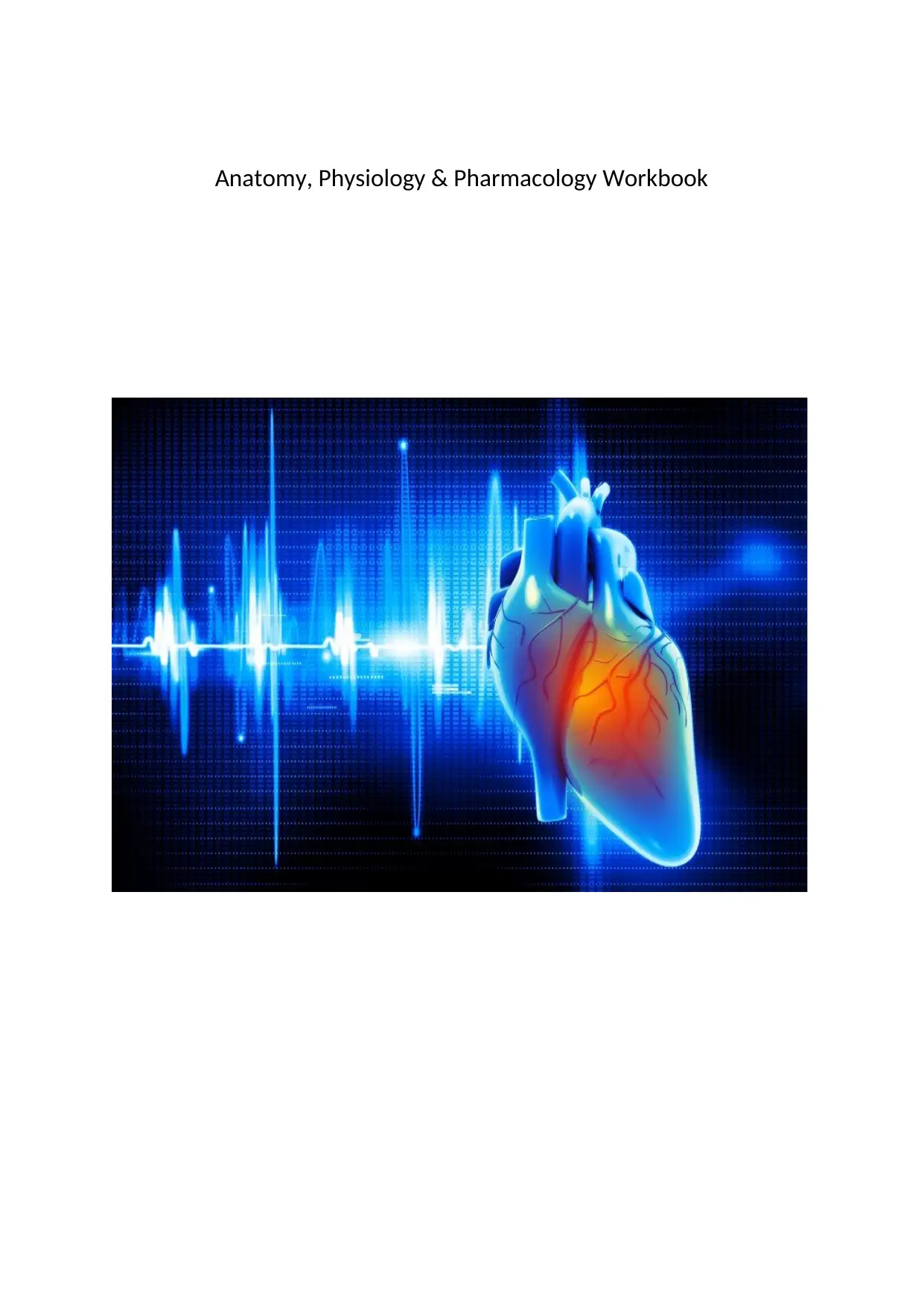
Anatomy, Physiology & Pharmacology Workbook
Secure Best Marks with AI Grader
Need help grading? Try our AI Grader for instant feedback on your assignments.
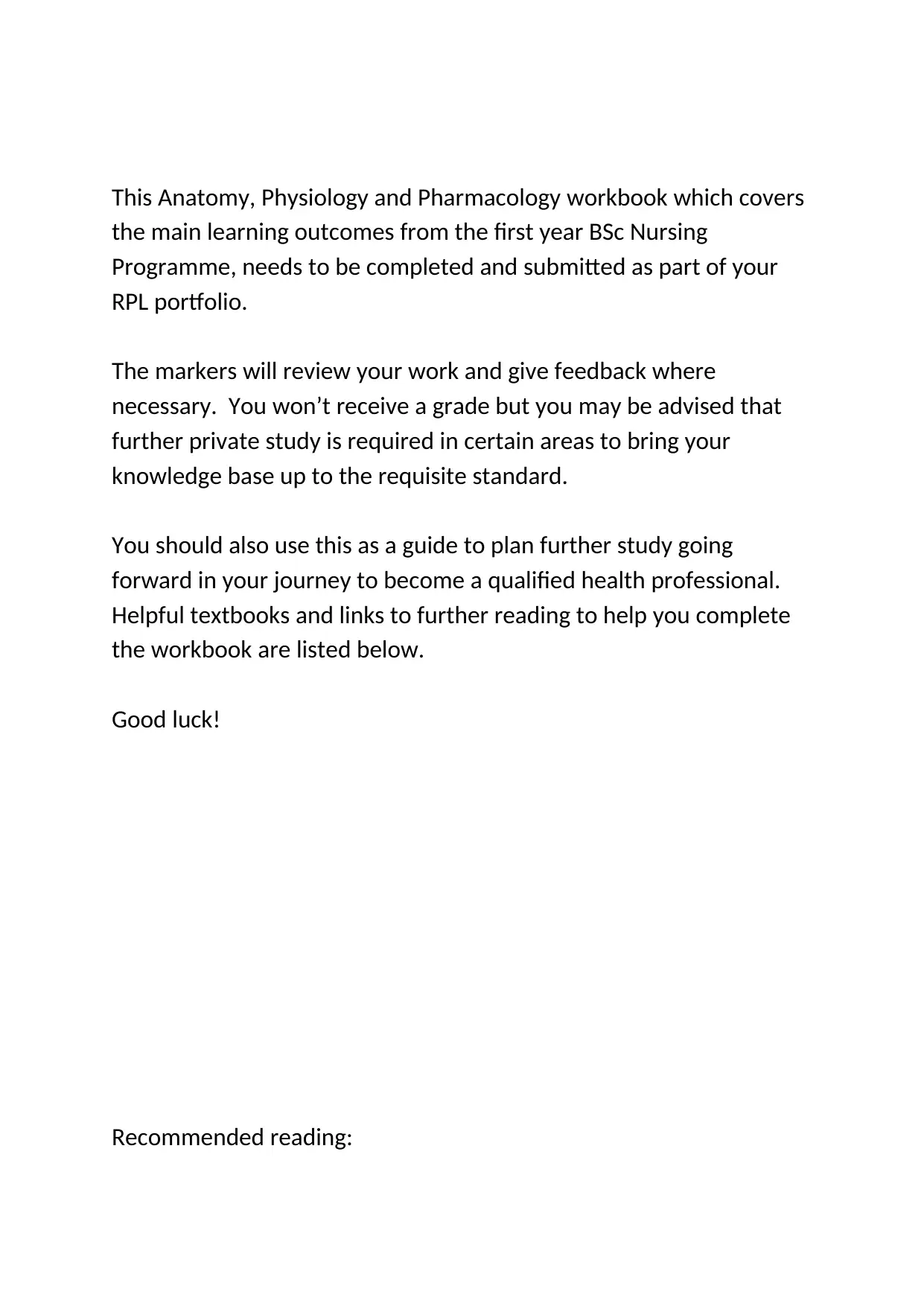
This Anatomy, Physiology and Pharmacology workbook which covers
the main learning outcomes from the first year BSc Nursing
Programme, needs to be completed and submitted as part of your
RPL portfolio.
The markers will review your work and give feedback where
necessary. You won’t receive a grade but you may be advised that
further private study is required in certain areas to bring your
knowledge base up to the requisite standard.
You should also use this as a guide to plan further study going
forward in your journey to become a qualified health professional.
Helpful textbooks and links to further reading to help you complete
the workbook are listed below.
Good luck!
Recommended reading:
the main learning outcomes from the first year BSc Nursing
Programme, needs to be completed and submitted as part of your
RPL portfolio.
The markers will review your work and give feedback where
necessary. You won’t receive a grade but you may be advised that
further private study is required in certain areas to bring your
knowledge base up to the requisite standard.
You should also use this as a guide to plan further study going
forward in your journey to become a qualified health professional.
Helpful textbooks and links to further reading to help you complete
the workbook are listed below.
Good luck!
Recommended reading:
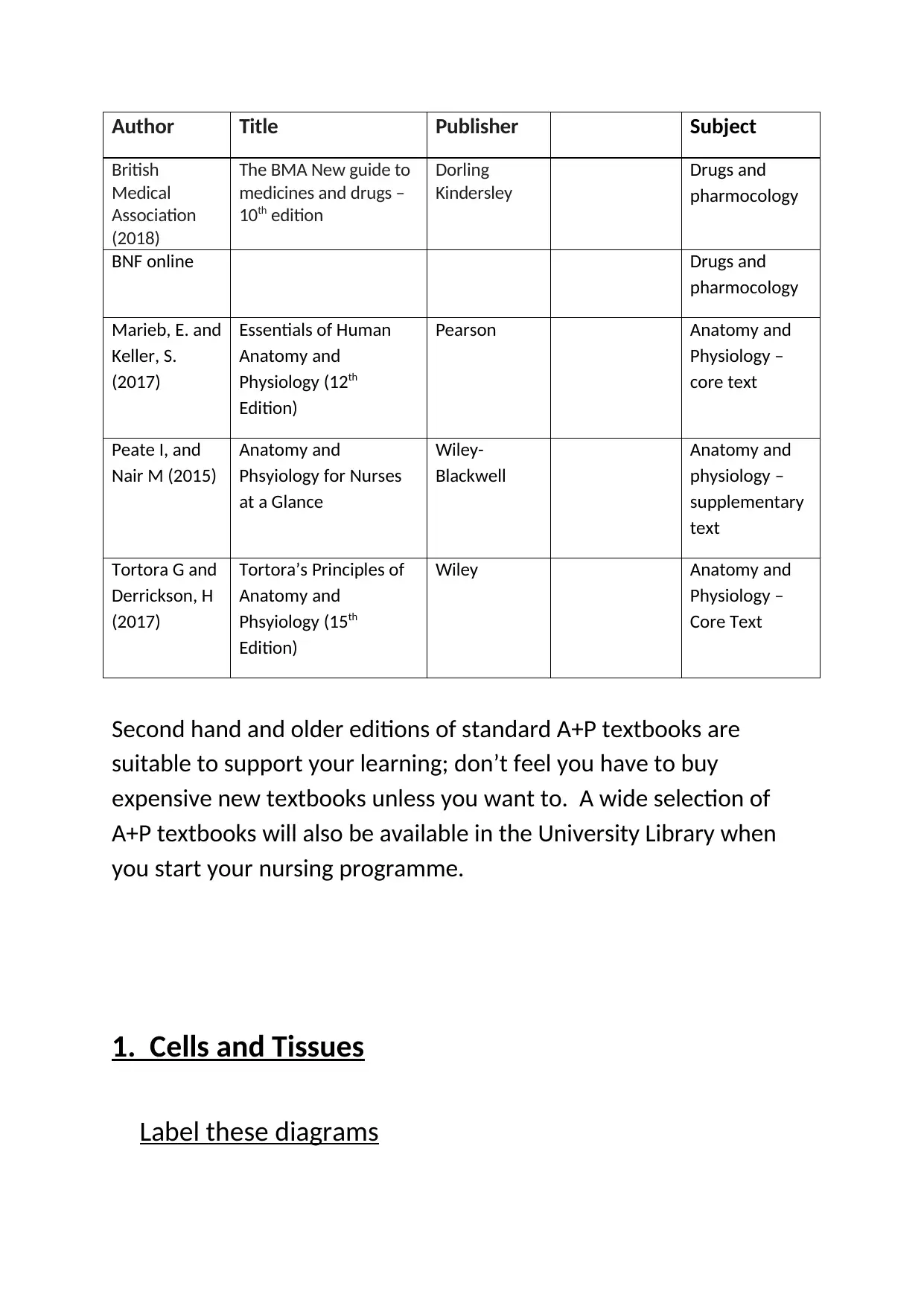
Author Title Publisher Subject
British
Medical
Association
(2018)
The BMA New guide to
medicines and drugs –
10th edition
Dorling
Kindersley
Drugs and
pharmocology
BNF online Drugs and
pharmocology
Marieb, E. and
Keller, S.
(2017)
Essentials of Human
Anatomy and
Physiology (12th
Edition)
Pearson Anatomy and
Physiology –
core text
Peate I, and
Nair M (2015)
Anatomy and
Phsyiology for Nurses
at a Glance
Wiley-
Blackwell
Anatomy and
physiology –
supplementary
text
Tortora G and
Derrickson, H
(2017)
Tortora’s Principles of
Anatomy and
Phsyiology (15th
Edition)
Wiley Anatomy and
Physiology –
Core Text
Second hand and older editions of standard A+P textbooks are
suitable to support your learning; don’t feel you have to buy
expensive new textbooks unless you want to. A wide selection of
A+P textbooks will also be available in the University Library when
you start your nursing programme.
1. Cells and Tissues
Label these diagrams
British
Medical
Association
(2018)
The BMA New guide to
medicines and drugs –
10th edition
Dorling
Kindersley
Drugs and
pharmocology
BNF online Drugs and
pharmocology
Marieb, E. and
Keller, S.
(2017)
Essentials of Human
Anatomy and
Physiology (12th
Edition)
Pearson Anatomy and
Physiology –
core text
Peate I, and
Nair M (2015)
Anatomy and
Phsyiology for Nurses
at a Glance
Wiley-
Blackwell
Anatomy and
physiology –
supplementary
text
Tortora G and
Derrickson, H
(2017)
Tortora’s Principles of
Anatomy and
Phsyiology (15th
Edition)
Wiley Anatomy and
Physiology –
Core Text
Second hand and older editions of standard A+P textbooks are
suitable to support your learning; don’t feel you have to buy
expensive new textbooks unless you want to. A wide selection of
A+P textbooks will also be available in the University Library when
you start your nursing programme.
1. Cells and Tissues
Label these diagrams

Rough
endoplasmic
reticulum
Mitochondrion
Nucleolus
Smooth
endoplasmic
reticulum
Organelle
Centriole
Golgi
apparatus
Ribosomes
Nuclear
pore
Lysosome
Simple
diffusion
directly
through the
phospholipid
bilayer
Carrier mediation
facilitated
diffusion via
protein carrier
specific for one
chemical binding
of substrate
causes shape
change in
transport protein
Channel
mediated
facilitated
diffusion through
a channel
protein; mostly
ions selected on
basis of size and
charge
Osmosis,
diffusion
through a
specific channel
protein or
through the
lipid bilayer
endoplasmic
reticulum
Mitochondrion
Nucleolus
Smooth
endoplasmic
reticulum
Organelle
Centriole
Golgi
apparatus
Ribosomes
Nuclear
pore
Lysosome
Simple
diffusion
directly
through the
phospholipid
bilayer
Carrier mediation
facilitated
diffusion via
protein carrier
specific for one
chemical binding
of substrate
causes shape
change in
transport protein
Channel
mediated
facilitated
diffusion through
a channel
protein; mostly
ions selected on
basis of size and
charge
Osmosis,
diffusion
through a
specific channel
protein or
through the
lipid bilayer
Secure Best Marks with AI Grader
Need help grading? Try our AI Grader for instant feedback on your assignments.

Multiple Choice Questions
1. How many pairs of chromosomes does the nucleus contain?
a. 46
b. 23
c. 21
d. 44
2. Mitochondria are -
a. the control centre of the cell
b. the production of protein
c. the powerhouse of the cell
d. the transport of materials
3. The human body develops from a single cell called -
a. an ovum
b. a zygote
c.a spermatozoon
d. a nucleus
4. This type of cell division occurs in gamete production
a. meiosis
b. mitosis
c. interphase
d. none of the above
5. Catabolism
a. builds complex molecules form simple molecules
b. produces energy
c. requires energy
d. breaks down complex molecules into simpler molecules
1. How many pairs of chromosomes does the nucleus contain?
a. 46
b. 23
c. 21
d. 44
2. Mitochondria are -
a. the control centre of the cell
b. the production of protein
c. the powerhouse of the cell
d. the transport of materials
3. The human body develops from a single cell called -
a. an ovum
b. a zygote
c.a spermatozoon
d. a nucleus
4. This type of cell division occurs in gamete production
a. meiosis
b. mitosis
c. interphase
d. none of the above
5. Catabolism
a. builds complex molecules form simple molecules
b. produces energy
c. requires energy
d. breaks down complex molecules into simpler molecules

6. There are approximately how many types of cell in the body
a. 100
b. 500
c. 200
d. 50
7. The largest cell in the body is -
a. an adipocyte
b. an ovum
c. an erythrocyte
d. a spermatozoon
8. The following is not a type of epithelial tissue -
a. squamous
b. cuboidal
c. bone
d. columnar
9. The following is not a characteristic of epithelium -
a. It has specialised contacts
b. It has polarity
c. It is supported by connective tissue
d. It is rich in blood supply
10.The following type of tissue carries ‘messages’ to and from areas of the
body
a. epithelial
b. muscle
c. nervous
d. connective
a. 100
b. 500
c. 200
d. 50
7. The largest cell in the body is -
a. an adipocyte
b. an ovum
c. an erythrocyte
d. a spermatozoon
8. The following is not a type of epithelial tissue -
a. squamous
b. cuboidal
c. bone
d. columnar
9. The following is not a characteristic of epithelium -
a. It has specialised contacts
b. It has polarity
c. It is supported by connective tissue
d. It is rich in blood supply
10.The following type of tissue carries ‘messages’ to and from areas of the
body
a. epithelial
b. muscle
c. nervous
d. connective
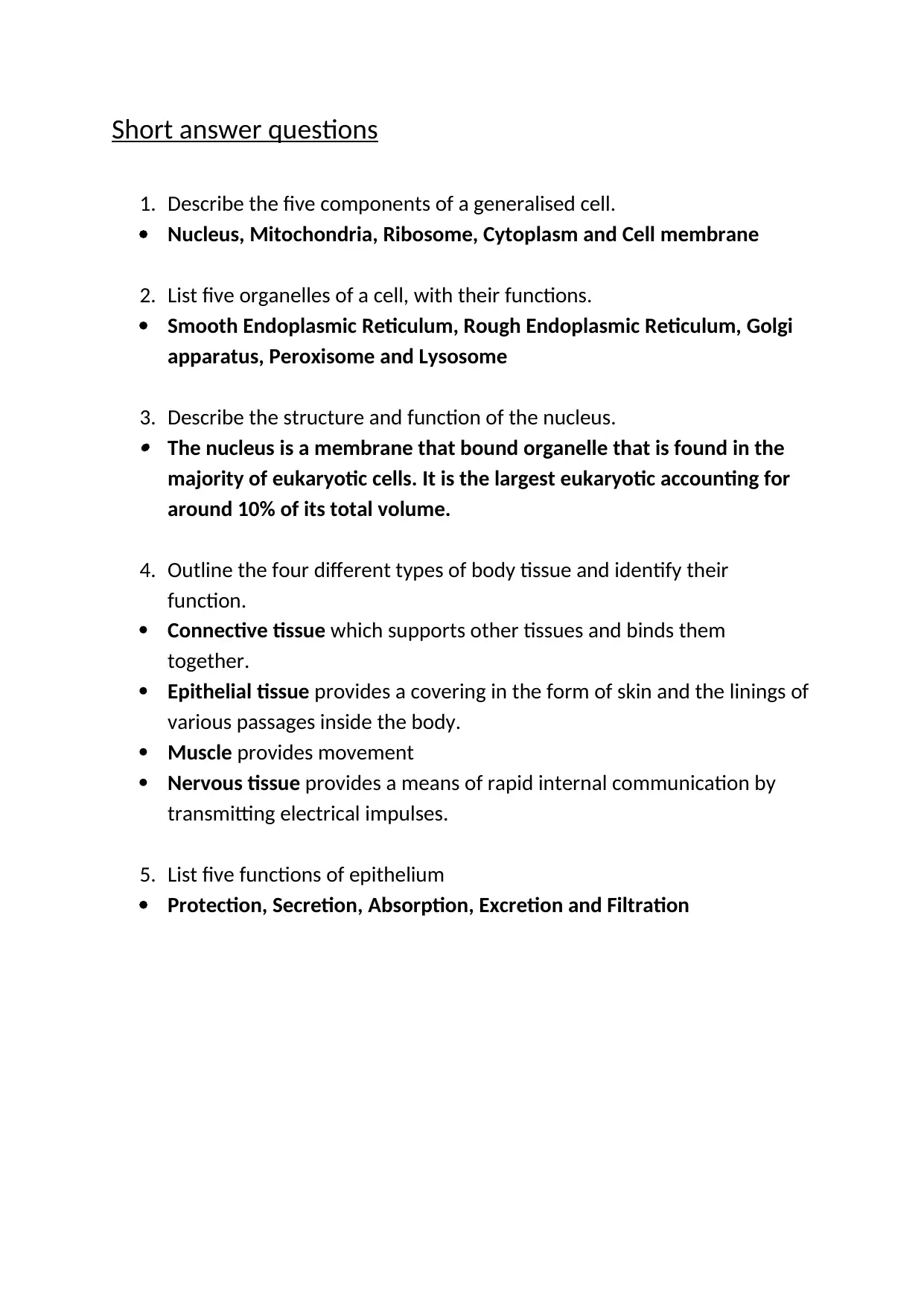
Short answer questions
1. Describe the five components of a generalised cell.
Nucleus, Mitochondria, Ribosome, Cytoplasm and Cell membrane
2. List five organelles of a cell, with their functions.
Smooth Endoplasmic Reticulum, Rough Endoplasmic Reticulum, Golgi
apparatus, Peroxisome and Lysosome
3. Describe the structure and function of the nucleus. The nucleus is a membrane that bound organelle that is found in the
majority of eukaryotic cells. It is the largest eukaryotic accounting for
around 10% of its total volume.
4. Outline the four different types of body tissue and identify their
function.
Connective tissue which supports other tissues and binds them
together.
Epithelial tissue provides a covering in the form of skin and the linings of
various passages inside the body.
Muscle provides movement
Nervous tissue provides a means of rapid internal communication by
transmitting electrical impulses.
5. List five functions of epithelium
Protection, Secretion, Absorption, Excretion and Filtration
1. Describe the five components of a generalised cell.
Nucleus, Mitochondria, Ribosome, Cytoplasm and Cell membrane
2. List five organelles of a cell, with their functions.
Smooth Endoplasmic Reticulum, Rough Endoplasmic Reticulum, Golgi
apparatus, Peroxisome and Lysosome
3. Describe the structure and function of the nucleus. The nucleus is a membrane that bound organelle that is found in the
majority of eukaryotic cells. It is the largest eukaryotic accounting for
around 10% of its total volume.
4. Outline the four different types of body tissue and identify their
function.
Connective tissue which supports other tissues and binds them
together.
Epithelial tissue provides a covering in the form of skin and the linings of
various passages inside the body.
Muscle provides movement
Nervous tissue provides a means of rapid internal communication by
transmitting electrical impulses.
5. List five functions of epithelium
Protection, Secretion, Absorption, Excretion and Filtration
Paraphrase This Document
Need a fresh take? Get an instant paraphrase of this document with our AI Paraphraser
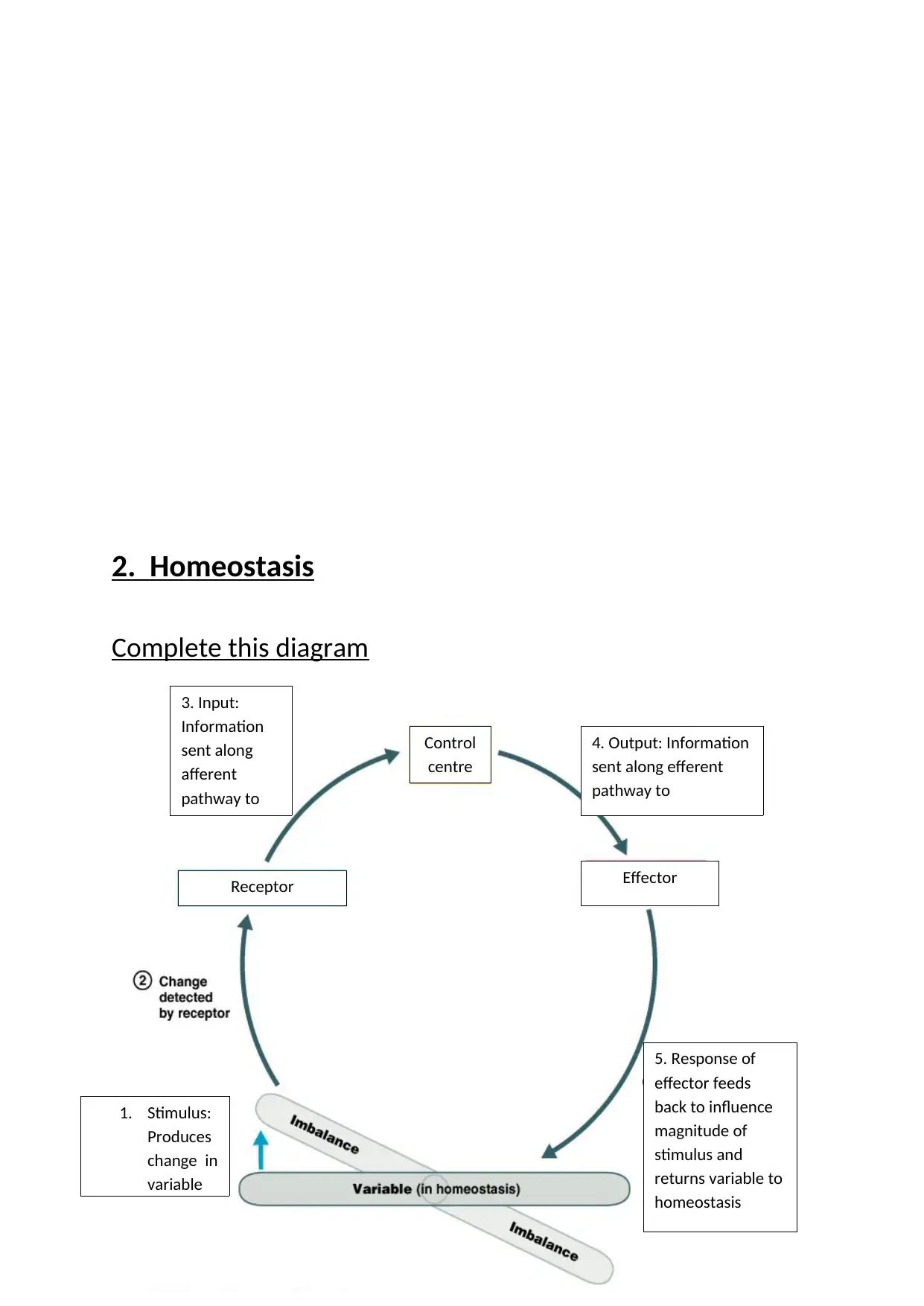
2. Homeostasis
Complete this diagram
1. Stimulus:
Produces
change in
variable
Receptor
3. Input:
Information
sent along
afferent
pathway to
Control
centre
4. Output: Information
sent along efferent
pathway to
Effector
5. Response of
effector feeds
back to influence
magnitude of
stimulus and
returns variable to
homeostasis
Complete this diagram
1. Stimulus:
Produces
change in
variable
Receptor
3. Input:
Information
sent along
afferent
pathway to
Control
centre
4. Output: Information
sent along efferent
pathway to
Effector
5. Response of
effector feeds
back to influence
magnitude of
stimulus and
returns variable to
homeostasis
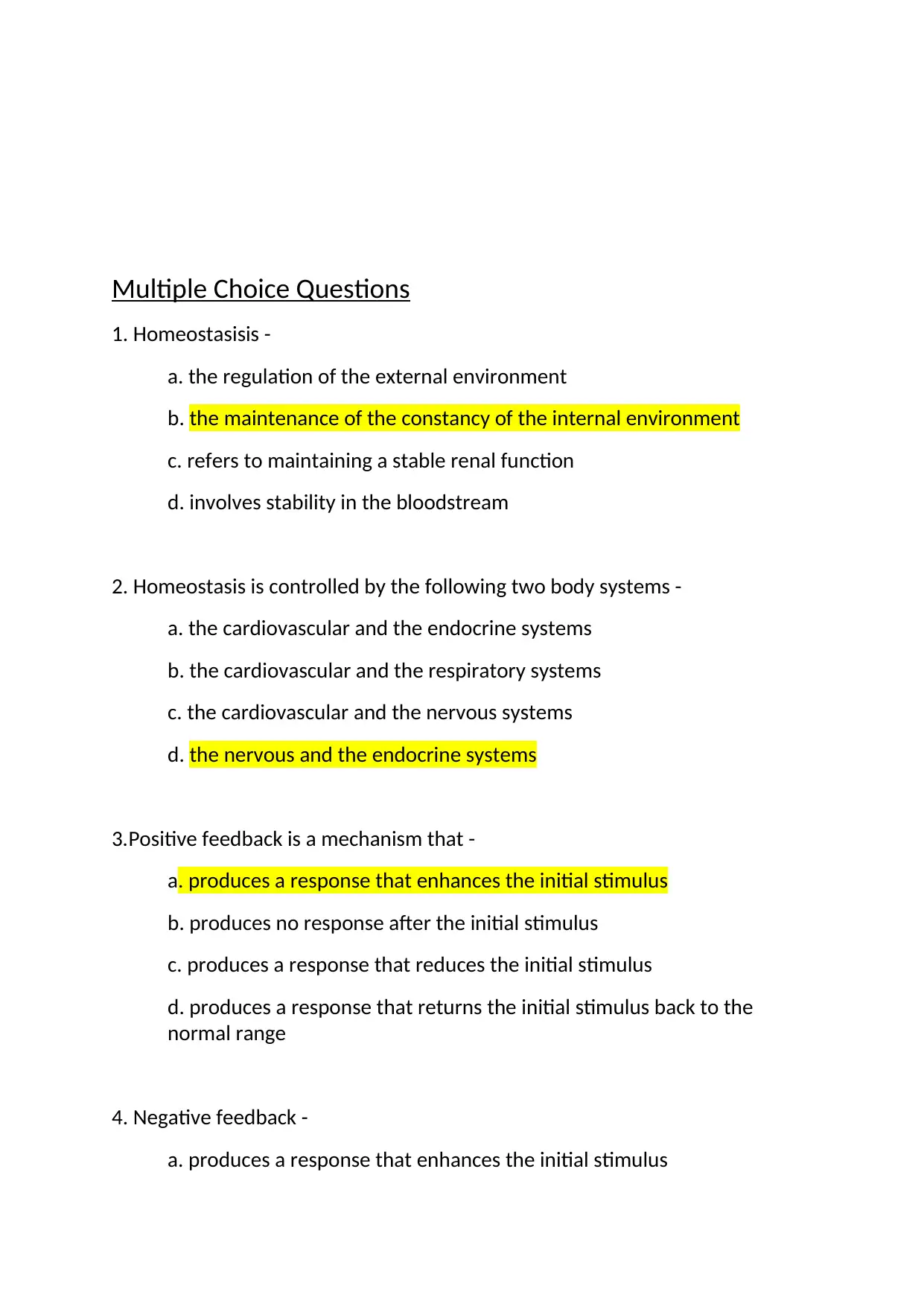
Multiple Choice Questions
1. Homeostasisis -
a. the regulation of the external environment
b. the maintenance of the constancy of the internal environment
c. refers to maintaining a stable renal function
d. involves stability in the bloodstream
2. Homeostasis is controlled by the following two body systems -
a. the cardiovascular and the endocrine systems
b. the cardiovascular and the respiratory systems
c. the cardiovascular and the nervous systems
d. the nervous and the endocrine systems
3.Positive feedback is a mechanism that -
a. produces a response that enhances the initial stimulus
b. produces no response after the initial stimulus
c. produces a response that reduces the initial stimulus
d. produces a response that returns the initial stimulus back to the
normal range
4. Negative feedback -
a. produces a response that enhances the initial stimulus
1. Homeostasisis -
a. the regulation of the external environment
b. the maintenance of the constancy of the internal environment
c. refers to maintaining a stable renal function
d. involves stability in the bloodstream
2. Homeostasis is controlled by the following two body systems -
a. the cardiovascular and the endocrine systems
b. the cardiovascular and the respiratory systems
c. the cardiovascular and the nervous systems
d. the nervous and the endocrine systems
3.Positive feedback is a mechanism that -
a. produces a response that enhances the initial stimulus
b. produces no response after the initial stimulus
c. produces a response that reduces the initial stimulus
d. produces a response that returns the initial stimulus back to the
normal range
4. Negative feedback -
a. produces a response that enhances the initial stimulus
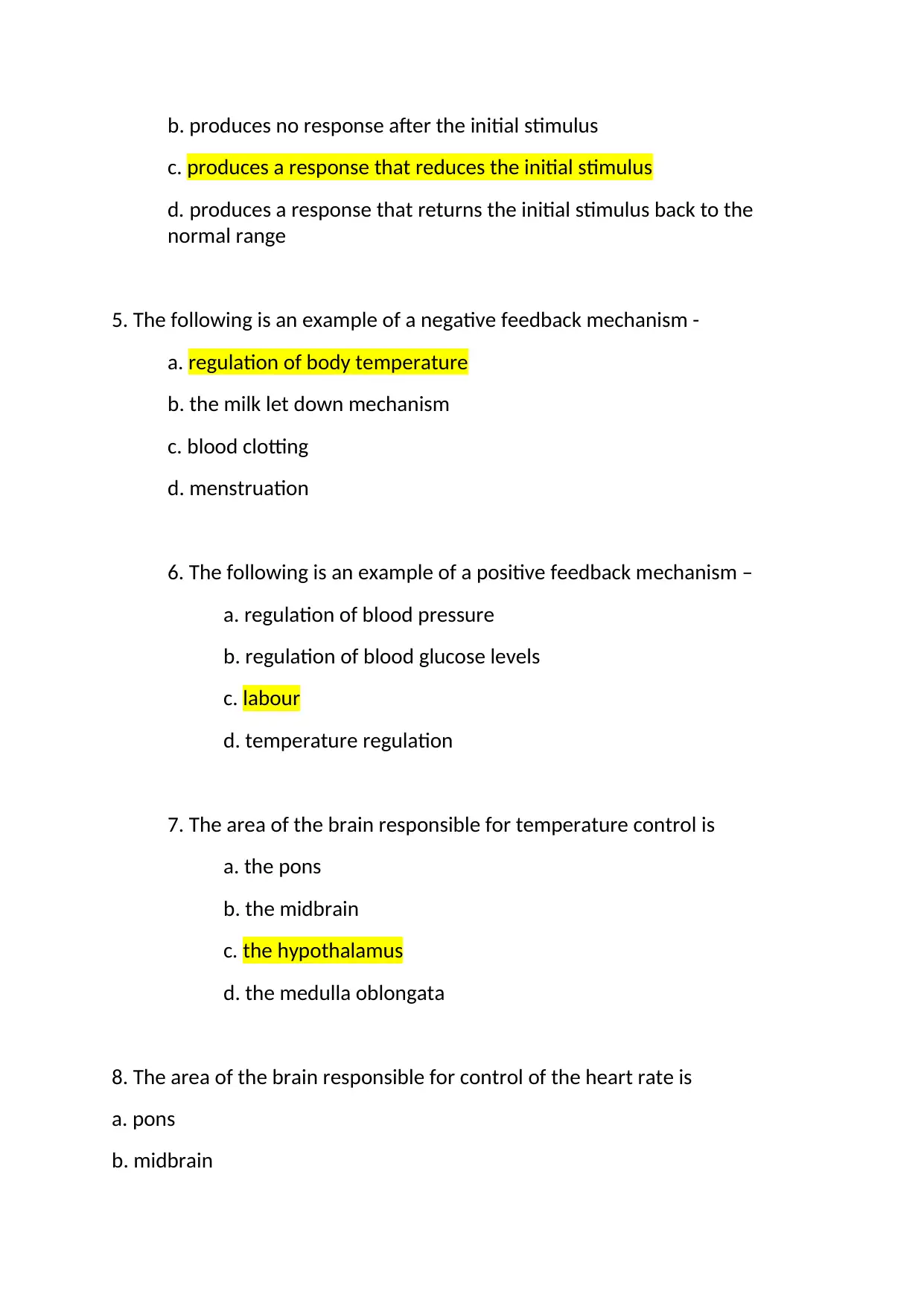
b. produces no response after the initial stimulus
c. produces a response that reduces the initial stimulus
d. produces a response that returns the initial stimulus back to the
normal range
5. The following is an example of a negative feedback mechanism -
a. regulation of body temperature
b. the milk let down mechanism
c. blood clotting
d. menstruation
6. The following is an example of a positive feedback mechanism –
a. regulation of blood pressure
b. regulation of blood glucose levels
c. labour
d. temperature regulation
7. The area of the brain responsible for temperature control is
a. the pons
b. the midbrain
c. the hypothalamus
d. the medulla oblongata
8. The area of the brain responsible for control of the heart rate is
a. pons
b. midbrain
c. produces a response that reduces the initial stimulus
d. produces a response that returns the initial stimulus back to the
normal range
5. The following is an example of a negative feedback mechanism -
a. regulation of body temperature
b. the milk let down mechanism
c. blood clotting
d. menstruation
6. The following is an example of a positive feedback mechanism –
a. regulation of blood pressure
b. regulation of blood glucose levels
c. labour
d. temperature regulation
7. The area of the brain responsible for temperature control is
a. the pons
b. the midbrain
c. the hypothalamus
d. the medulla oblongata
8. The area of the brain responsible for control of the heart rate is
a. pons
b. midbrain
Secure Best Marks with AI Grader
Need help grading? Try our AI Grader for instant feedback on your assignments.
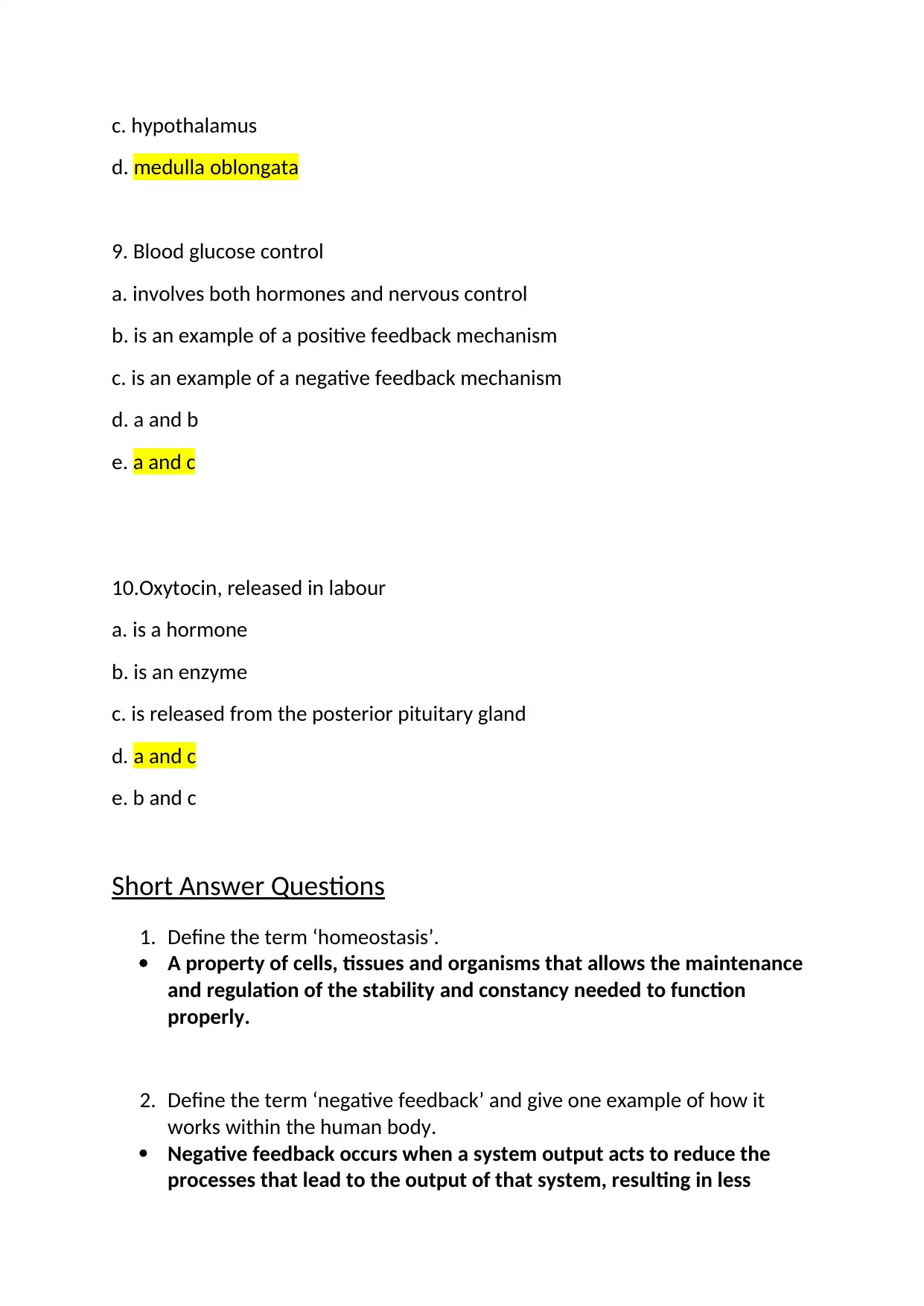
c. hypothalamus
d. medulla oblongata
9. Blood glucose control
a. involves both hormones and nervous control
b. is an example of a positive feedback mechanism
c. is an example of a negative feedback mechanism
d. a and b
e. a and c
10.Oxytocin, released in labour
a. is a hormone
b. is an enzyme
c. is released from the posterior pituitary gland
d. a and c
e. b and c
Short Answer Questions
1. Define the term ‘homeostasis’.
A property of cells, tissues and organisms that allows the maintenance
and regulation of the stability and constancy needed to function
properly.
2. Define the term ‘negative feedback’ and give one example of how it
works within the human body.
Negative feedback occurs when a system output acts to reduce the
processes that lead to the output of that system, resulting in less
d. medulla oblongata
9. Blood glucose control
a. involves both hormones and nervous control
b. is an example of a positive feedback mechanism
c. is an example of a negative feedback mechanism
d. a and b
e. a and c
10.Oxytocin, released in labour
a. is a hormone
b. is an enzyme
c. is released from the posterior pituitary gland
d. a and c
e. b and c
Short Answer Questions
1. Define the term ‘homeostasis’.
A property of cells, tissues and organisms that allows the maintenance
and regulation of the stability and constancy needed to function
properly.
2. Define the term ‘negative feedback’ and give one example of how it
works within the human body.
Negative feedback occurs when a system output acts to reduce the
processes that lead to the output of that system, resulting in less

output. Examples of negative feedback are the maintenance of blood
glucose levels.
3. Define the term ‘positive feedback’ and provide one example of how it
works within the human body.
Positive feedback is a self-reinforcing response to external and internal
input. Example of positive feedback is enhancement in the
concentration of a substance causes feedback that produces continued
increase in concentration.
4. List the five components that are involved in a feedback mechanism.
Input, procedure being controlled, Output, Sensing elements and
controller or actuating devices.
5. Provide five examples of how the homeostatic imbalance of stress can
affect the body.
Examples include blood glucose, thermoregulation, baroreflex in blood
pressure, calcium homeostasis and osmoregulation.
glucose levels.
3. Define the term ‘positive feedback’ and provide one example of how it
works within the human body.
Positive feedback is a self-reinforcing response to external and internal
input. Example of positive feedback is enhancement in the
concentration of a substance causes feedback that produces continued
increase in concentration.
4. List the five components that are involved in a feedback mechanism.
Input, procedure being controlled, Output, Sensing elements and
controller or actuating devices.
5. Provide five examples of how the homeostatic imbalance of stress can
affect the body.
Examples include blood glucose, thermoregulation, baroreflex in blood
pressure, calcium homeostasis and osmoregulation.
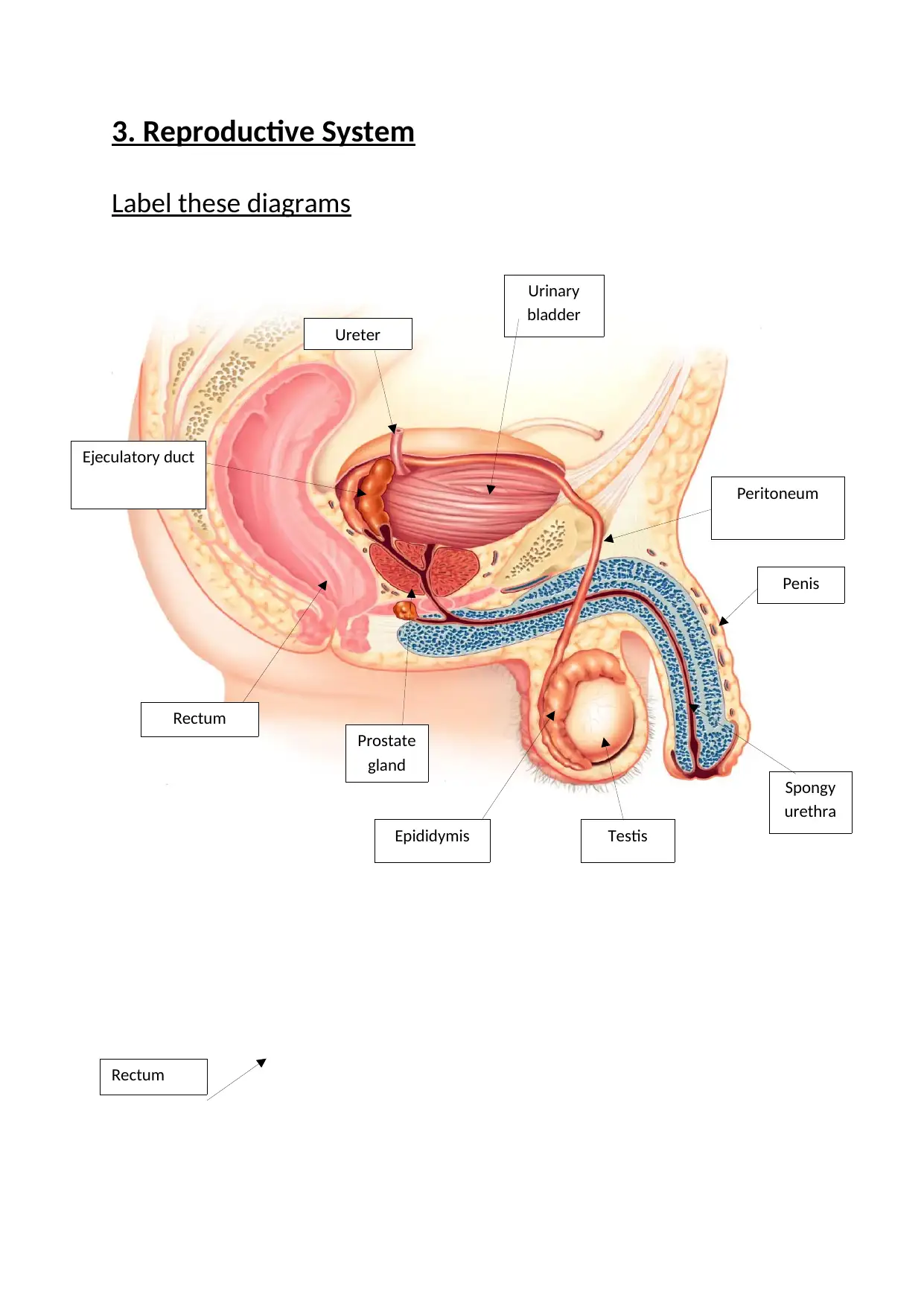
3. Reproductive System
Label these diagrams
Penis
Epididymis Testis
Urinary
bladder
Spongy
urethra
Prostate
gland
Rectum
Ureter
Peritoneum
Ejeculatory duct
Rectum
Label these diagrams
Penis
Epididymis Testis
Urinary
bladder
Spongy
urethra
Prostate
gland
Rectum
Ureter
Peritoneum
Ejeculatory duct
Rectum
Paraphrase This Document
Need a fresh take? Get an instant paraphrase of this document with our AI Paraphraser

MCQ
1. A male gamete is called
a. spermatozoa
b. oocyte
c. oogenesis
d. spermatogenesis
2. A female gamete is called
a. spermatozoa
b. oocyte
c. oogenesis
d. spermatogenesis
3. The process of sperm production is called
a. spermatozoa
b. oocyte
Endometrium
Cervix
Fallopian
tube
Vagina
Myometrium
Perimetrium
Ovaries
Uterine
blood
vessels
Lumen of
uterus
Uterosacral
ligament
1. A male gamete is called
a. spermatozoa
b. oocyte
c. oogenesis
d. spermatogenesis
2. A female gamete is called
a. spermatozoa
b. oocyte
c. oogenesis
d. spermatogenesis
3. The process of sperm production is called
a. spermatozoa
b. oocyte
Endometrium
Cervix
Fallopian
tube
Vagina
Myometrium
Perimetrium
Ovaries
Uterine
blood
vessels
Lumen of
uterus
Uterosacral
ligament
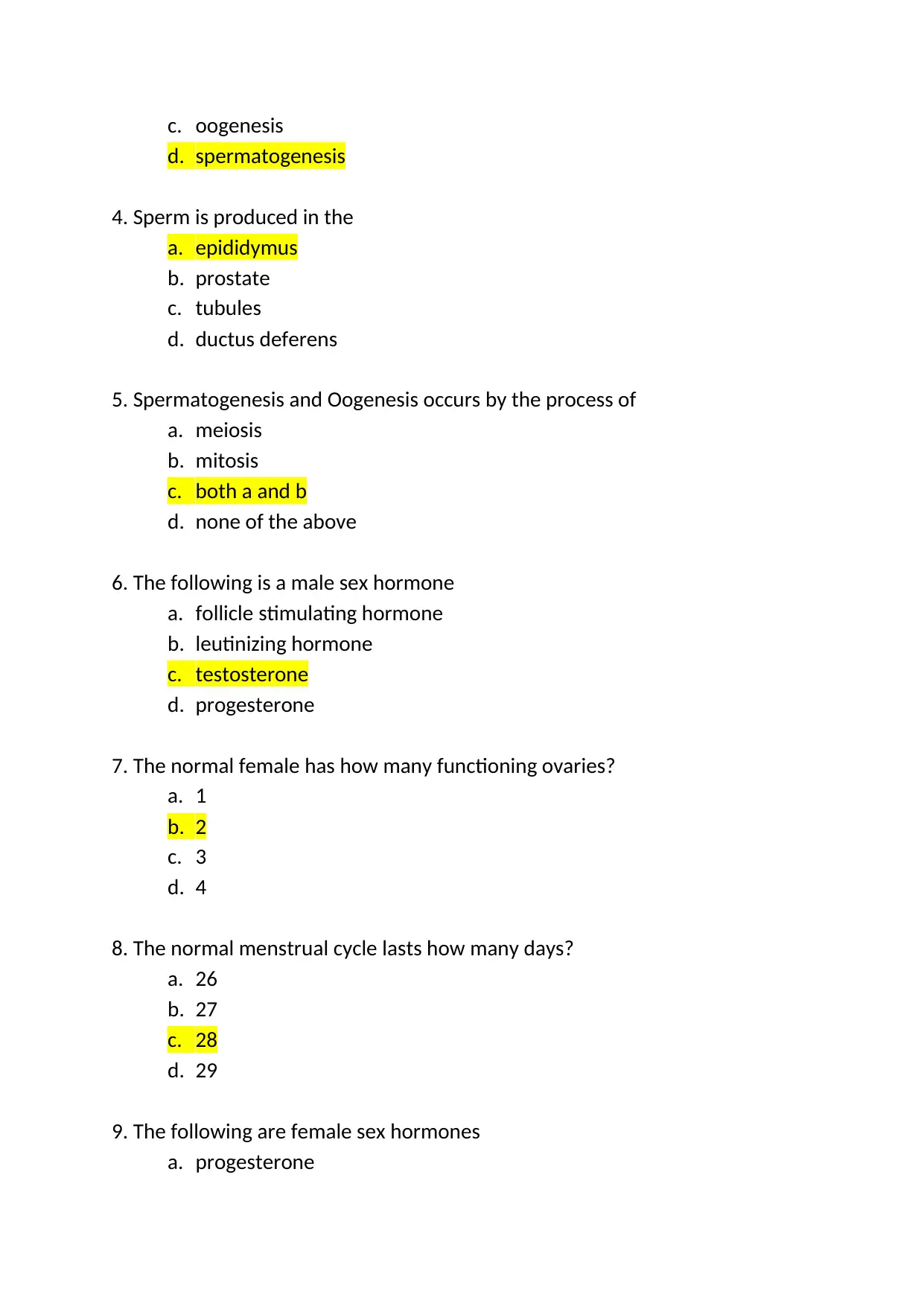
c. oogenesis
d. spermatogenesis
4. Sperm is produced in the
a. epididymus
b. prostate
c. tubules
d. ductus deferens
5. Spermatogenesis and Oogenesis occurs by the process of
a. meiosis
b. mitosis
c. both a and b
d. none of the above
6. The following is a male sex hormone
a. follicle stimulating hormone
b. leutinizing hormone
c. testosterone
d. progesterone
7. The normal female has how many functioning ovaries?
a. 1
b. 2
c. 3
d. 4
8. The normal menstrual cycle lasts how many days?
a. 26
b. 27
c. 28
d. 29
9. The following are female sex hormones
a. progesterone
d. spermatogenesis
4. Sperm is produced in the
a. epididymus
b. prostate
c. tubules
d. ductus deferens
5. Spermatogenesis and Oogenesis occurs by the process of
a. meiosis
b. mitosis
c. both a and b
d. none of the above
6. The following is a male sex hormone
a. follicle stimulating hormone
b. leutinizing hormone
c. testosterone
d. progesterone
7. The normal female has how many functioning ovaries?
a. 1
b. 2
c. 3
d. 4
8. The normal menstrual cycle lasts how many days?
a. 26
b. 27
c. 28
d. 29
9. The following are female sex hormones
a. progesterone
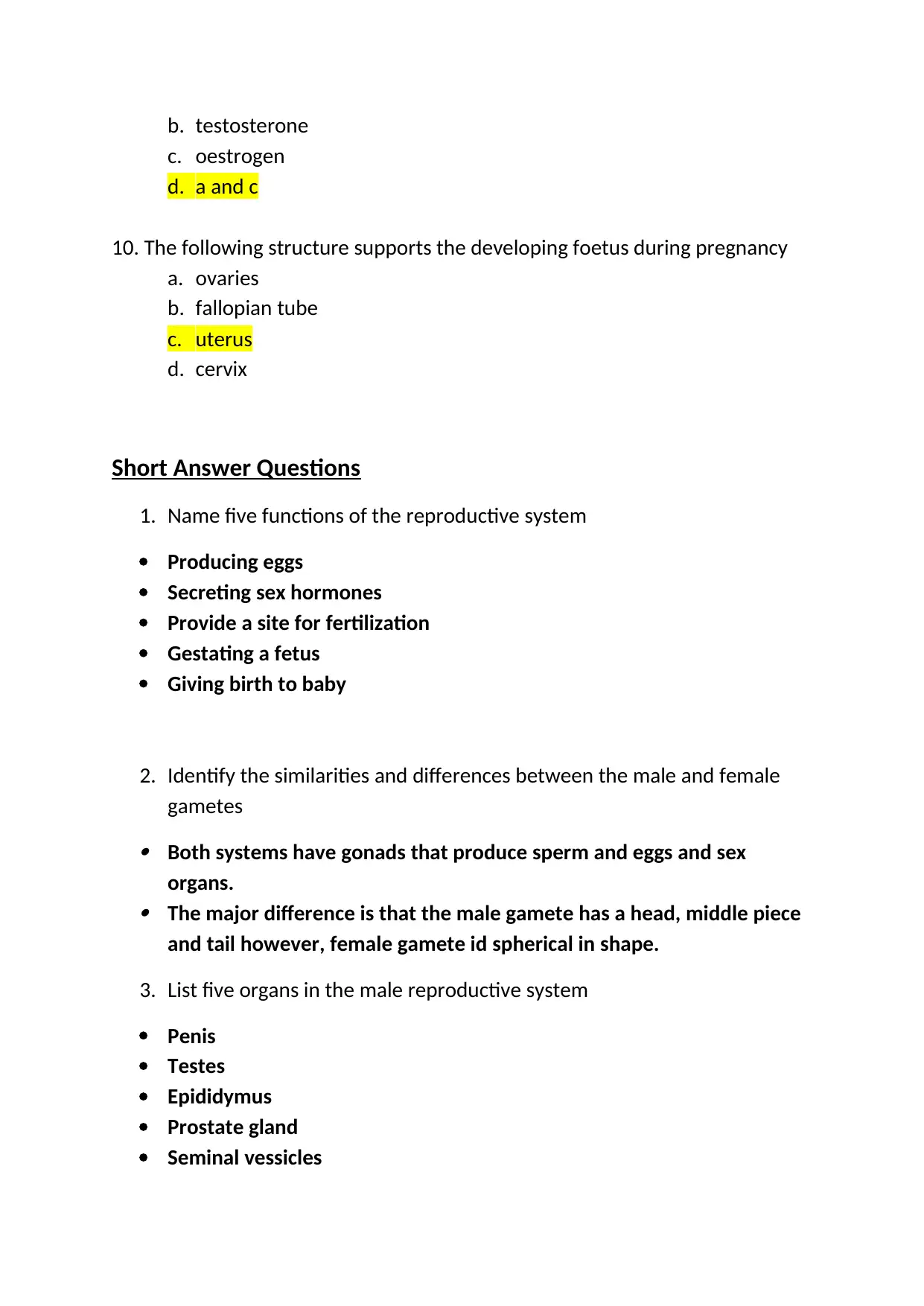
b. testosterone
c. oestrogen
d. a and c
10. The following structure supports the developing foetus during pregnancy
a. ovaries
b. fallopian tube
c. uterus
d. cervix
Short Answer Questions
1. Name five functions of the reproductive system
Producing eggs
Secreting sex hormones
Provide a site for fertilization
Gestating a fetus
Giving birth to baby
2. Identify the similarities and differences between the male and female
gametes Both systems have gonads that produce sperm and eggs and sex
organs. The major difference is that the male gamete has a head, middle piece
and tail however, female gamete id spherical in shape.
3. List five organs in the male reproductive system
Penis
Testes
Epididymus
Prostate gland
Seminal vessicles
c. oestrogen
d. a and c
10. The following structure supports the developing foetus during pregnancy
a. ovaries
b. fallopian tube
c. uterus
d. cervix
Short Answer Questions
1. Name five functions of the reproductive system
Producing eggs
Secreting sex hormones
Provide a site for fertilization
Gestating a fetus
Giving birth to baby
2. Identify the similarities and differences between the male and female
gametes Both systems have gonads that produce sperm and eggs and sex
organs. The major difference is that the male gamete has a head, middle piece
and tail however, female gamete id spherical in shape.
3. List five organs in the male reproductive system
Penis
Testes
Epididymus
Prostate gland
Seminal vessicles
Secure Best Marks with AI Grader
Need help grading? Try our AI Grader for instant feedback on your assignments.
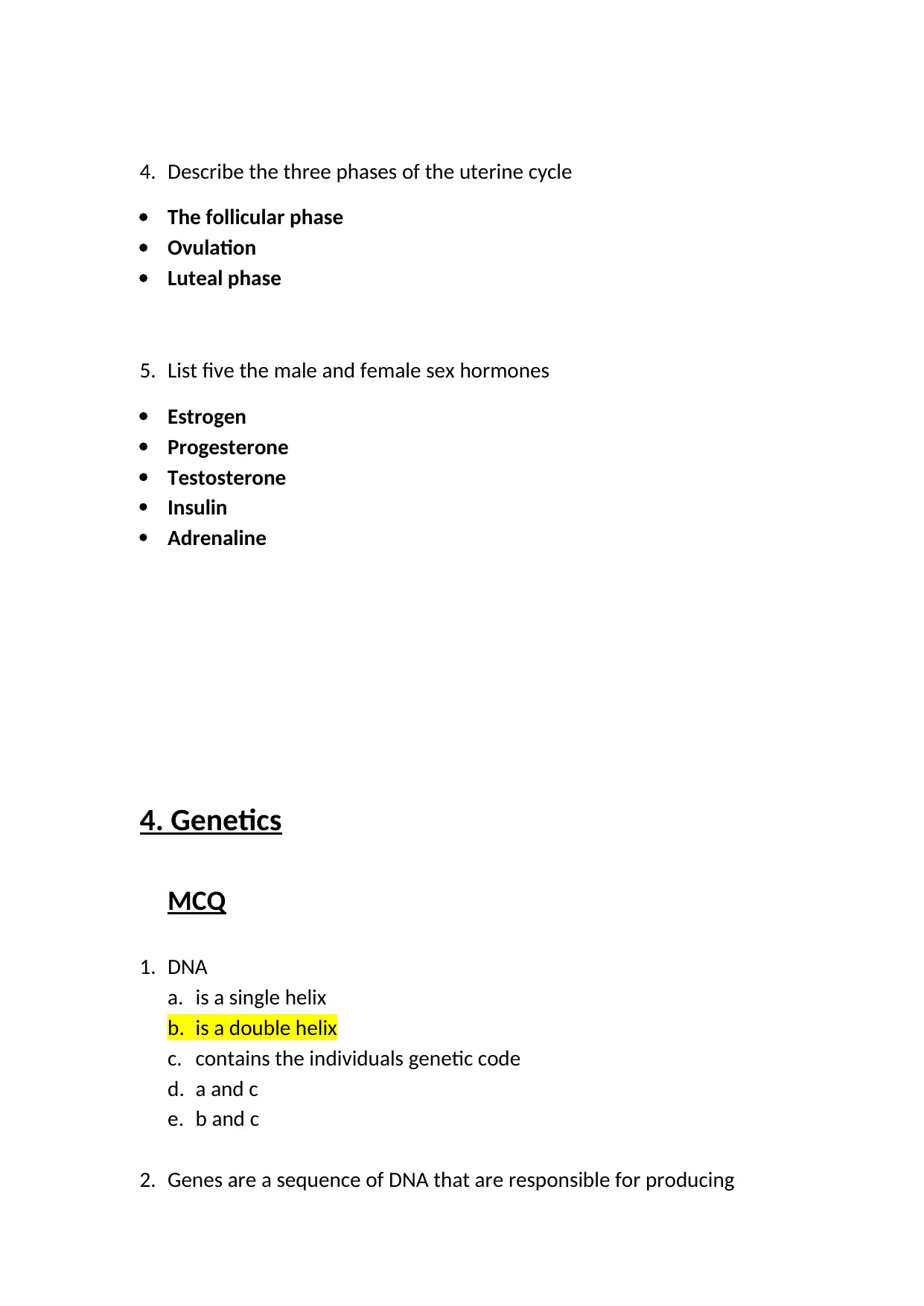
4. Describe the three phases of the uterine cycle
The follicular phase
Ovulation
Luteal phase
5. List five the male and female sex hormones
Estrogen
Progesterone
Testosterone
Insulin
Adrenaline
4. Genetics
MCQ
1. DNA
a. is a single helix
b. is a double helix
c. contains the individuals genetic code
d. a and c
e. b and c
2. Genes are a sequence of DNA that are responsible for producing
The follicular phase
Ovulation
Luteal phase
5. List five the male and female sex hormones
Estrogen
Progesterone
Testosterone
Insulin
Adrenaline
4. Genetics
MCQ
1. DNA
a. is a single helix
b. is a double helix
c. contains the individuals genetic code
d. a and c
e. b and c
2. Genes are a sequence of DNA that are responsible for producing
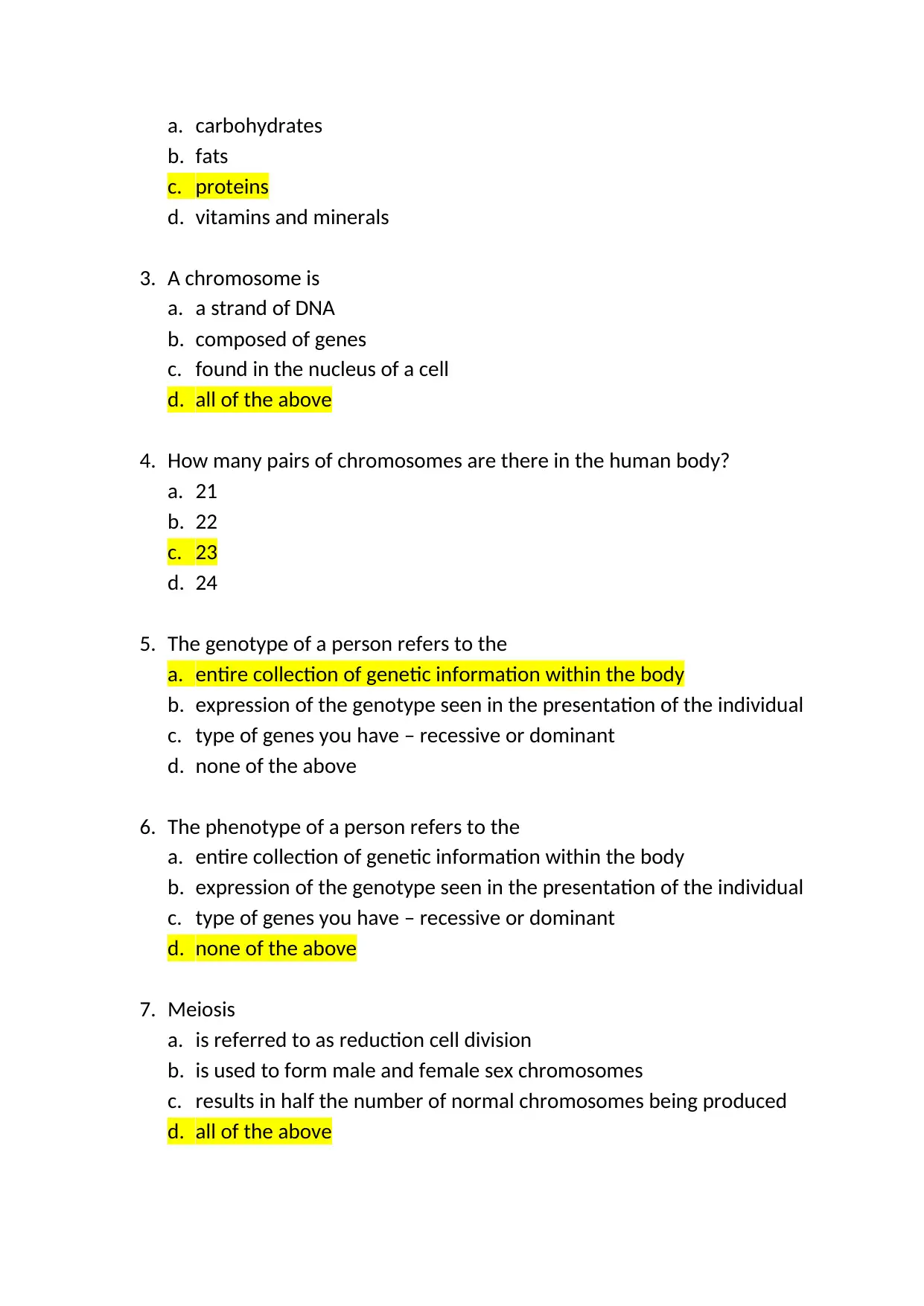
a. carbohydrates
b. fats
c. proteins
d. vitamins and minerals
3. A chromosome is
a. a strand of DNA
b. composed of genes
c. found in the nucleus of a cell
d. all of the above
4. How many pairs of chromosomes are there in the human body?
a. 21
b. 22
c. 23
d. 24
5. The genotype of a person refers to the
a. entire collection of genetic information within the body
b. expression of the genotype seen in the presentation of the individual
c. type of genes you have – recessive or dominant
d. none of the above
6. The phenotype of a person refers to the
a. entire collection of genetic information within the body
b. expression of the genotype seen in the presentation of the individual
c. type of genes you have – recessive or dominant
d. none of the above
7. Meiosis
a. is referred to as reduction cell division
b. is used to form male and female sex chromosomes
c. results in half the number of normal chromosomes being produced
d. all of the above
b. fats
c. proteins
d. vitamins and minerals
3. A chromosome is
a. a strand of DNA
b. composed of genes
c. found in the nucleus of a cell
d. all of the above
4. How many pairs of chromosomes are there in the human body?
a. 21
b. 22
c. 23
d. 24
5. The genotype of a person refers to the
a. entire collection of genetic information within the body
b. expression of the genotype seen in the presentation of the individual
c. type of genes you have – recessive or dominant
d. none of the above
6. The phenotype of a person refers to the
a. entire collection of genetic information within the body
b. expression of the genotype seen in the presentation of the individual
c. type of genes you have – recessive or dominant
d. none of the above
7. Meiosis
a. is referred to as reduction cell division
b. is used to form male and female sex chromosomes
c. results in half the number of normal chromosomes being produced
d. all of the above
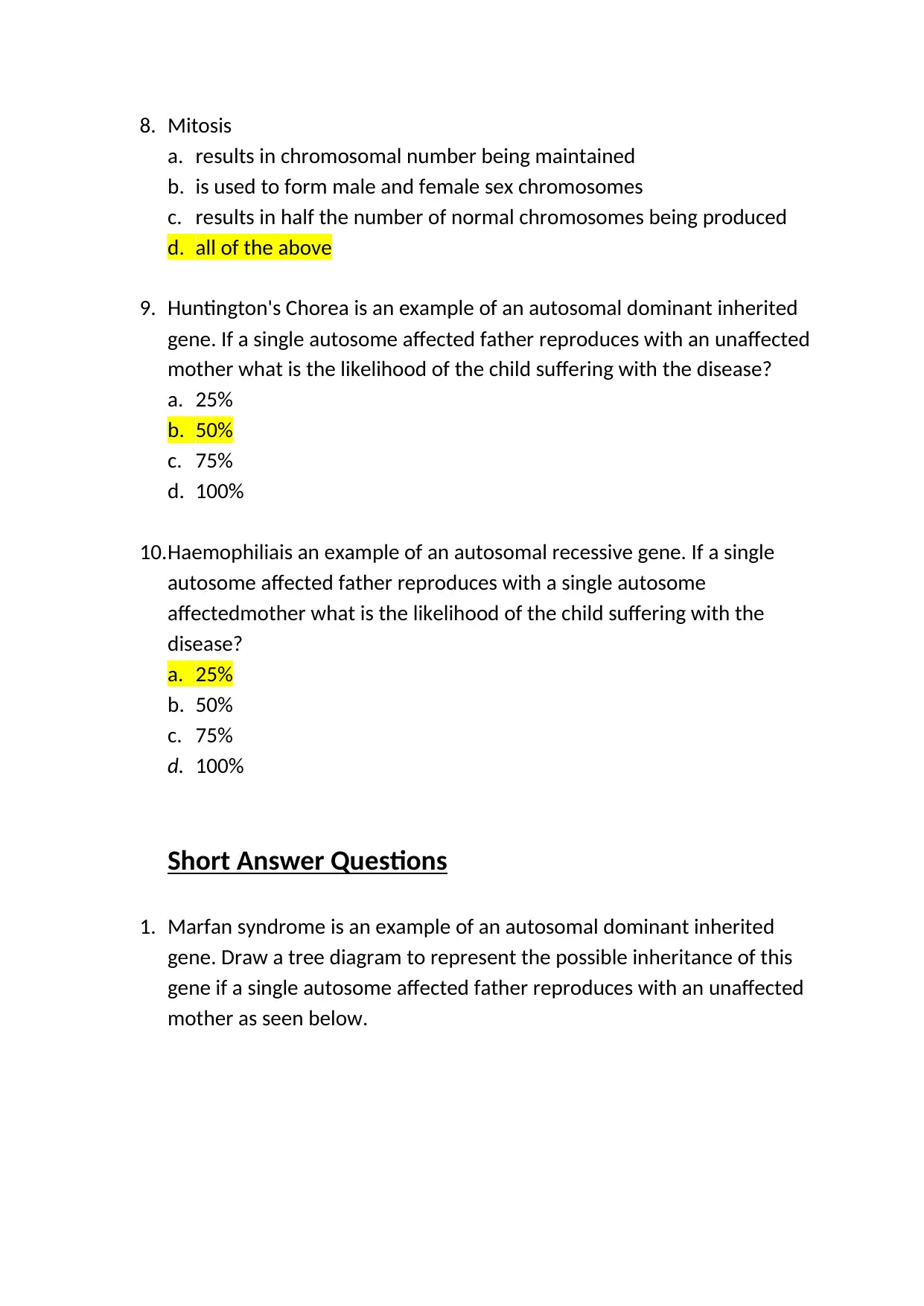
8. Mitosis
a. results in chromosomal number being maintained
b. is used to form male and female sex chromosomes
c. results in half the number of normal chromosomes being produced
d. all of the above
9. Huntington's Chorea is an example of an autosomal dominant inherited
gene. If a single autosome affected father reproduces with an unaffected
mother what is the likelihood of the child suffering with the disease?
a. 25%
b. 50%
c. 75%
d. 100%
10.Haemophiliais an example of an autosomal recessive gene. If a single
autosome affected father reproduces with a single autosome
affectedmother what is the likelihood of the child suffering with the
disease?
a. 25%
b. 50%
c. 75%
d. 100%
Short Answer Questions
1. Marfan syndrome is an example of an autosomal dominant inherited
gene. Draw a tree diagram to represent the possible inheritance of this
gene if a single autosome affected father reproduces with an unaffected
mother as seen below.
a. results in chromosomal number being maintained
b. is used to form male and female sex chromosomes
c. results in half the number of normal chromosomes being produced
d. all of the above
9. Huntington's Chorea is an example of an autosomal dominant inherited
gene. If a single autosome affected father reproduces with an unaffected
mother what is the likelihood of the child suffering with the disease?
a. 25%
b. 50%
c. 75%
d. 100%
10.Haemophiliais an example of an autosomal recessive gene. If a single
autosome affected father reproduces with a single autosome
affectedmother what is the likelihood of the child suffering with the
disease?
a. 25%
b. 50%
c. 75%
d. 100%
Short Answer Questions
1. Marfan syndrome is an example of an autosomal dominant inherited
gene. Draw a tree diagram to represent the possible inheritance of this
gene if a single autosome affected father reproduces with an unaffected
mother as seen below.
Paraphrase This Document
Need a fresh take? Get an instant paraphrase of this document with our AI Paraphraser
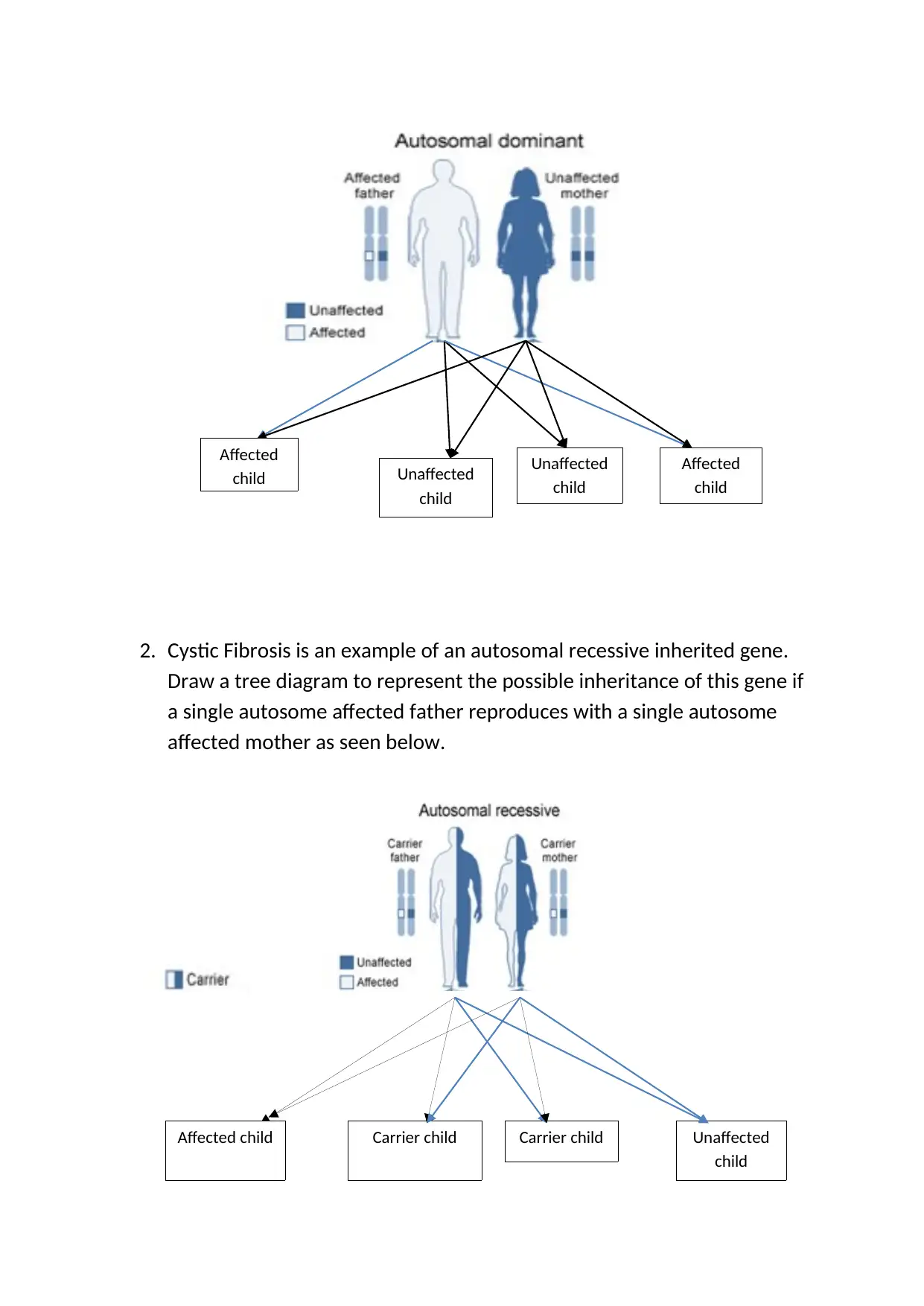
2. Cystic Fibrosis is an example of an autosomal recessive inherited gene.
Draw a tree diagram to represent the possible inheritance of this gene if
a single autosome affected father reproduces with a single autosome
affected mother as seen below.
Affected
child Unaffected
child
Unaffected
child
Affected
child
Affected child Carrier child Carrier child Unaffected
child
Draw a tree diagram to represent the possible inheritance of this gene if
a single autosome affected father reproduces with a single autosome
affected mother as seen below.
Affected
child Unaffected
child
Unaffected
child
Affected
child
Affected child Carrier child Carrier child Unaffected
child

3. Identify 5 risk factors that can influence an individual’s genes and
disease.
High blood pressure
High blood cholesterol
Physical inactivity
Diabetes
Obesity and overweight
5. Cardio-vascular System
Label these diagrams
disease.
High blood pressure
High blood cholesterol
Physical inactivity
Diabetes
Obesity and overweight
5. Cardio-vascular System
Label these diagrams
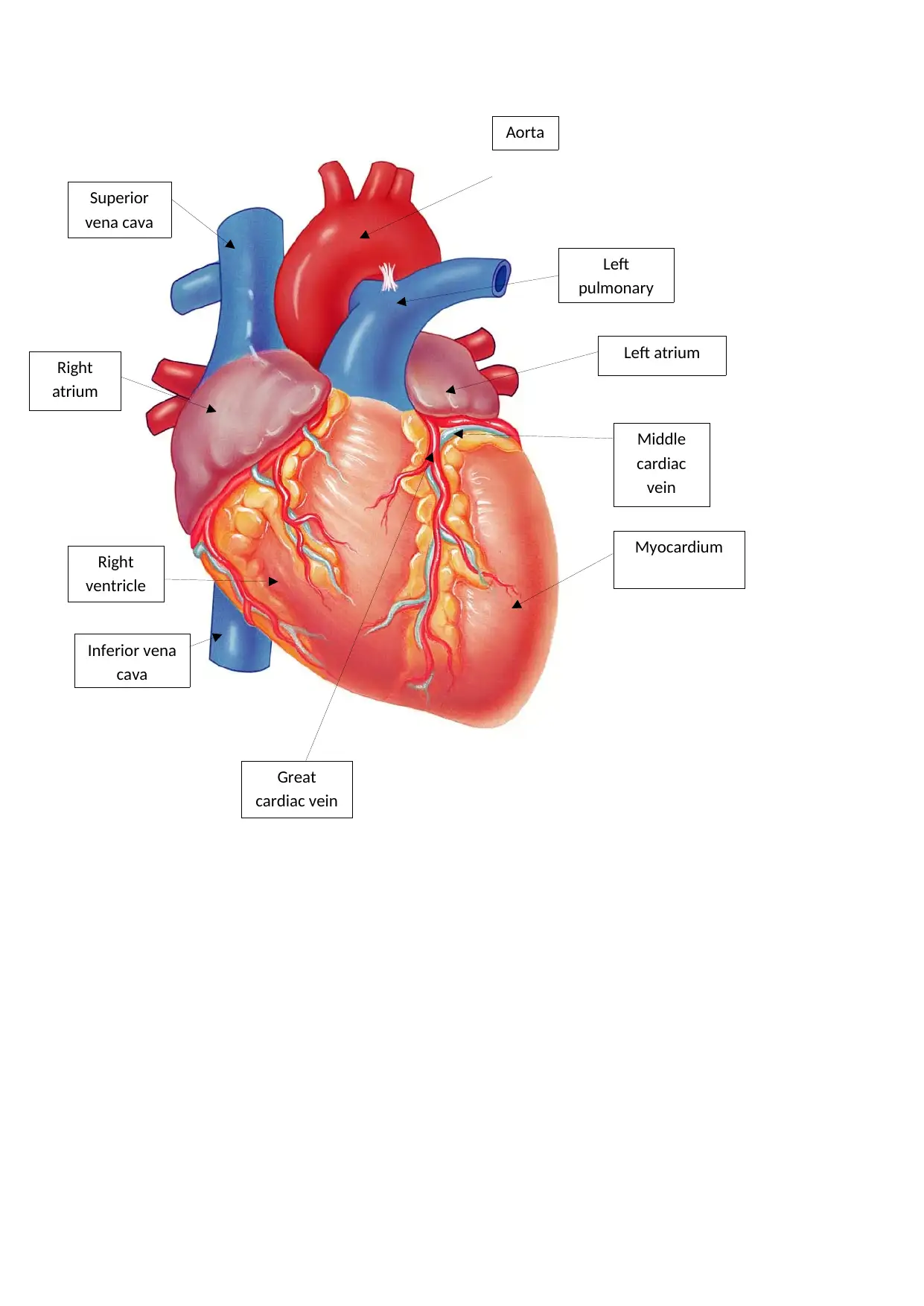
Aorta
Superior
vena cava
Inferior vena
cava
Left atrium
Right
atrium
Right
ventricle
Left
pulmonary
Myocardium
Middle
cardiac
vein
Great
cardiac vein
Superior
vena cava
Inferior vena
cava
Left atrium
Right
atrium
Right
ventricle
Left
pulmonary
Myocardium
Middle
cardiac
vein
Great
cardiac vein
Secure Best Marks with AI Grader
Need help grading? Try our AI Grader for instant feedback on your assignments.
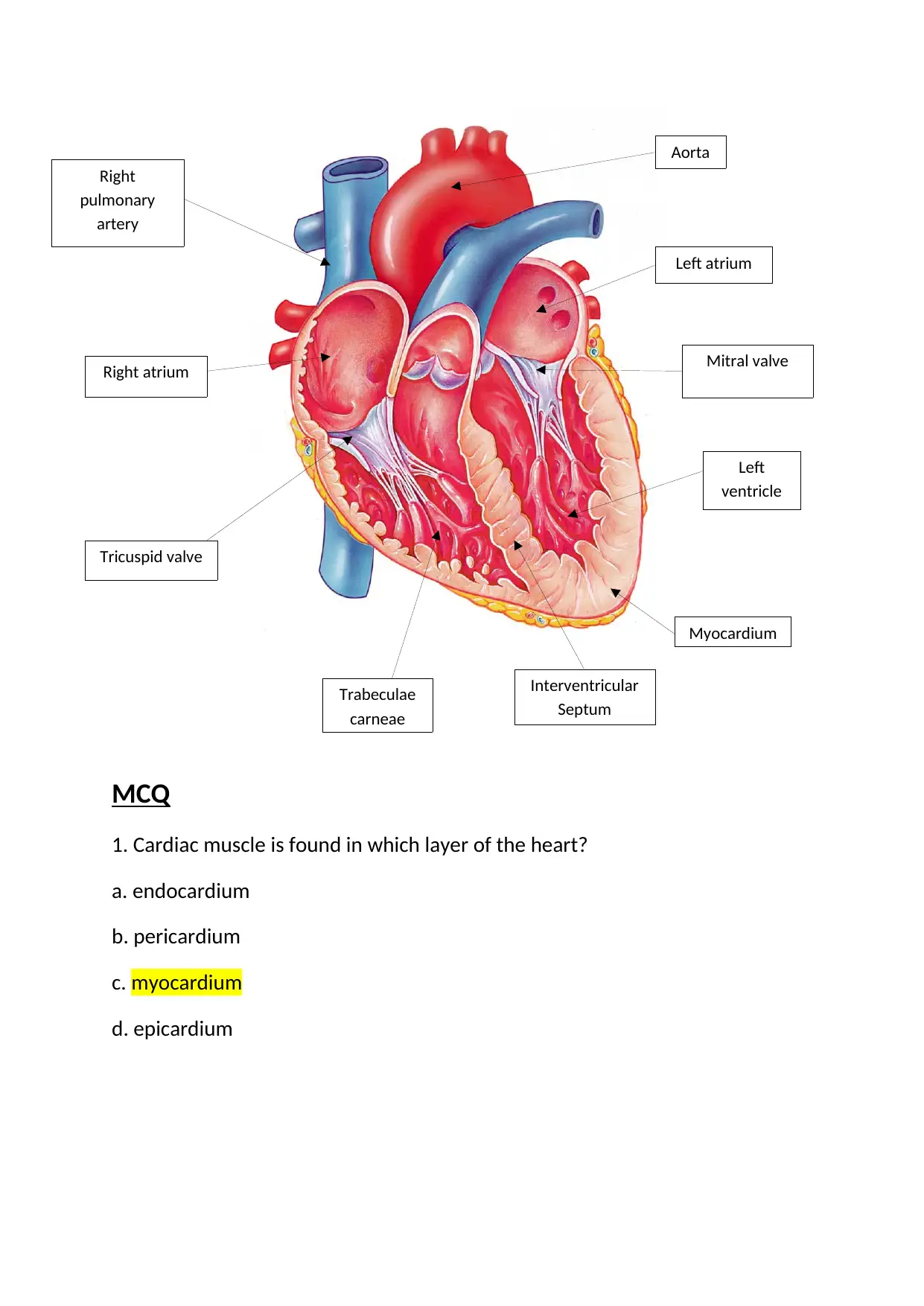
MCQ
1. Cardiac muscle is found in which layer of the heart?
a. endocardium
b. pericardium
c. myocardium
d. epicardium
Tricuspid valve
Aorta
Trabeculae
carneae
Left atrium
Mitral valve
Right
pulmonary
artery
Right atrium
Interventricular
Septum
Left
ventricle
Myocardium
1. Cardiac muscle is found in which layer of the heart?
a. endocardium
b. pericardium
c. myocardium
d. epicardium
Tricuspid valve
Aorta
Trabeculae
carneae
Left atrium
Mitral valve
Right
pulmonary
artery
Right atrium
Interventricular
Septum
Left
ventricle
Myocardium
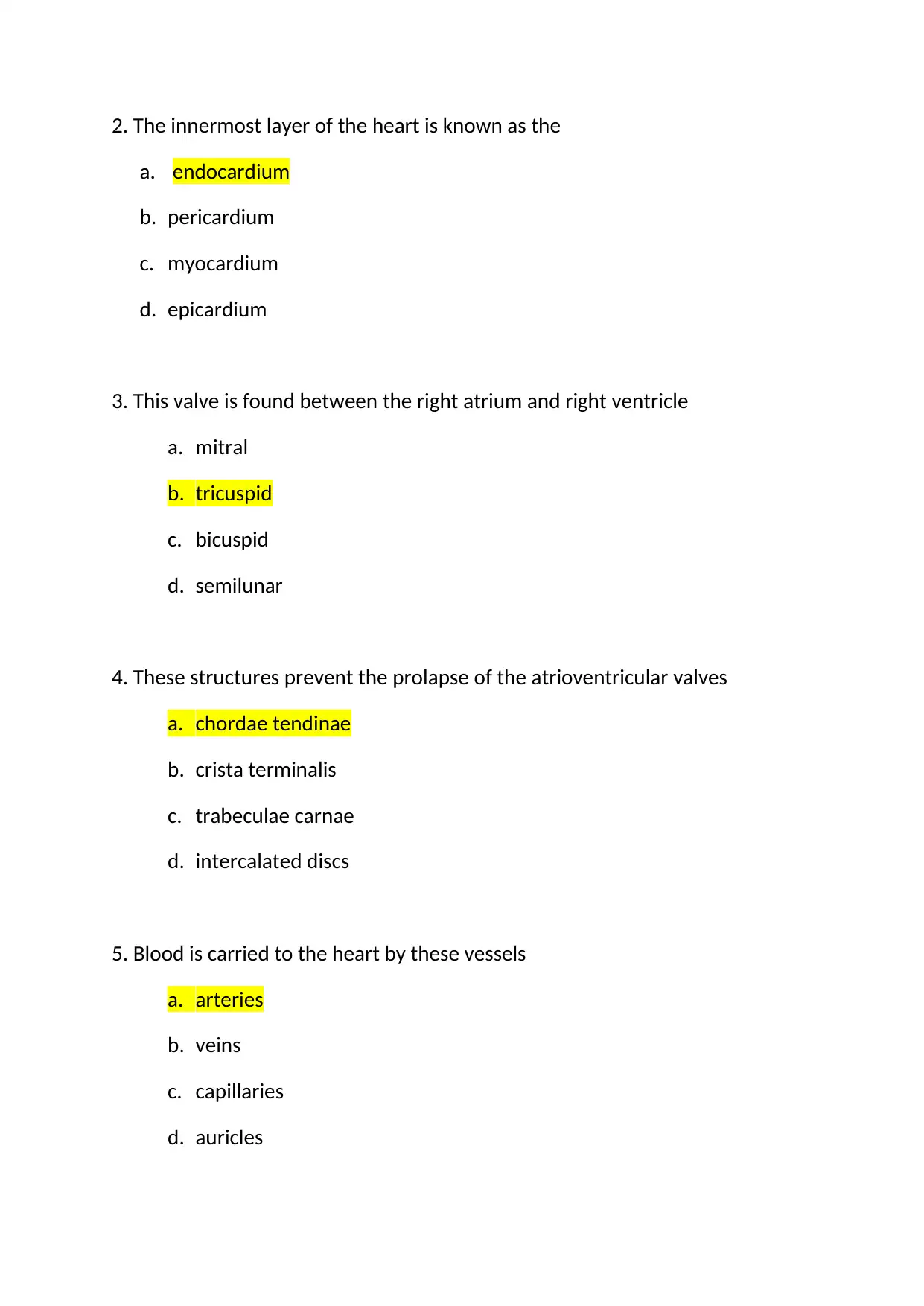
2. The innermost layer of the heart is known as the
a. endocardium
b. pericardium
c. myocardium
d. epicardium
3. This valve is found between the right atrium and right ventricle
a. mitral
b. tricuspid
c. bicuspid
d. semilunar
4. These structures prevent the prolapse of the atrioventricular valves
a. chordae tendinae
b. crista terminalis
c. trabeculae carnae
d. intercalated discs
5. Blood is carried to the heart by these vessels
a. arteries
b. veins
c. capillaries
d. auricles
a. endocardium
b. pericardium
c. myocardium
d. epicardium
3. This valve is found between the right atrium and right ventricle
a. mitral
b. tricuspid
c. bicuspid
d. semilunar
4. These structures prevent the prolapse of the atrioventricular valves
a. chordae tendinae
b. crista terminalis
c. trabeculae carnae
d. intercalated discs
5. Blood is carried to the heart by these vessels
a. arteries
b. veins
c. capillaries
d. auricles
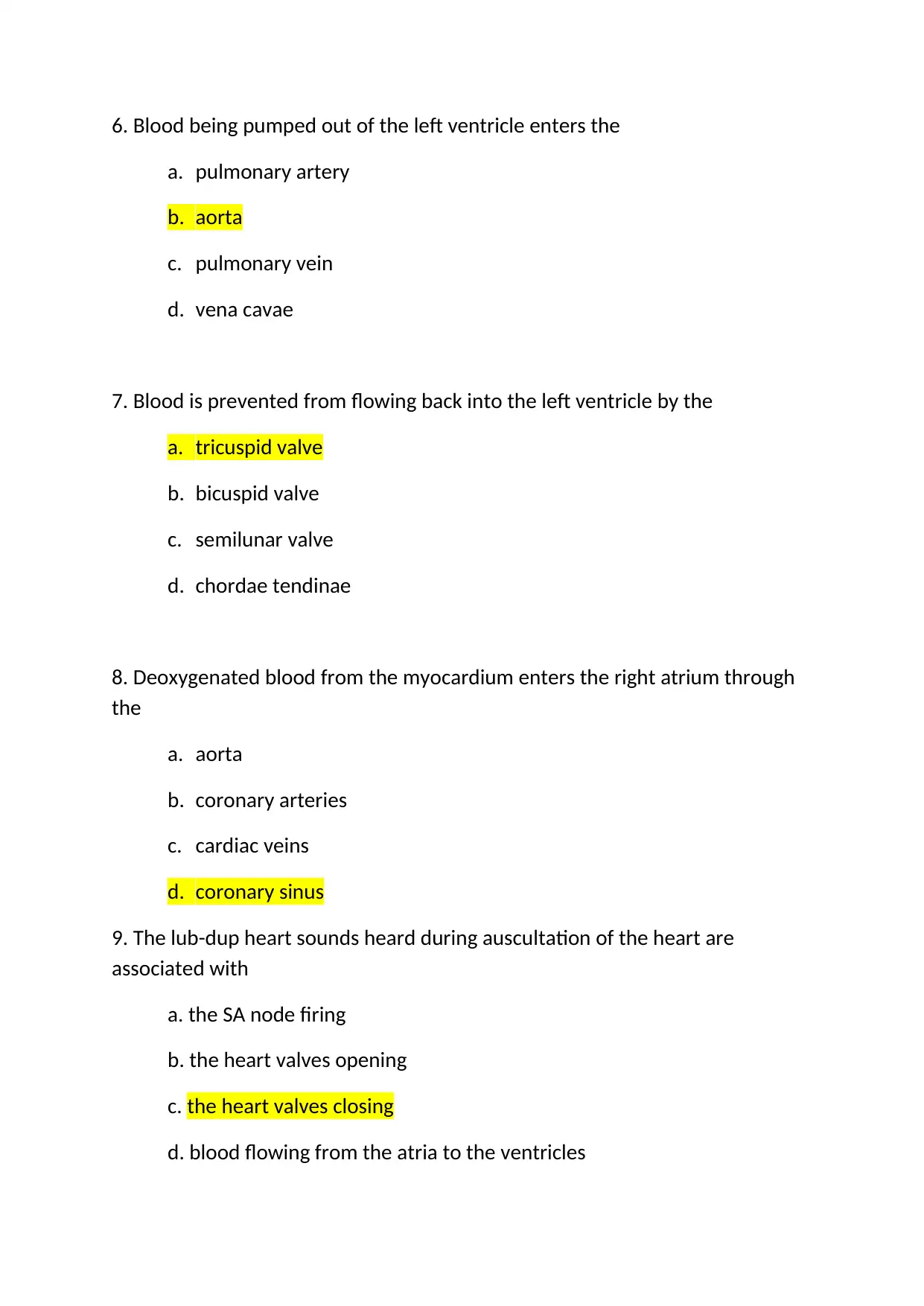
6. Blood being pumped out of the left ventricle enters the
a. pulmonary artery
b. aorta
c. pulmonary vein
d. vena cavae
7. Blood is prevented from flowing back into the left ventricle by the
a. tricuspid valve
b. bicuspid valve
c. semilunar valve
d. chordae tendinae
8. Deoxygenated blood from the myocardium enters the right atrium through
the
a. aorta
b. coronary arteries
c. cardiac veins
d. coronary sinus
9. The lub-dup heart sounds heard during auscultation of the heart are
associated with
a. the SA node firing
b. the heart valves opening
c. the heart valves closing
d. blood flowing from the atria to the ventricles
a. pulmonary artery
b. aorta
c. pulmonary vein
d. vena cavae
7. Blood is prevented from flowing back into the left ventricle by the
a. tricuspid valve
b. bicuspid valve
c. semilunar valve
d. chordae tendinae
8. Deoxygenated blood from the myocardium enters the right atrium through
the
a. aorta
b. coronary arteries
c. cardiac veins
d. coronary sinus
9. The lub-dup heart sounds heard during auscultation of the heart are
associated with
a. the SA node firing
b. the heart valves opening
c. the heart valves closing
d. blood flowing from the atria to the ventricles
Paraphrase This Document
Need a fresh take? Get an instant paraphrase of this document with our AI Paraphraser
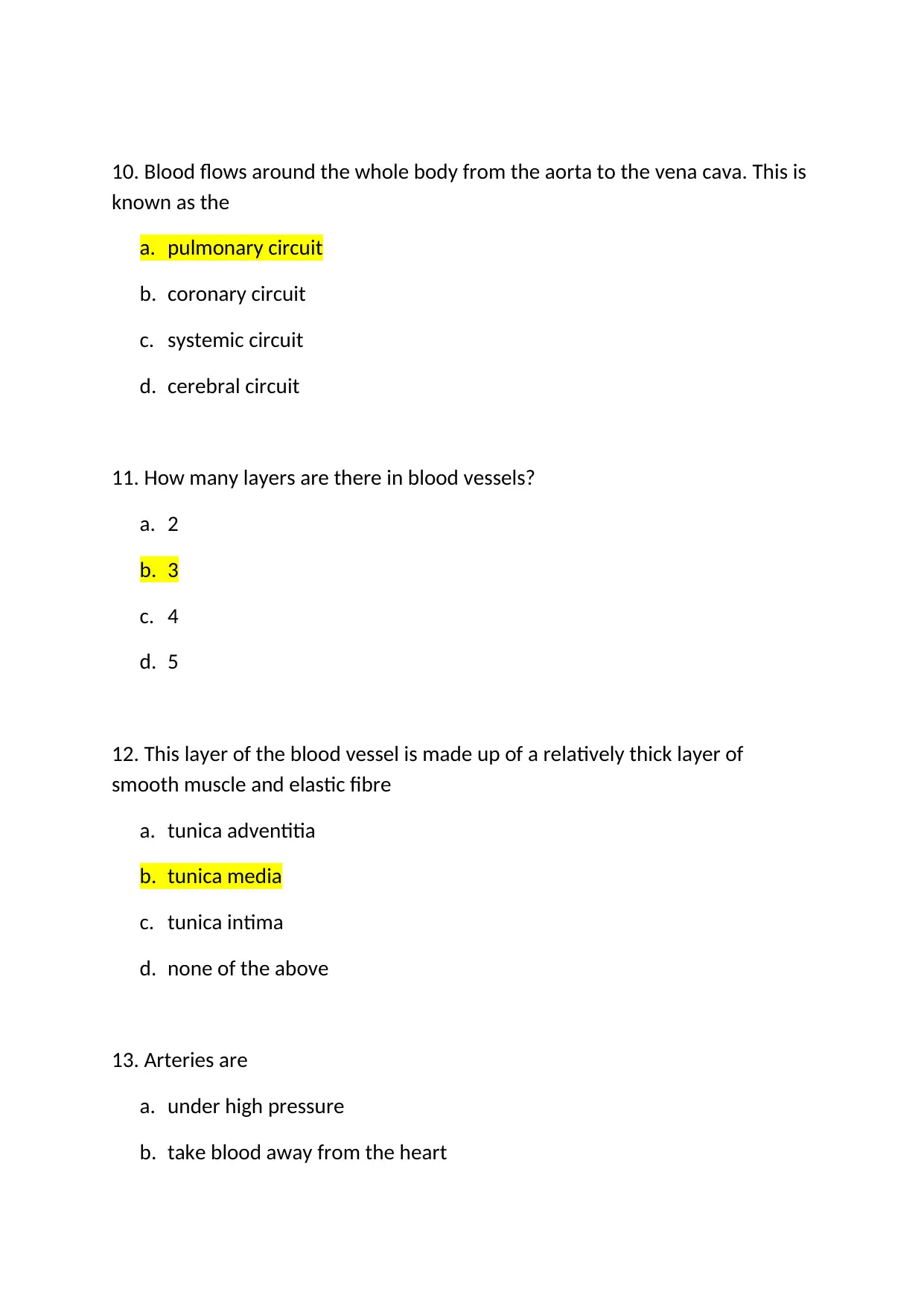
10. Blood flows around the whole body from the aorta to the vena cava. This is
known as the
a. pulmonary circuit
b. coronary circuit
c. systemic circuit
d. cerebral circuit
11. How many layers are there in blood vessels?
a. 2
b. 3
c. 4
d. 5
12. This layer of the blood vessel is made up of a relatively thick layer of
smooth muscle and elastic fibre
a. tunica adventitia
b. tunica media
c. tunica intima
d. none of the above
13. Arteries are
a. under high pressure
b. take blood away from the heart
known as the
a. pulmonary circuit
b. coronary circuit
c. systemic circuit
d. cerebral circuit
11. How many layers are there in blood vessels?
a. 2
b. 3
c. 4
d. 5
12. This layer of the blood vessel is made up of a relatively thick layer of
smooth muscle and elastic fibre
a. tunica adventitia
b. tunica media
c. tunica intima
d. none of the above
13. Arteries are
a. under high pressure
b. take blood away from the heart
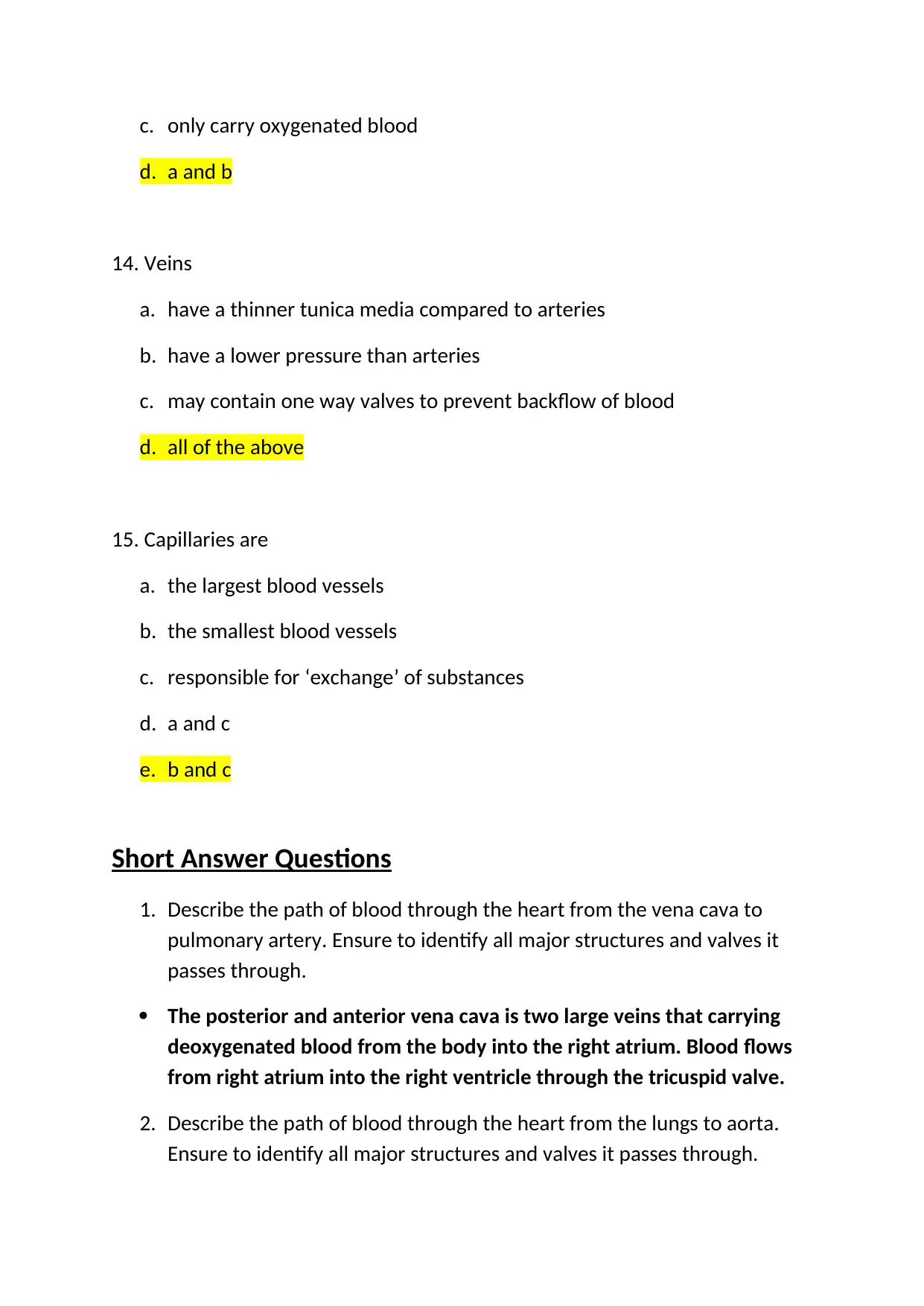
c. only carry oxygenated blood
d. a and b
14. Veins
a. have a thinner tunica media compared to arteries
b. have a lower pressure than arteries
c. may contain one way valves to prevent backflow of blood
d. all of the above
15. Capillaries are
a. the largest blood vessels
b. the smallest blood vessels
c. responsible for ‘exchange’ of substances
d. a and c
e. b and c
Short Answer Questions
1. Describe the path of blood through the heart from the vena cava to
pulmonary artery. Ensure to identify all major structures and valves it
passes through.
The posterior and anterior vena cava is two large veins that carrying
deoxygenated blood from the body into the right atrium. Blood flows
from right atrium into the right ventricle through the tricuspid valve.
2. Describe the path of blood through the heart from the lungs to aorta.
Ensure to identify all major structures and valves it passes through.
d. a and b
14. Veins
a. have a thinner tunica media compared to arteries
b. have a lower pressure than arteries
c. may contain one way valves to prevent backflow of blood
d. all of the above
15. Capillaries are
a. the largest blood vessels
b. the smallest blood vessels
c. responsible for ‘exchange’ of substances
d. a and c
e. b and c
Short Answer Questions
1. Describe the path of blood through the heart from the vena cava to
pulmonary artery. Ensure to identify all major structures and valves it
passes through.
The posterior and anterior vena cava is two large veins that carrying
deoxygenated blood from the body into the right atrium. Blood flows
from right atrium into the right ventricle through the tricuspid valve.
2. Describe the path of blood through the heart from the lungs to aorta.
Ensure to identify all major structures and valves it passes through.
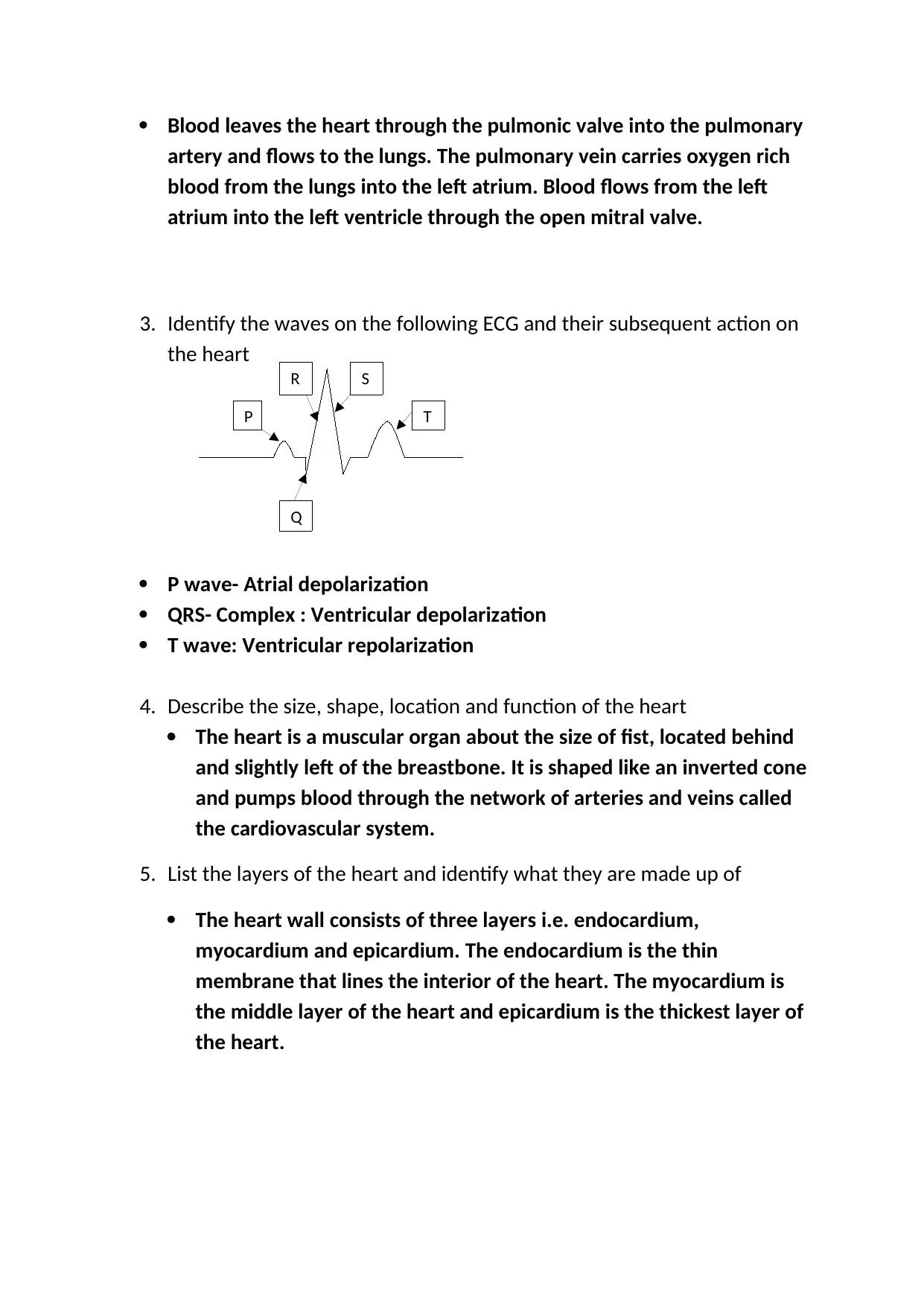
Blood leaves the heart through the pulmonic valve into the pulmonary
artery and flows to the lungs. The pulmonary vein carries oxygen rich
blood from the lungs into the left atrium. Blood flows from the left
atrium into the left ventricle through the open mitral valve.
3. Identify the waves on the following ECG and their subsequent action on
the heart
P wave- Atrial depolarization
QRS- Complex : Ventricular depolarization
T wave: Ventricular repolarization
4. Describe the size, shape, location and function of the heart
The heart is a muscular organ about the size of fist, located behind
and slightly left of the breastbone. It is shaped like an inverted cone
and pumps blood through the network of arteries and veins called
the cardiovascular system.
5. List the layers of the heart and identify what they are made up of
The heart wall consists of three layers i.e. endocardium,
myocardium and epicardium. The endocardium is the thin
membrane that lines the interior of the heart. The myocardium is
the middle layer of the heart and epicardium is the thickest layer of
the heart.
P
Q
R S
T
artery and flows to the lungs. The pulmonary vein carries oxygen rich
blood from the lungs into the left atrium. Blood flows from the left
atrium into the left ventricle through the open mitral valve.
3. Identify the waves on the following ECG and their subsequent action on
the heart
P wave- Atrial depolarization
QRS- Complex : Ventricular depolarization
T wave: Ventricular repolarization
4. Describe the size, shape, location and function of the heart
The heart is a muscular organ about the size of fist, located behind
and slightly left of the breastbone. It is shaped like an inverted cone
and pumps blood through the network of arteries and veins called
the cardiovascular system.
5. List the layers of the heart and identify what they are made up of
The heart wall consists of three layers i.e. endocardium,
myocardium and epicardium. The endocardium is the thin
membrane that lines the interior of the heart. The myocardium is
the middle layer of the heart and epicardium is the thickest layer of
the heart.
P
Q
R S
T
Secure Best Marks with AI Grader
Need help grading? Try our AI Grader for instant feedback on your assignments.
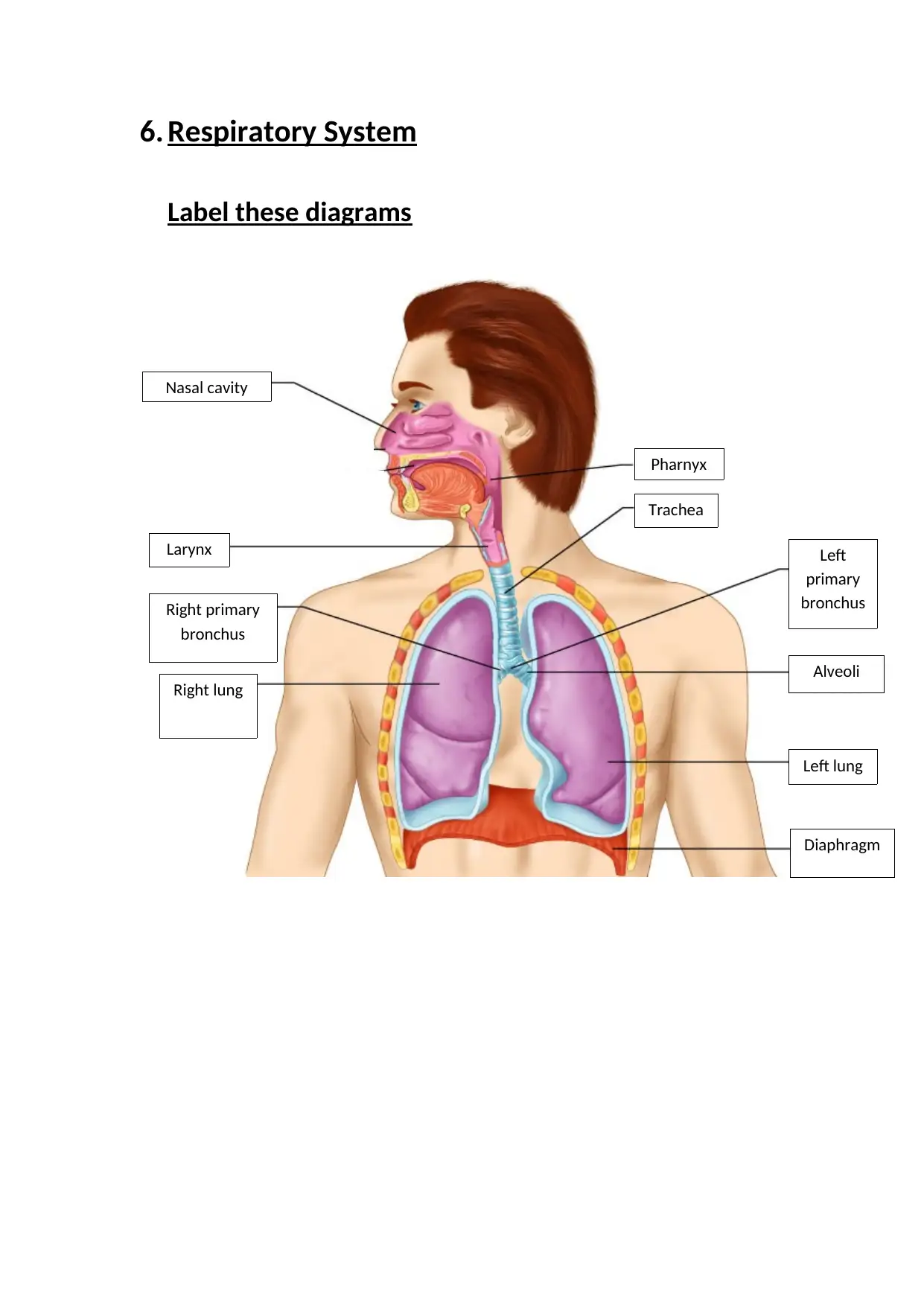
6. Respiratory System
Label these diagrams
Nasal cavity
Pharnyx
Larynx
Trachea
Right primary
bronchus
Right lung
Left
primary
bronchus
Alveoli
Left lung
Diaphragm
Label these diagrams
Nasal cavity
Pharnyx
Larynx
Trachea
Right primary
bronchus
Right lung
Left
primary
bronchus
Alveoli
Left lung
Diaphragm
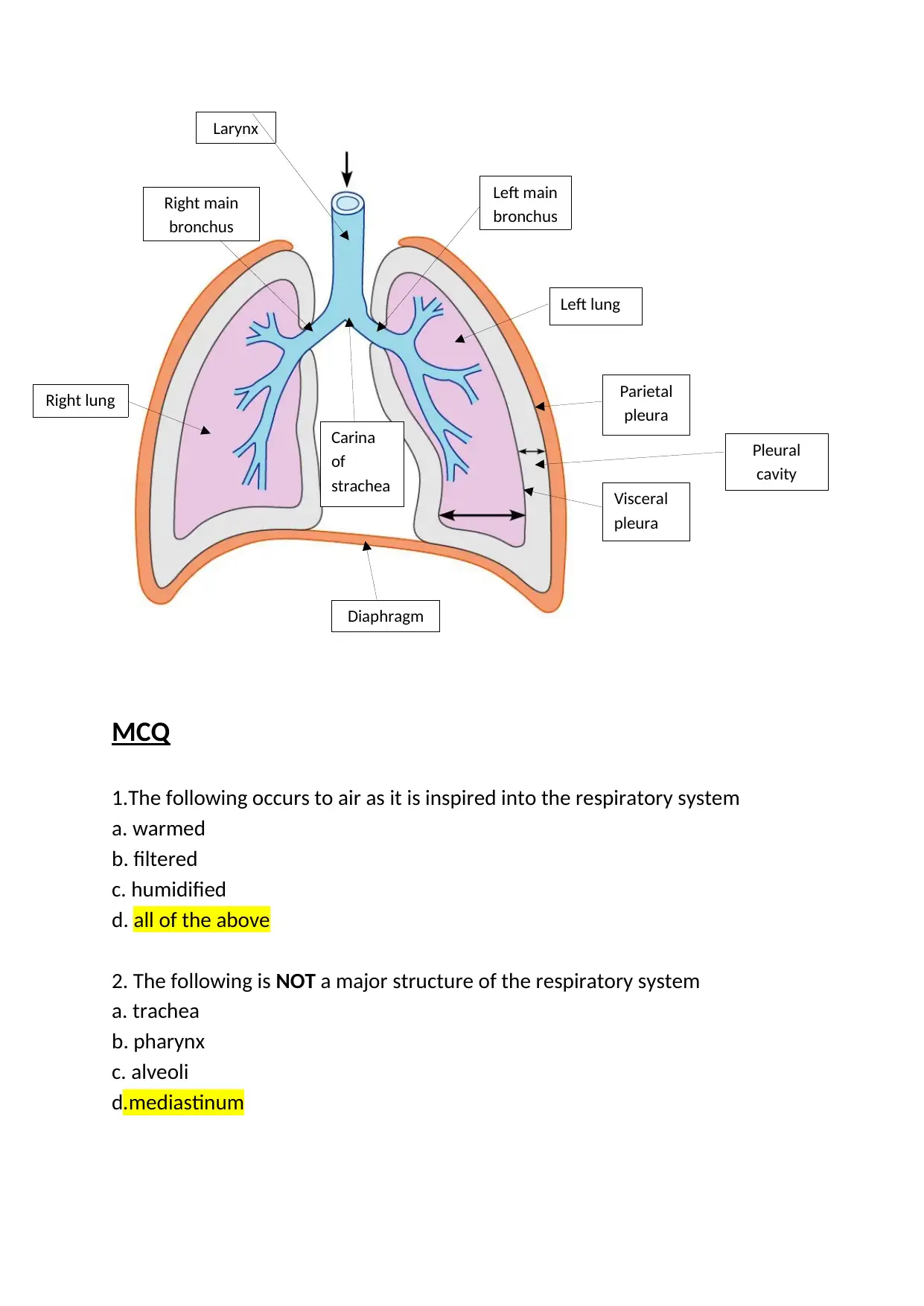
MCQ
1.The following occurs to air as it is inspired into the respiratory system
a. warmed
b. filtered
c. humidified
d. all of the above
2. The following is NOT a major structure of the respiratory system
a. trachea
b. pharynx
c. alveoli
d.mediastinum
Larynx
Right main
bronchus
Left main
bronchus
Diaphragm
Parietal
pleura
Visceral
pleura
Pleural
cavity
Right lung
Left lung
Carina
of
strachea
1.The following occurs to air as it is inspired into the respiratory system
a. warmed
b. filtered
c. humidified
d. all of the above
2. The following is NOT a major structure of the respiratory system
a. trachea
b. pharynx
c. alveoli
d.mediastinum
Larynx
Right main
bronchus
Left main
bronchus
Diaphragm
Parietal
pleura
Visceral
pleura
Pleural
cavity
Right lung
Left lung
Carina
of
strachea
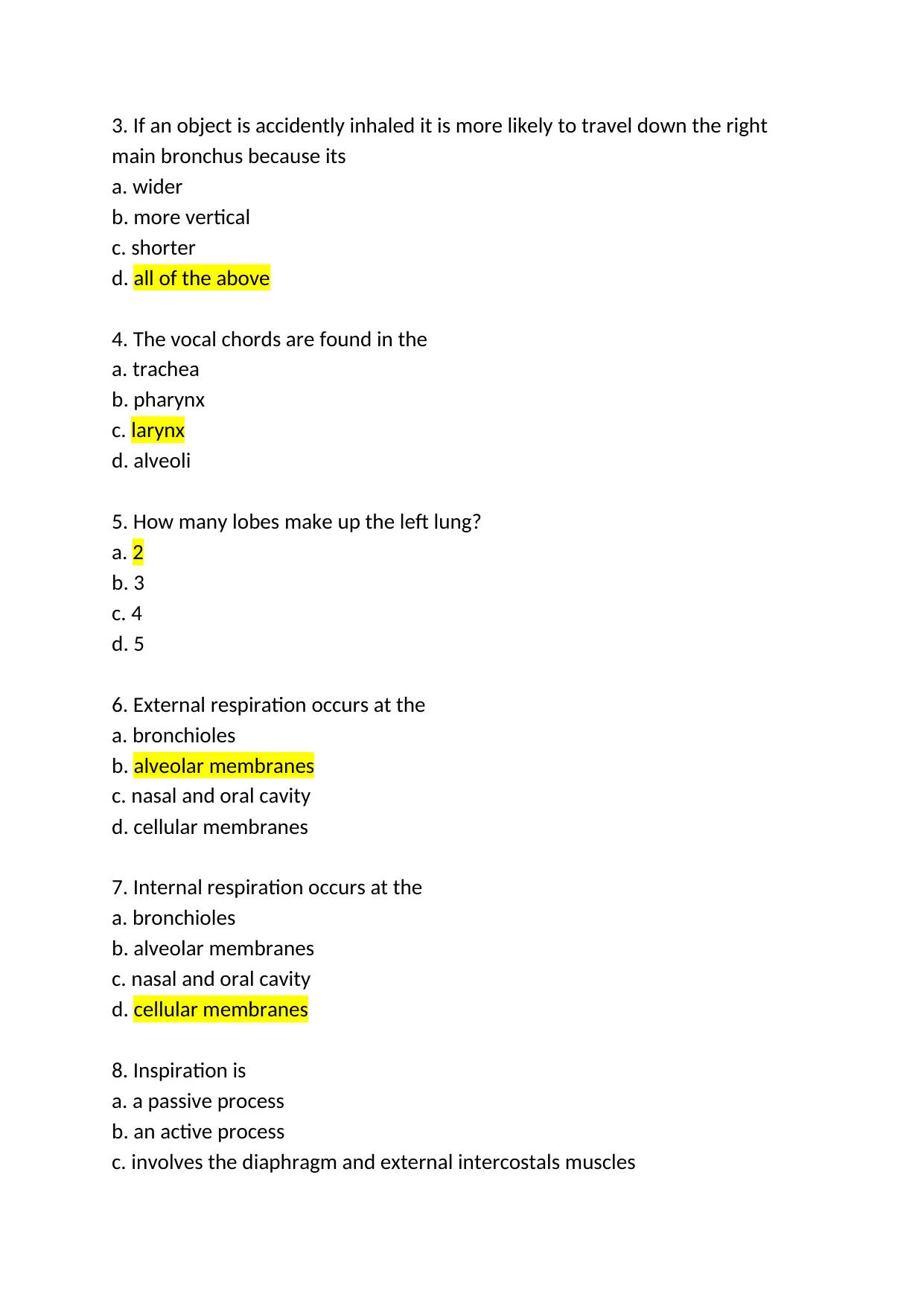
3. If an object is accidently inhaled it is more likely to travel down the right
main bronchus because its
a. wider
b. more vertical
c. shorter
d. all of the above
4. The vocal chords are found in the
a. trachea
b. pharynx
c. larynx
d. alveoli
5. How many lobes make up the left lung?
a. 2
b. 3
c. 4
d. 5
6. External respiration occurs at the
a. bronchioles
b. alveolar membranes
c. nasal and oral cavity
d. cellular membranes
7. Internal respiration occurs at the
a. bronchioles
b. alveolar membranes
c. nasal and oral cavity
d. cellular membranes
8. Inspiration is
a. a passive process
b. an active process
c. involves the diaphragm and external intercostals muscles
main bronchus because its
a. wider
b. more vertical
c. shorter
d. all of the above
4. The vocal chords are found in the
a. trachea
b. pharynx
c. larynx
d. alveoli
5. How many lobes make up the left lung?
a. 2
b. 3
c. 4
d. 5
6. External respiration occurs at the
a. bronchioles
b. alveolar membranes
c. nasal and oral cavity
d. cellular membranes
7. Internal respiration occurs at the
a. bronchioles
b. alveolar membranes
c. nasal and oral cavity
d. cellular membranes
8. Inspiration is
a. a passive process
b. an active process
c. involves the diaphragm and external intercostals muscles
Paraphrase This Document
Need a fresh take? Get an instant paraphrase of this document with our AI Paraphraser
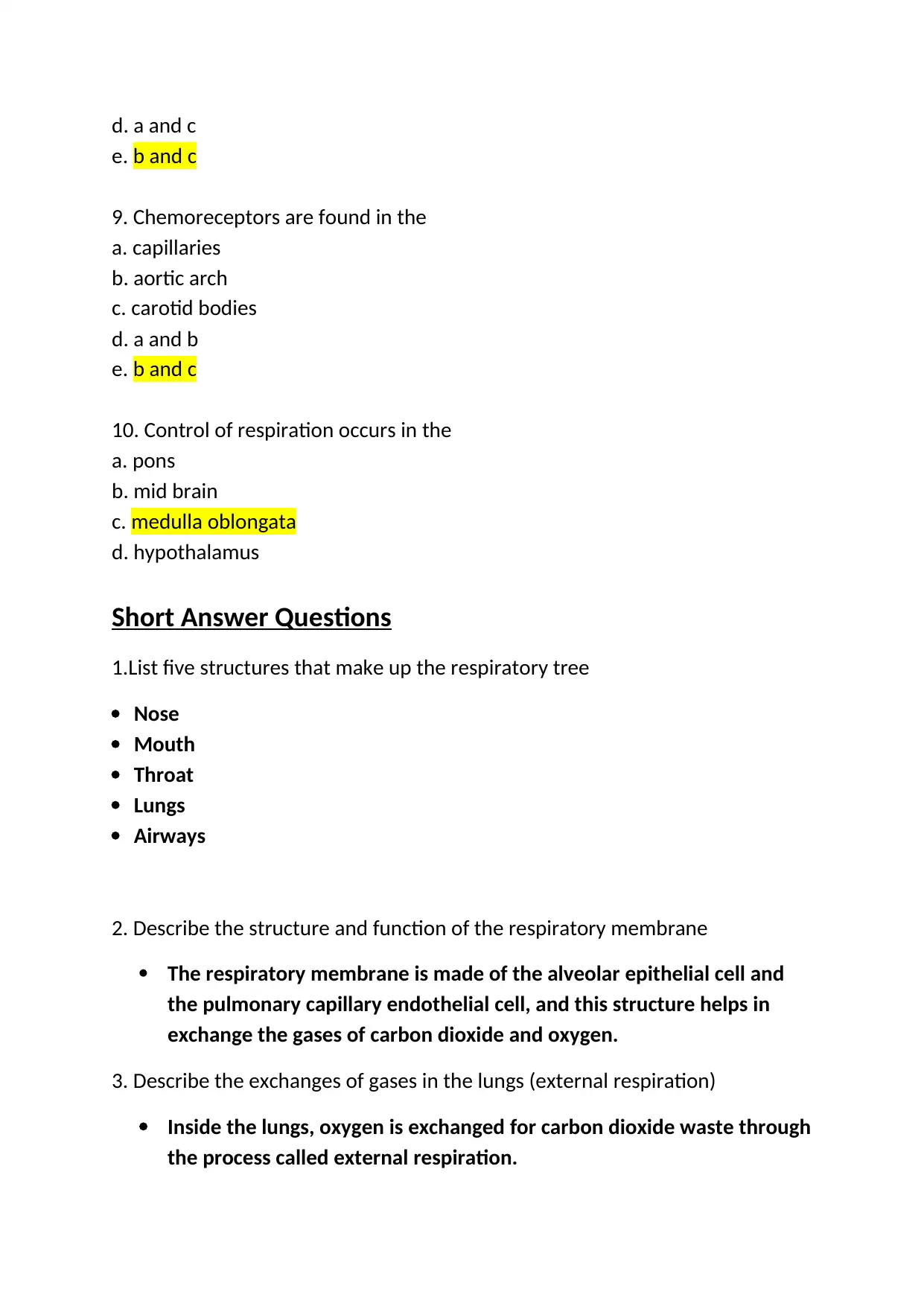
d. a and c
e. b and c
9. Chemoreceptors are found in the
a. capillaries
b. aortic arch
c. carotid bodies
d. a and b
e. b and c
10. Control of respiration occurs in the
a. pons
b. mid brain
c. medulla oblongata
d. hypothalamus
Short Answer Questions
1.List five structures that make up the respiratory tree
Nose
Mouth
Throat
Lungs
Airways
2. Describe the structure and function of the respiratory membrane
The respiratory membrane is made of the alveolar epithelial cell and
the pulmonary capillary endothelial cell, and this structure helps in
exchange the gases of carbon dioxide and oxygen.
3. Describe the exchanges of gases in the lungs (external respiration)
Inside the lungs, oxygen is exchanged for carbon dioxide waste through
the process called external respiration.
e. b and c
9. Chemoreceptors are found in the
a. capillaries
b. aortic arch
c. carotid bodies
d. a and b
e. b and c
10. Control of respiration occurs in the
a. pons
b. mid brain
c. medulla oblongata
d. hypothalamus
Short Answer Questions
1.List five structures that make up the respiratory tree
Nose
Mouth
Throat
Lungs
Airways
2. Describe the structure and function of the respiratory membrane
The respiratory membrane is made of the alveolar epithelial cell and
the pulmonary capillary endothelial cell, and this structure helps in
exchange the gases of carbon dioxide and oxygen.
3. Describe the exchanges of gases in the lungs (external respiration)
Inside the lungs, oxygen is exchanged for carbon dioxide waste through
the process called external respiration.

4. Describe the control of respiration
The medulla oblongata is the primary respiratory control centre.
5. Describe the physiological response of the body to high levels of carbon
dioxide
During exercise, the carbon dioxide level rise in arterial blood. Carbon
dioxide induces vasodilation in the arteries while the heart rate
increases, which leads to better blood flow and tissue perfusion and
better oxygen delivery to the tissues.
7. Renal System
Label these diagrams
Adrenal gland
Right
kidney
Ureter
Urinary
bladder
Renal
artery
Right
renal vein
Arcuate
artery
Renal
pyramid
Renal pelvisUrethra
The medulla oblongata is the primary respiratory control centre.
5. Describe the physiological response of the body to high levels of carbon
dioxide
During exercise, the carbon dioxide level rise in arterial blood. Carbon
dioxide induces vasodilation in the arteries while the heart rate
increases, which leads to better blood flow and tissue perfusion and
better oxygen delivery to the tissues.
7. Renal System
Label these diagrams
Adrenal gland
Right
kidney
Ureter
Urinary
bladder
Renal
artery
Right
renal vein
Arcuate
artery
Renal
pyramid
Renal pelvisUrethra
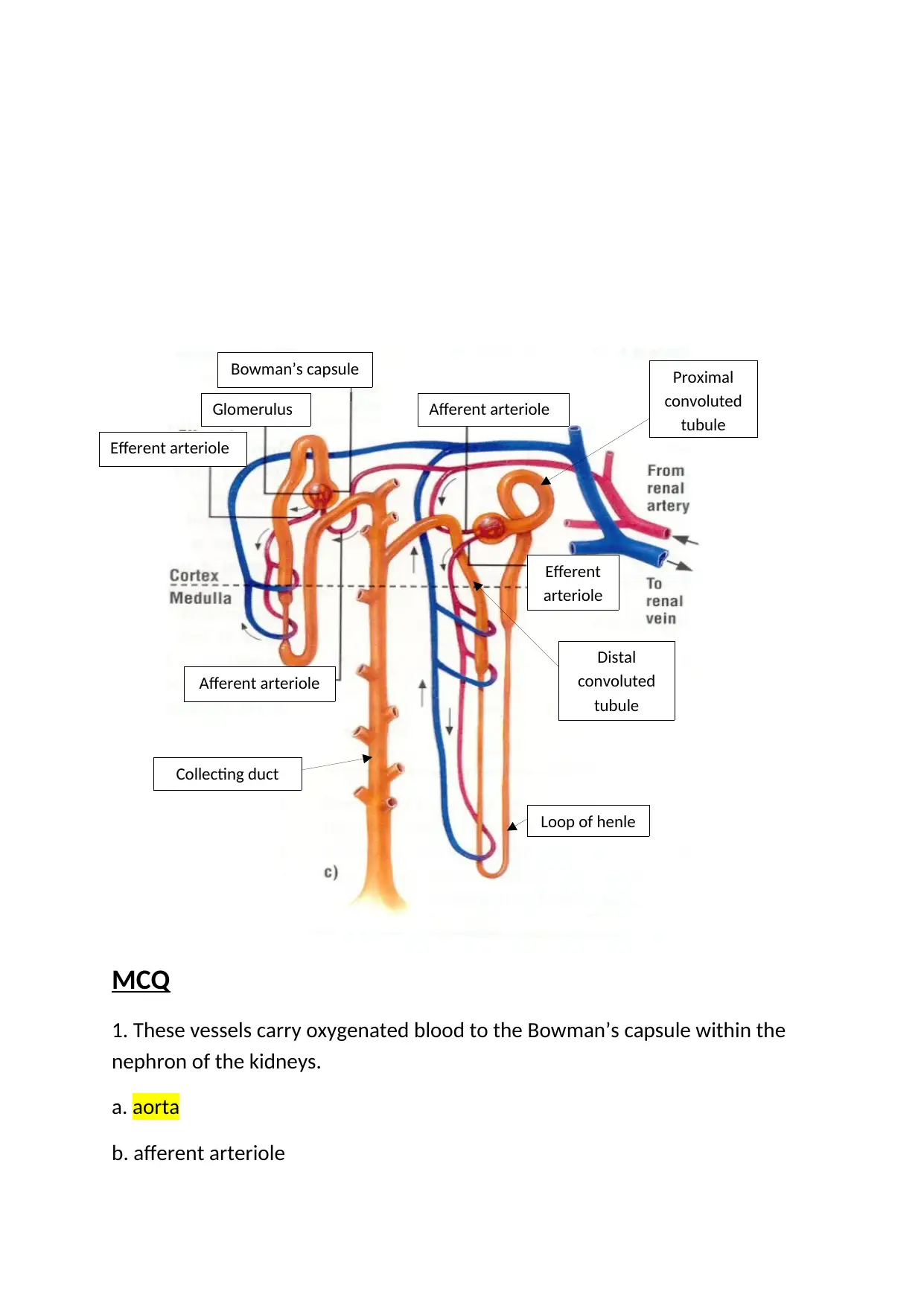
MCQ
1. These vessels carry oxygenated blood to the Bowman’s capsule within the
nephron of the kidneys.
a. aorta
b. afferent arteriole
Bowman’s capsule
Glomerulus
Efferent arteriole
Afferent arteriole
Collecting duct
Proximal
convoluted
tubule
Loop of henle
Distal
convoluted
tubule
Efferent
arteriole
Afferent arteriole
1. These vessels carry oxygenated blood to the Bowman’s capsule within the
nephron of the kidneys.
a. aorta
b. afferent arteriole
Bowman’s capsule
Glomerulus
Efferent arteriole
Afferent arteriole
Collecting duct
Proximal
convoluted
tubule
Loop of henle
Distal
convoluted
tubule
Efferent
arteriole
Afferent arteriole
Secure Best Marks with AI Grader
Need help grading? Try our AI Grader for instant feedback on your assignments.

c. afferent arteriole
d. hepatic artery
2. These vessels carry oxygenated blood away from the Bowman’s capsule
within the nephron of the kidneys.
a. aorta
b. afferent arteriole
c. efferent arteriole
d. hepatic artery
3. Most of the nutrients in the filtrate are reabsorbed from the
a. proximal convoluted tubule
b. distal convoluted tubule
c. loop of Henle
d. glomerular capsule
4. Which of the following empties urine directly into the renal pelvis?
a. ureter
b. renal papilla
c. major calyx
d. minor calyx
5. The tube that carries urine from the kidney to the urinary bladder is the
a. urethra
d. hepatic artery
2. These vessels carry oxygenated blood away from the Bowman’s capsule
within the nephron of the kidneys.
a. aorta
b. afferent arteriole
c. efferent arteriole
d. hepatic artery
3. Most of the nutrients in the filtrate are reabsorbed from the
a. proximal convoluted tubule
b. distal convoluted tubule
c. loop of Henle
d. glomerular capsule
4. Which of the following empties urine directly into the renal pelvis?
a. ureter
b. renal papilla
c. major calyx
d. minor calyx
5. The tube that carries urine from the kidney to the urinary bladder is the
a. urethra

b. ureter
c. collecting duct
d. renal vein
6. Which of the following structures is not part of the nephron?
a. distal convoluted tubule
b. glomerulus
c. loop of Henle
d. collecting duct
7. Which of the following substances would not be found in normal filtrate?
a. albumin
b. glucose
c. potassium
d. urea
8. When glucose spills over into the urine it has
a. been secreted
b. been filtered and secreted
c. exceeded its transport maximum
d. been completely cleared
from the blood
9. Which of the following would be an abnormal constituent of urine?
c. collecting duct
d. renal vein
6. Which of the following structures is not part of the nephron?
a. distal convoluted tubule
b. glomerulus
c. loop of Henle
d. collecting duct
7. Which of the following substances would not be found in normal filtrate?
a. albumin
b. glucose
c. potassium
d. urea
8. When glucose spills over into the urine it has
a. been secreted
b. been filtered and secreted
c. exceeded its transport maximum
d. been completely cleared
from the blood
9. Which of the following would be an abnormal constituent of urine?
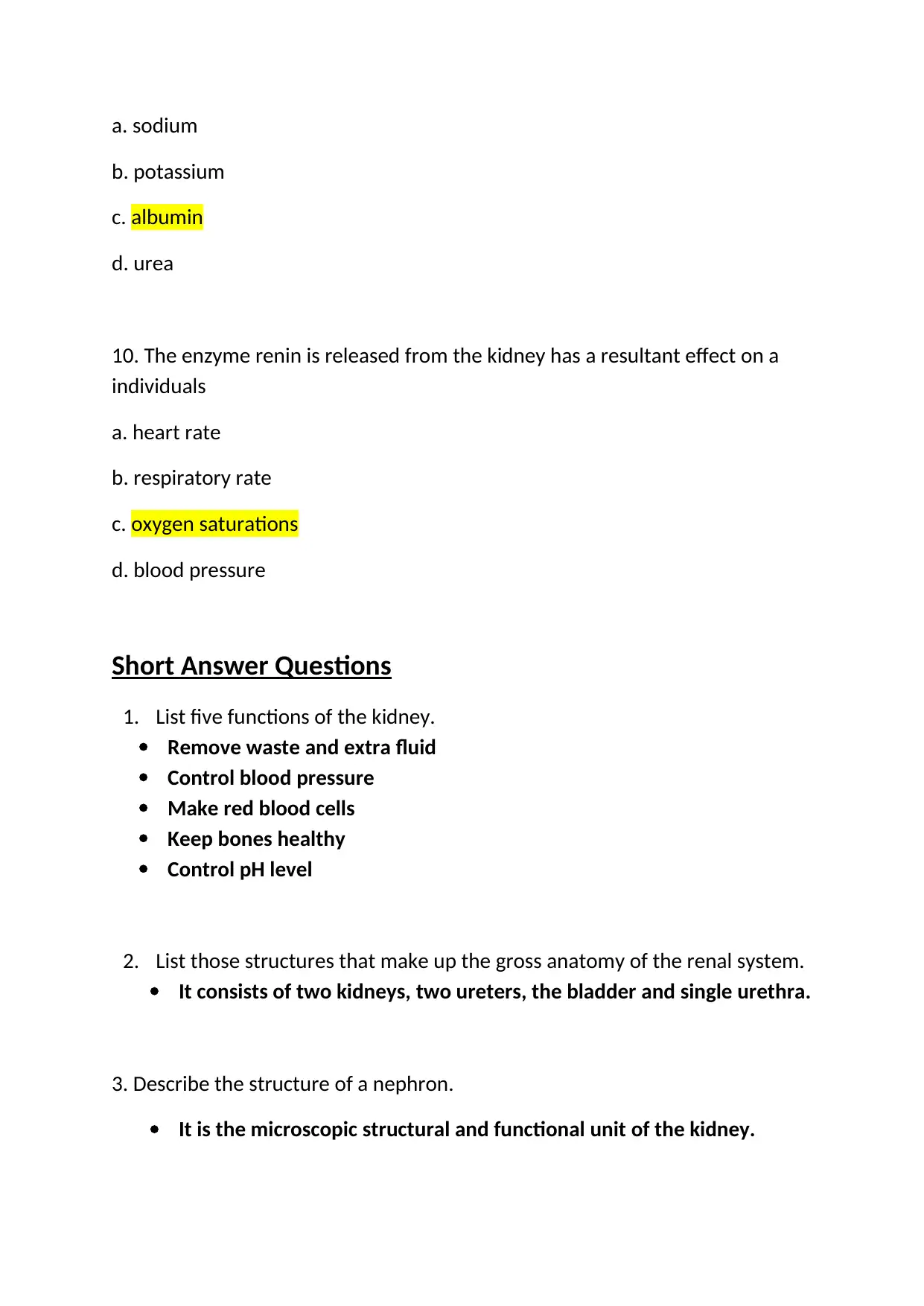
a. sodium
b. potassium
c. albumin
d. urea
10. The enzyme renin is released from the kidney has a resultant effect on a
individuals
a. heart rate
b. respiratory rate
c. oxygen saturations
d. blood pressure
Short Answer Questions
1. List five functions of the kidney.
Remove waste and extra fluid
Control blood pressure
Make red blood cells
Keep bones healthy
Control pH level
2. List those structures that make up the gross anatomy of the renal system.
It consists of two kidneys, two ureters, the bladder and single urethra.
3. Describe the structure of a nephron.
It is the microscopic structural and functional unit of the kidney.
b. potassium
c. albumin
d. urea
10. The enzyme renin is released from the kidney has a resultant effect on a
individuals
a. heart rate
b. respiratory rate
c. oxygen saturations
d. blood pressure
Short Answer Questions
1. List five functions of the kidney.
Remove waste and extra fluid
Control blood pressure
Make red blood cells
Keep bones healthy
Control pH level
2. List those structures that make up the gross anatomy of the renal system.
It consists of two kidneys, two ureters, the bladder and single urethra.
3. Describe the structure of a nephron.
It is the microscopic structural and functional unit of the kidney.
Paraphrase This Document
Need a fresh take? Get an instant paraphrase of this document with our AI Paraphraser
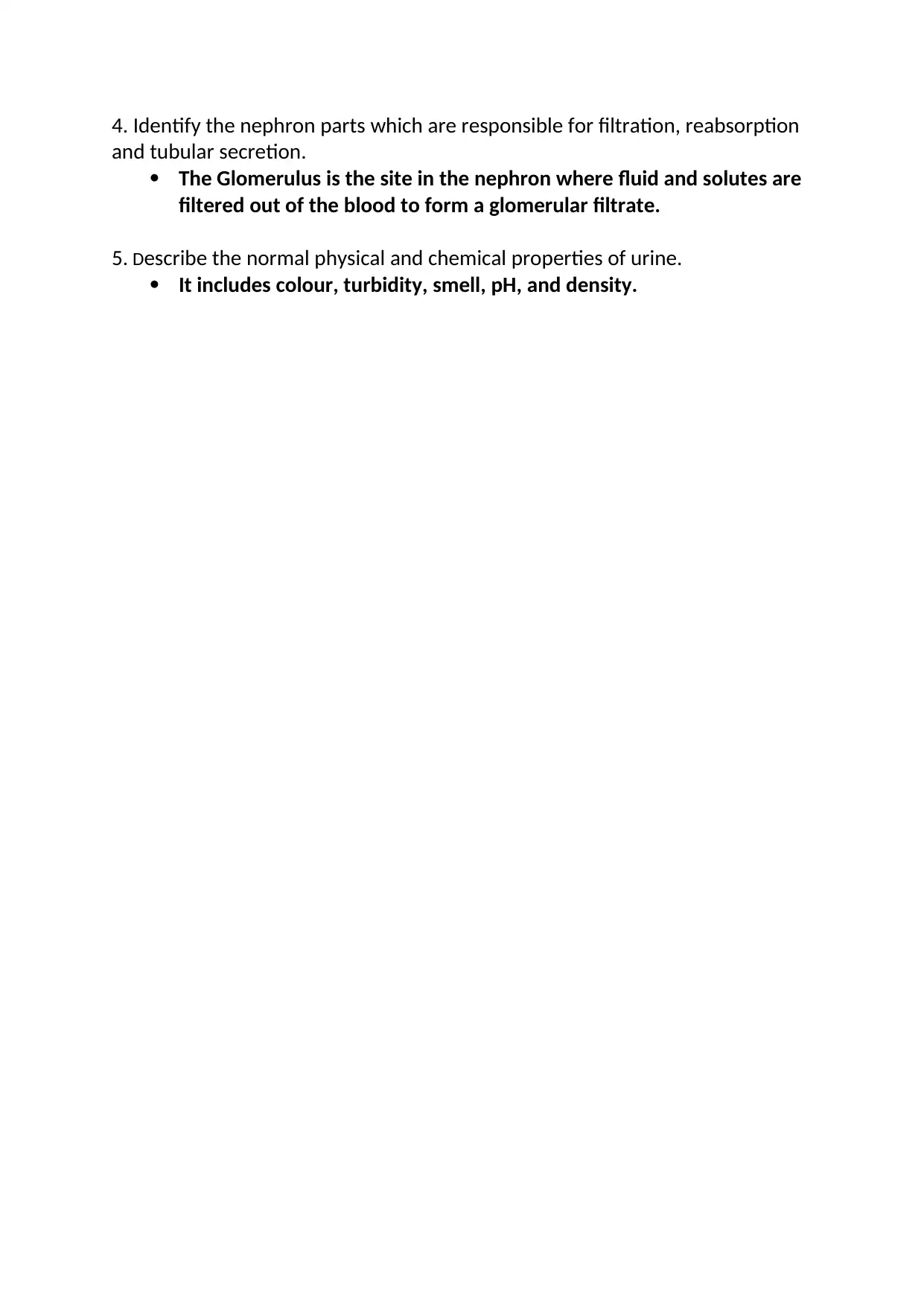
4. Identify the nephron parts which are responsible for filtration, reabsorption
and tubular secretion.
The Glomerulus is the site in the nephron where fluid and solutes are
filtered out of the blood to form a glomerular filtrate.
5. Describe the normal physical and chemical properties of urine.
It includes colour, turbidity, smell, pH, and density.
and tubular secretion.
The Glomerulus is the site in the nephron where fluid and solutes are
filtered out of the blood to form a glomerular filtrate.
5. Describe the normal physical and chemical properties of urine.
It includes colour, turbidity, smell, pH, and density.

8.Gastrointestinal System
Label these diagrams
Salivary glands
Epiglotis
Stomach
Liver
Gall bladder
Small
intestine
Large
intestine
Anus
Spleen
Pancreas
Label these diagrams
Salivary glands
Epiglotis
Stomach
Liver
Gall bladder
Small
intestine
Large
intestine
Anus
Spleen
Pancreas
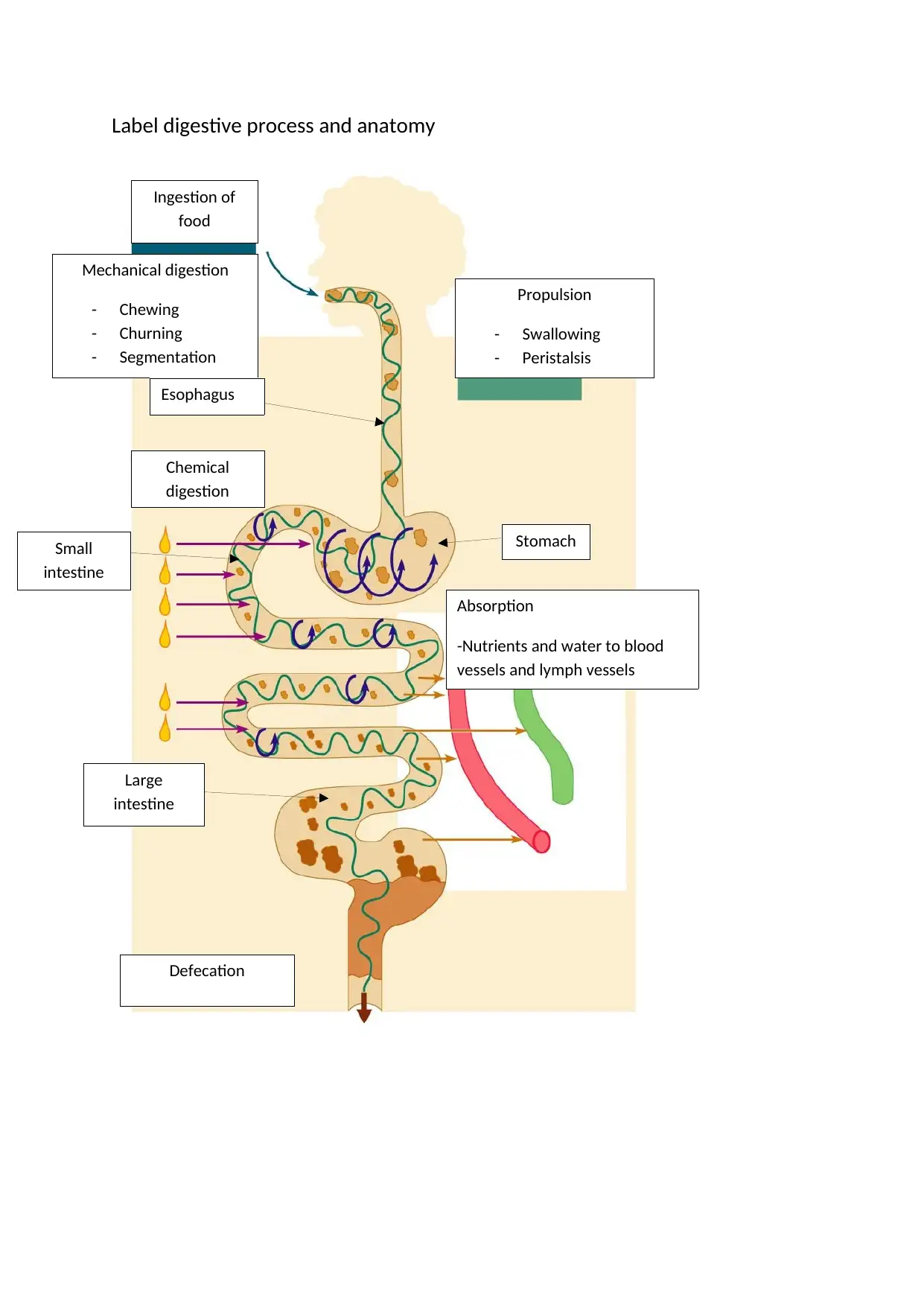
Label digestive process and anatomy
Ingestion of
food
Mechanical digestion
- Chewing
- Churning
- Segmentation
Propulsion
- Swallowing
- Peristalsis
Chemical
digestion
Absorption
-Nutrients and water to blood
vessels and lymph vessels
Defecation
Stomach
Esophagus
Small
intestine
Large
intestine
Ingestion of
food
Mechanical digestion
- Chewing
- Churning
- Segmentation
Propulsion
- Swallowing
- Peristalsis
Chemical
digestion
Absorption
-Nutrients and water to blood
vessels and lymph vessels
Defecation
Stomach
Esophagus
Small
intestine
Large
intestine
Secure Best Marks with AI Grader
Need help grading? Try our AI Grader for instant feedback on your assignments.
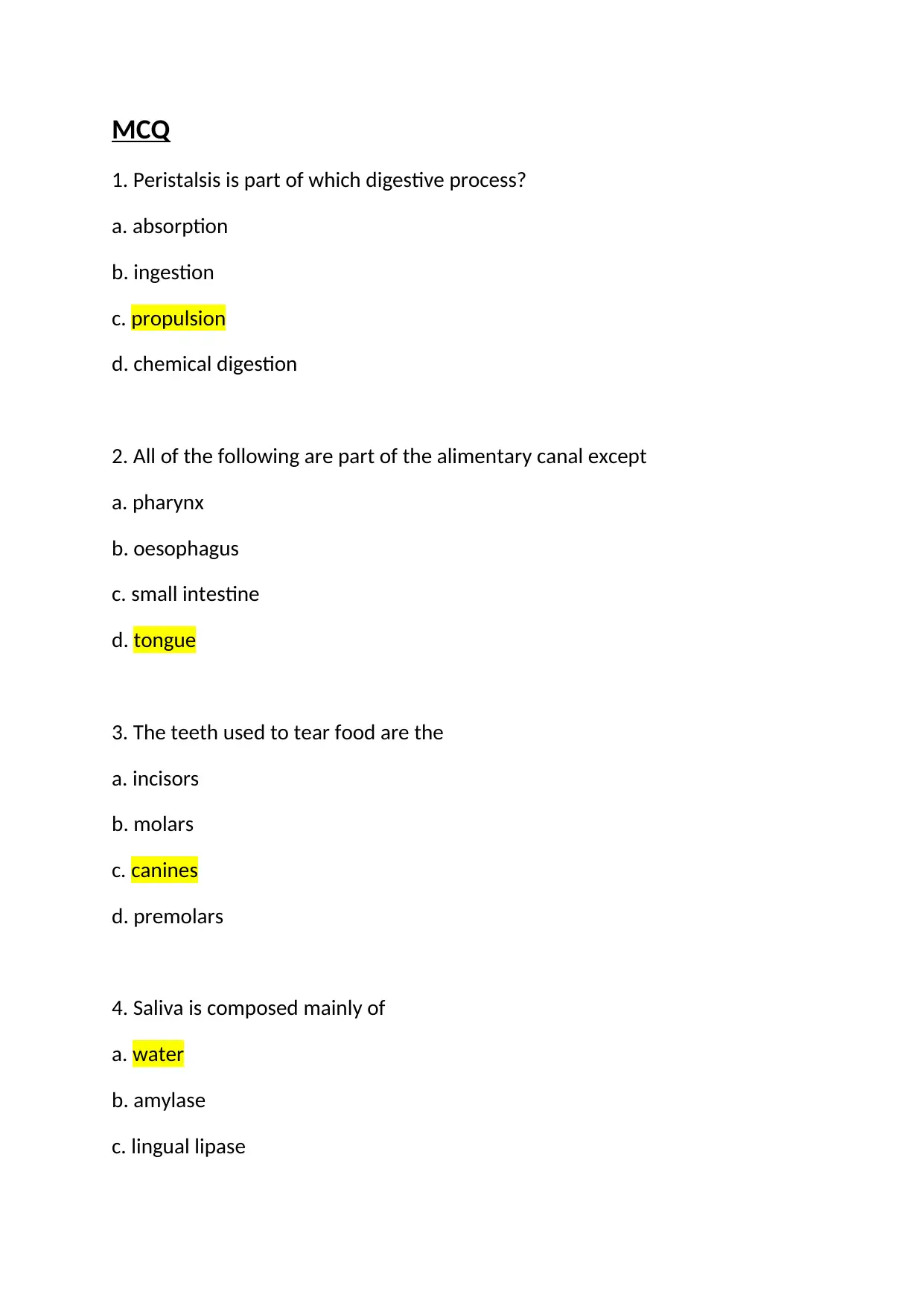
MCQ
1. Peristalsis is part of which digestive process?
a. absorption
b. ingestion
c. propulsion
d. chemical digestion
2. All of the following are part of the alimentary canal except
a. pharynx
b. oesophagus
c. small intestine
d. tongue
3. The teeth used to tear food are the
a. incisors
b. molars
c. canines
d. premolars
4. Saliva is composed mainly of
a. water
b. amylase
c. lingual lipase
1. Peristalsis is part of which digestive process?
a. absorption
b. ingestion
c. propulsion
d. chemical digestion
2. All of the following are part of the alimentary canal except
a. pharynx
b. oesophagus
c. small intestine
d. tongue
3. The teeth used to tear food are the
a. incisors
b. molars
c. canines
d. premolars
4. Saliva is composed mainly of
a. water
b. amylase
c. lingual lipase
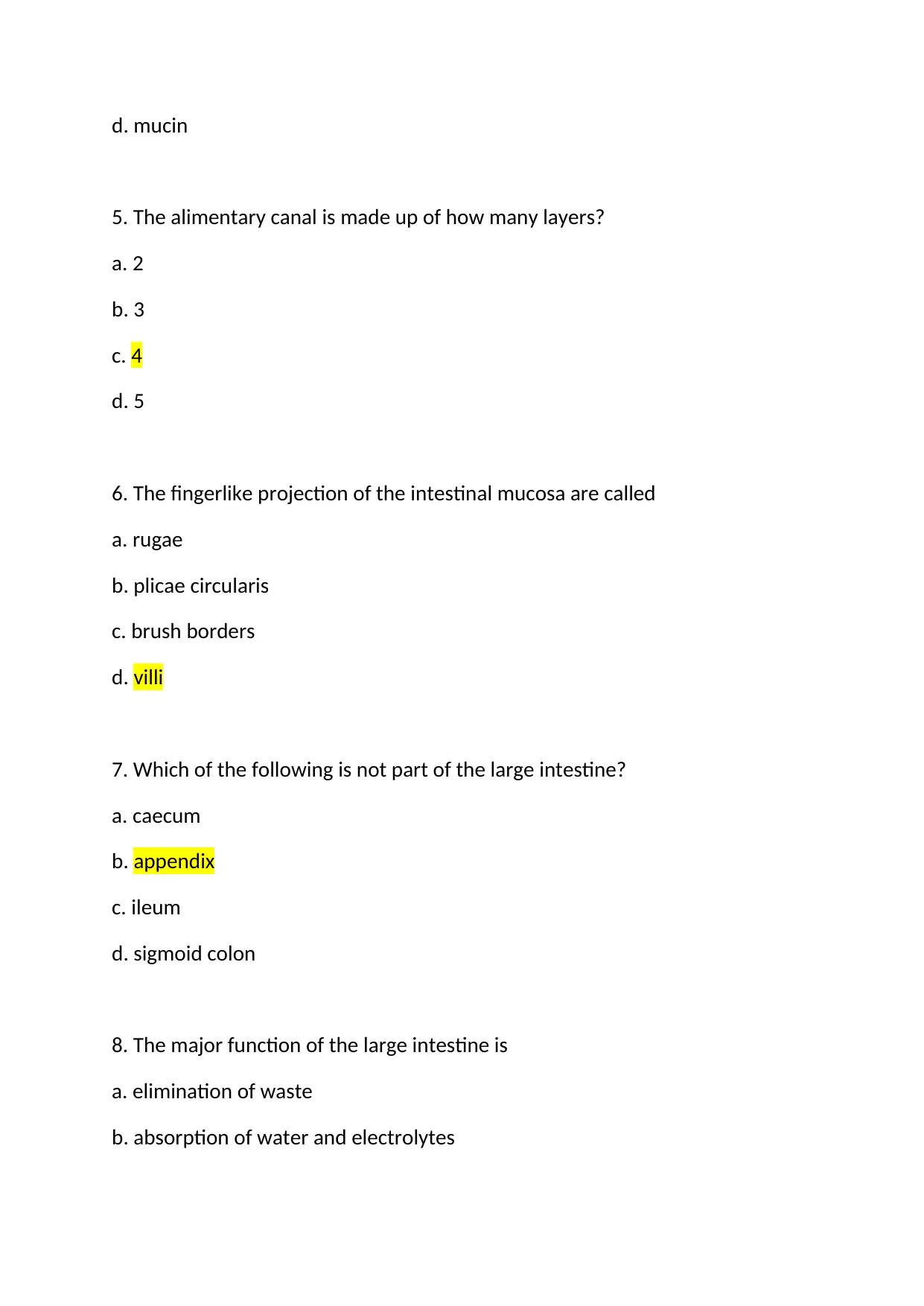
d. mucin
5. The alimentary canal is made up of how many layers?
a. 2
b. 3
c. 4
d. 5
6. The fingerlike projection of the intestinal mucosa are called
a. rugae
b. plicae circularis
c. brush borders
d. villi
7. Which of the following is not part of the large intestine?
a. caecum
b. appendix
c. ileum
d. sigmoid colon
8. The major function of the large intestine is
a. elimination of waste
b. absorption of water and electrolytes
5. The alimentary canal is made up of how many layers?
a. 2
b. 3
c. 4
d. 5
6. The fingerlike projection of the intestinal mucosa are called
a. rugae
b. plicae circularis
c. brush borders
d. villi
7. Which of the following is not part of the large intestine?
a. caecum
b. appendix
c. ileum
d. sigmoid colon
8. The major function of the large intestine is
a. elimination of waste
b. absorption of water and electrolytes
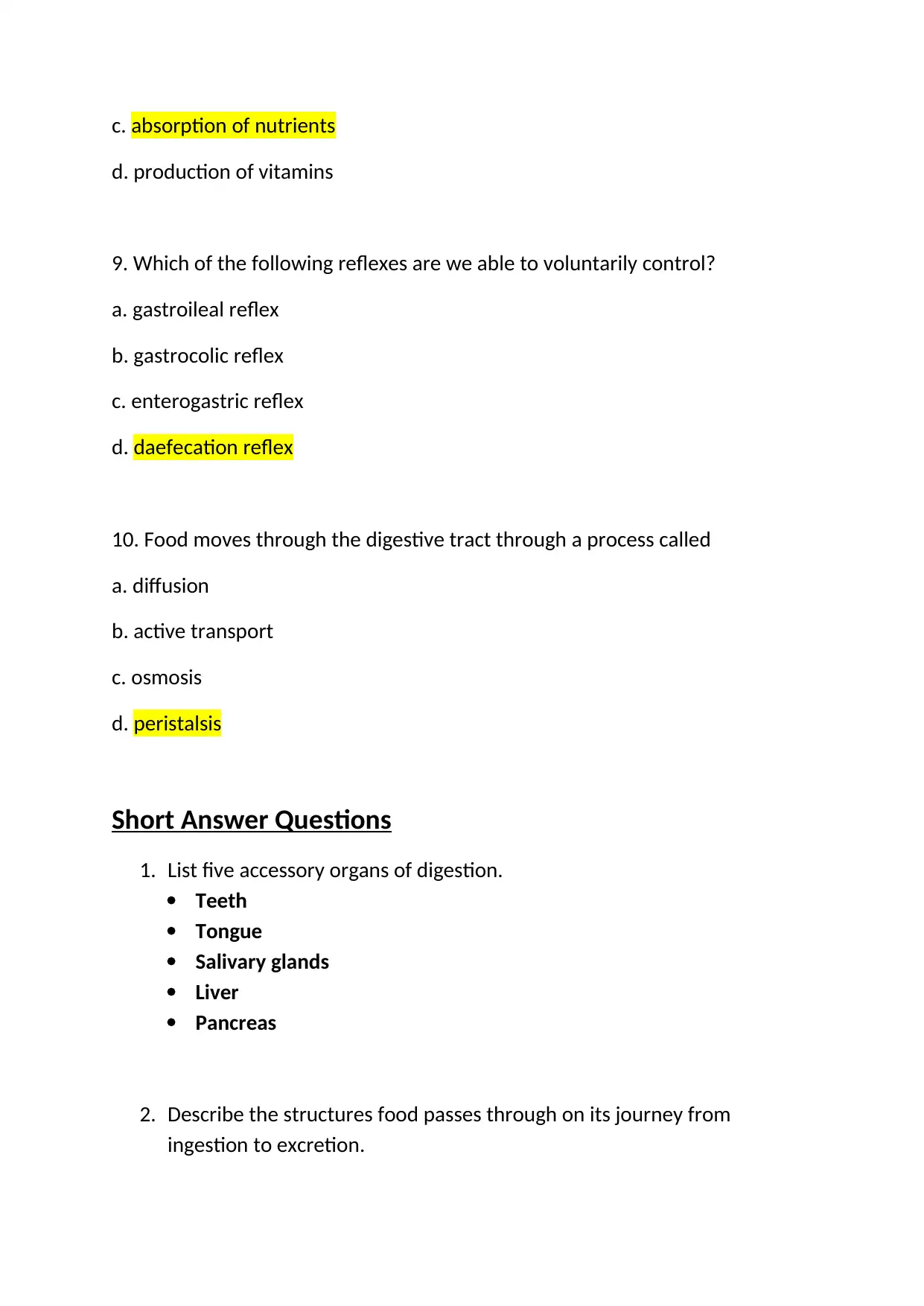
c. absorption of nutrients
d. production of vitamins
9. Which of the following reflexes are we able to voluntarily control?
a. gastroileal reflex
b. gastrocolic reflex
c. enterogastric reflex
d. daefecation reflex
10. Food moves through the digestive tract through a process called
a. diffusion
b. active transport
c. osmosis
d. peristalsis
Short Answer Questions
1. List five accessory organs of digestion.
Teeth
Tongue
Salivary glands
Liver
Pancreas
2. Describe the structures food passes through on its journey from
ingestion to excretion.
d. production of vitamins
9. Which of the following reflexes are we able to voluntarily control?
a. gastroileal reflex
b. gastrocolic reflex
c. enterogastric reflex
d. daefecation reflex
10. Food moves through the digestive tract through a process called
a. diffusion
b. active transport
c. osmosis
d. peristalsis
Short Answer Questions
1. List five accessory organs of digestion.
Teeth
Tongue
Salivary glands
Liver
Pancreas
2. Describe the structures food passes through on its journey from
ingestion to excretion.
Paraphrase This Document
Need a fresh take? Get an instant paraphrase of this document with our AI Paraphraser
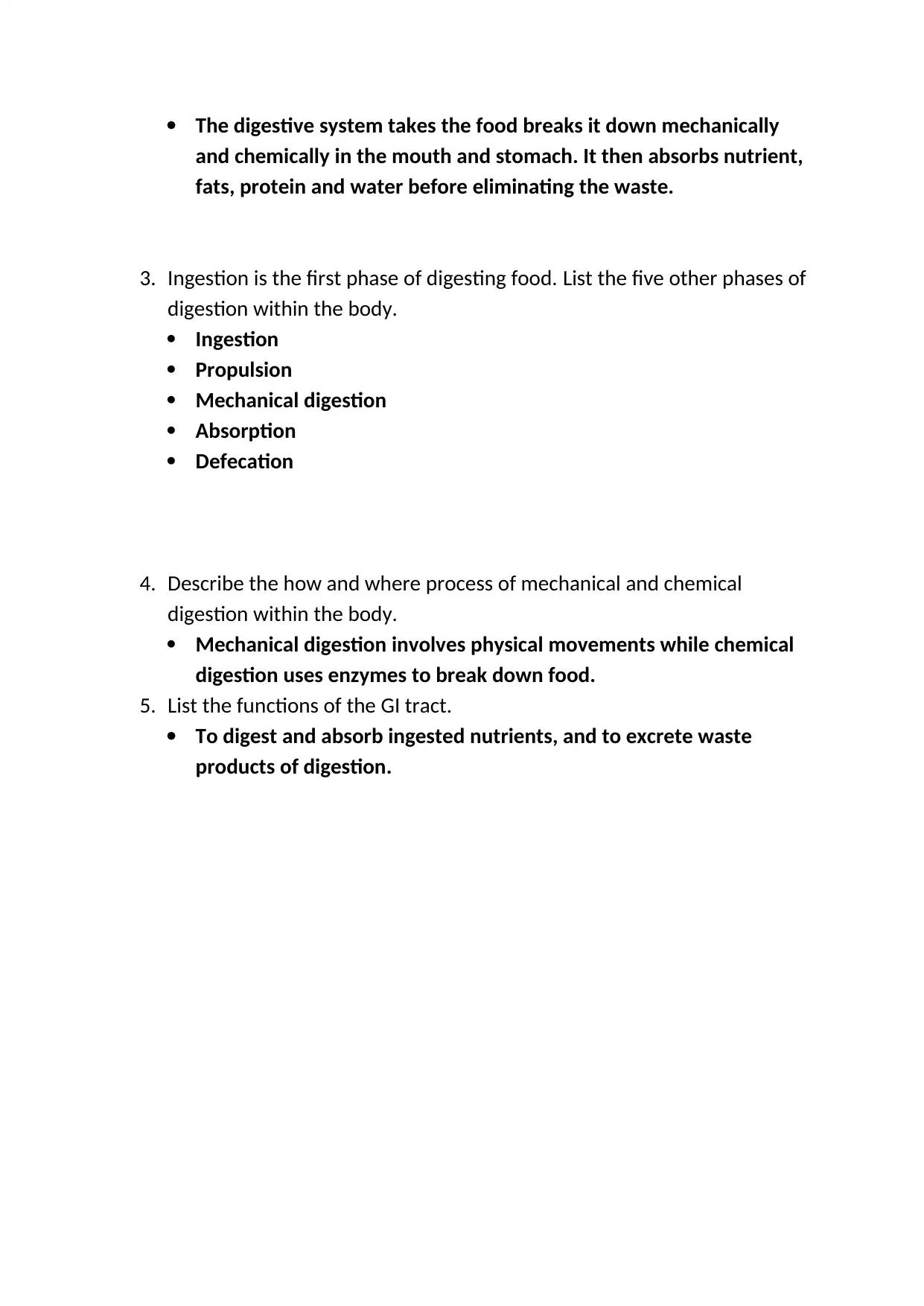
The digestive system takes the food breaks it down mechanically
and chemically in the mouth and stomach. It then absorbs nutrient,
fats, protein and water before eliminating the waste.
3. Ingestion is the first phase of digesting food. List the five other phases of
digestion within the body.
Ingestion
Propulsion
Mechanical digestion
Absorption
Defecation
4. Describe the how and where process of mechanical and chemical
digestion within the body.
Mechanical digestion involves physical movements while chemical
digestion uses enzymes to break down food.
5. List the functions of the GI tract.
To digest and absorb ingested nutrients, and to excrete waste
products of digestion.
and chemically in the mouth and stomach. It then absorbs nutrient,
fats, protein and water before eliminating the waste.
3. Ingestion is the first phase of digesting food. List the five other phases of
digestion within the body.
Ingestion
Propulsion
Mechanical digestion
Absorption
Defecation
4. Describe the how and where process of mechanical and chemical
digestion within the body.
Mechanical digestion involves physical movements while chemical
digestion uses enzymes to break down food.
5. List the functions of the GI tract.
To digest and absorb ingested nutrients, and to excrete waste
products of digestion.
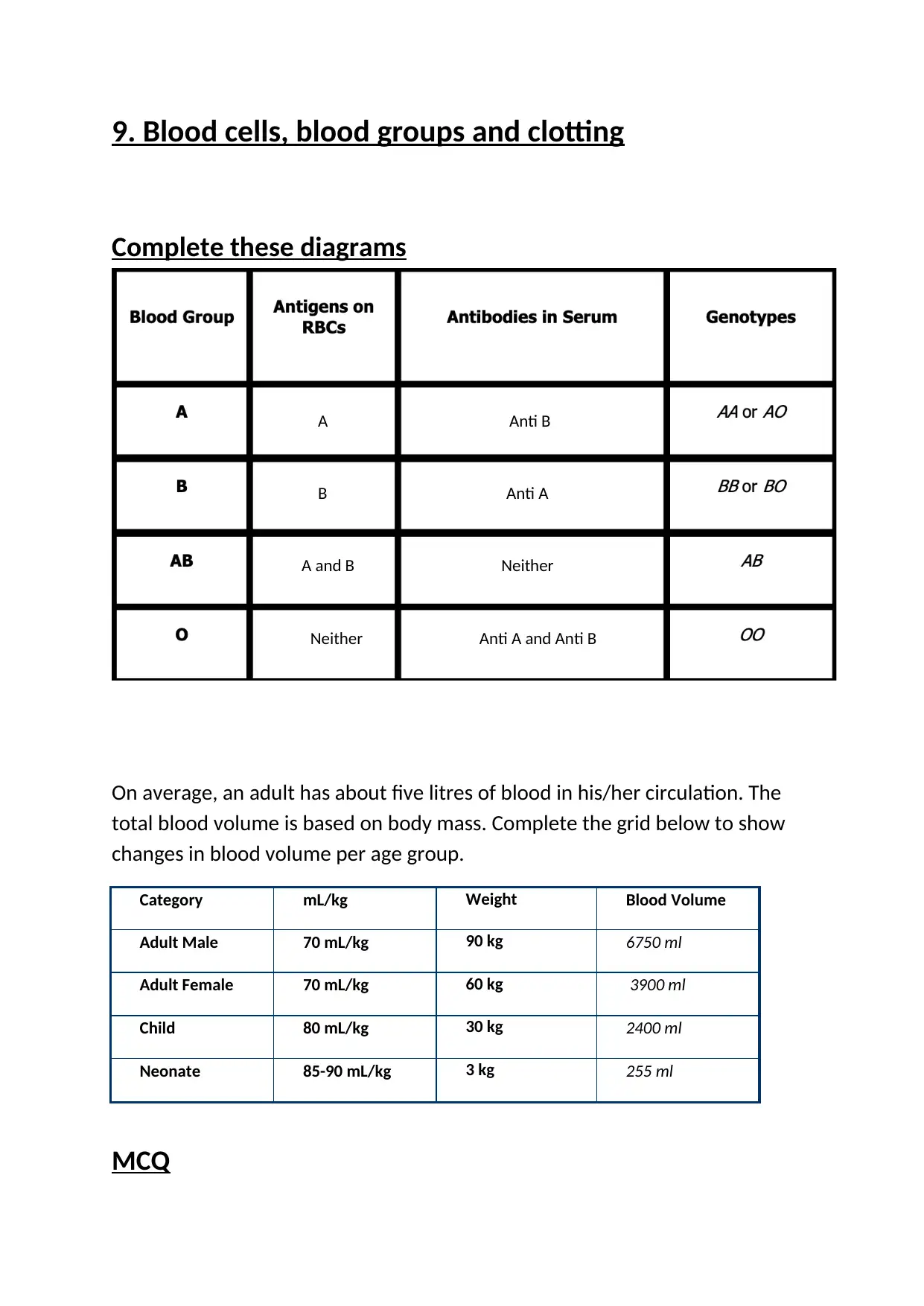
9. Blood cells, blood groups and clotting
Complete these diagrams
On average, an adult has about five litres of blood in his/her circulation. The
total blood volume is based on body mass. Complete the grid below to show
changes in blood volume per age group.
Category mL/kg Weight Blood Volume
Adult Male 70 mL/kg 90 kg 6750 ml
Adult Female 70 mL/kg 60 kg 3900 ml
Child 80 mL/kg 30 kg 2400 ml
Neonate 85-90 mL/kg 3 kg 255 ml
MCQ
A
B
A and B
Neither
Anti B
Anti A
Neither
Anti A and Anti B
Complete these diagrams
On average, an adult has about five litres of blood in his/her circulation. The
total blood volume is based on body mass. Complete the grid below to show
changes in blood volume per age group.
Category mL/kg Weight Blood Volume
Adult Male 70 mL/kg 90 kg 6750 ml
Adult Female 70 mL/kg 60 kg 3900 ml
Child 80 mL/kg 30 kg 2400 ml
Neonate 85-90 mL/kg 3 kg 255 ml
MCQ
A
B
A and B
Neither
Anti B
Anti A
Neither
Anti A and Anti B

1. The blood group known as the universal donar is
a. A
b. B
c. AB
d.O
2. The blood group known as the universal recipient is
a. A
b. B
c. AB
d. O
3. Another word for a red blood cell is
a. leukocyte
b. erythrocyte
c. thrombocyte
d. platelet
4. Another word for a white blood cell is
a. leukocyte
b. erythrocyte
c. thrombocyte
d. platelet
a. A
b. B
c. AB
d.O
2. The blood group known as the universal recipient is
a. A
b. B
c. AB
d. O
3. Another word for a red blood cell is
a. leukocyte
b. erythrocyte
c. thrombocyte
d. platelet
4. Another word for a white blood cell is
a. leukocyte
b. erythrocyte
c. thrombocyte
d. platelet
Secure Best Marks with AI Grader
Need help grading? Try our AI Grader for instant feedback on your assignments.
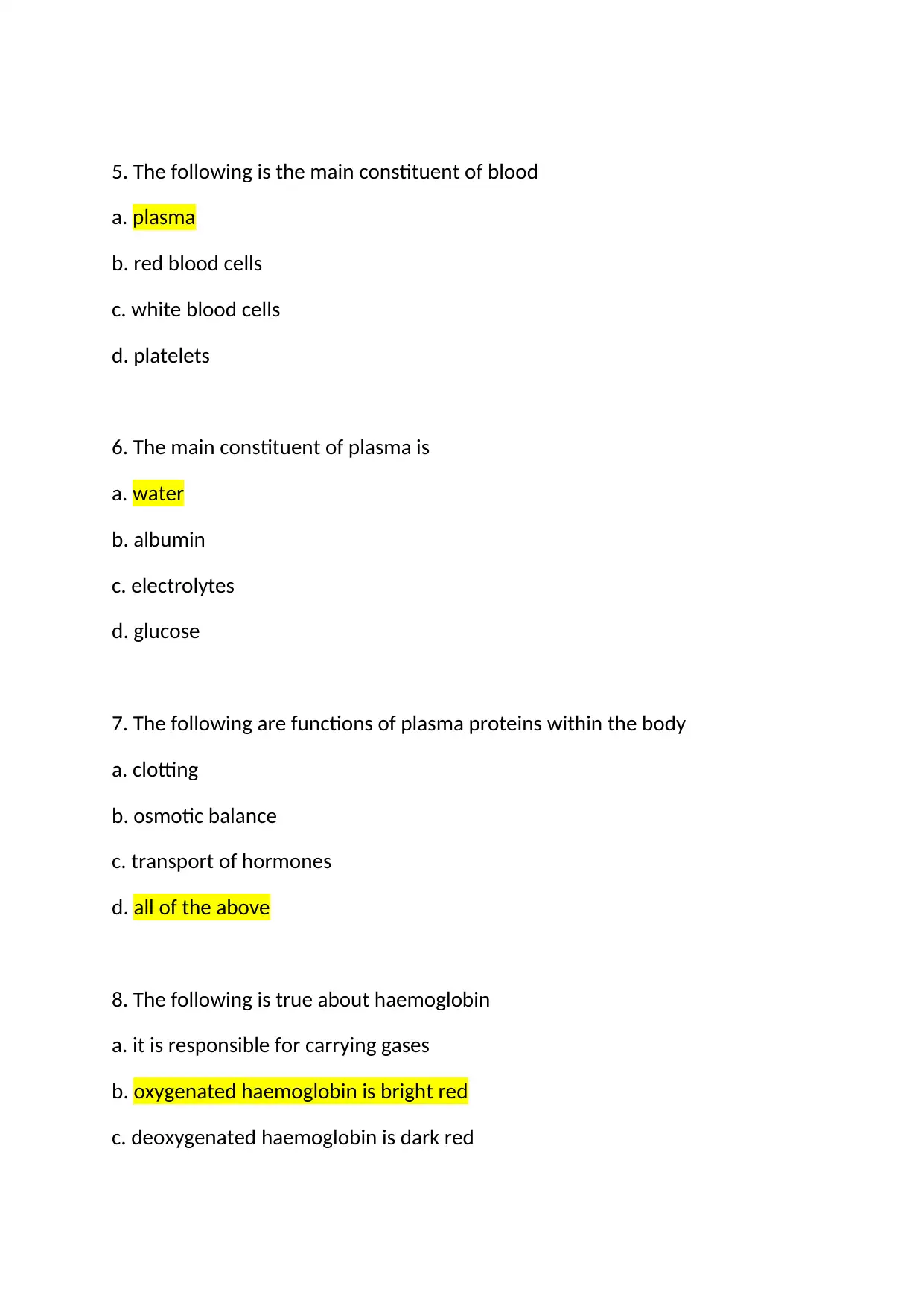
5. The following is the main constituent of blood
a. plasma
b. red blood cells
c. white blood cells
d. platelets
6. The main constituent of plasma is
a. water
b. albumin
c. electrolytes
d. glucose
7. The following are functions of plasma proteins within the body
a. clotting
b. osmotic balance
c. transport of hormones
d. all of the above
8. The following is true about haemoglobin
a. it is responsible for carrying gases
b. oxygenated haemoglobin is bright red
c. deoxygenated haemoglobin is dark red
a. plasma
b. red blood cells
c. white blood cells
d. platelets
6. The main constituent of plasma is
a. water
b. albumin
c. electrolytes
d. glucose
7. The following are functions of plasma proteins within the body
a. clotting
b. osmotic balance
c. transport of hormones
d. all of the above
8. The following is true about haemoglobin
a. it is responsible for carrying gases
b. oxygenated haemoglobin is bright red
c. deoxygenated haemoglobin is dark red
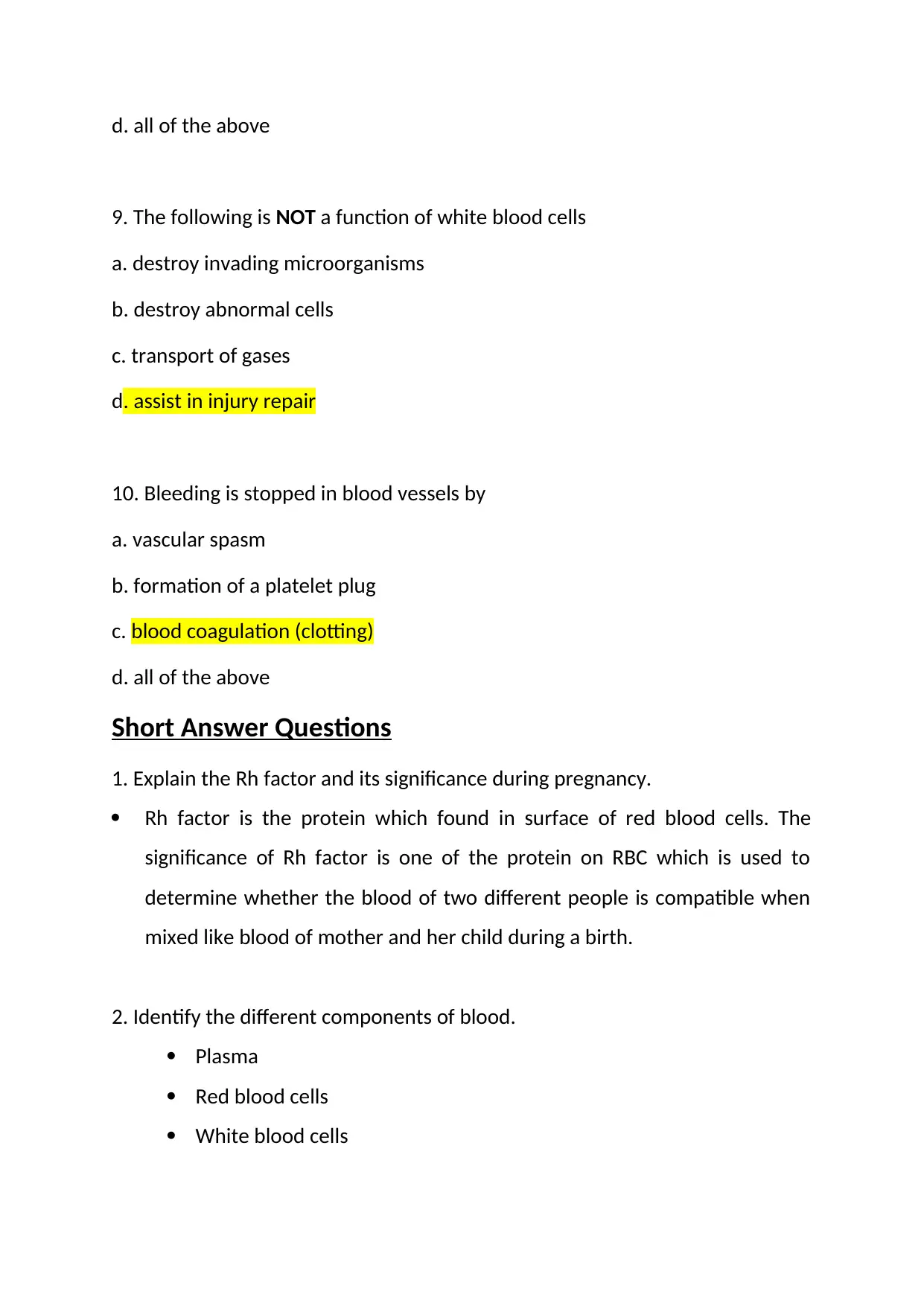
d. all of the above
9. The following is NOT a function of white blood cells
a. destroy invading microorganisms
b. destroy abnormal cells
c. transport of gases
d. assist in injury repair
10. Bleeding is stopped in blood vessels by
a. vascular spasm
b. formation of a platelet plug
c. blood coagulation (clotting)
d. all of the above
Short Answer Questions
1. Explain the Rh factor and its significance during pregnancy.
Rh factor is the protein which found in surface of red blood cells. The
significance of Rh factor is one of the protein on RBC which is used to
determine whether the blood of two different people is compatible when
mixed like blood of mother and her child during a birth.
2. Identify the different components of blood.
Plasma
Red blood cells
White blood cells
9. The following is NOT a function of white blood cells
a. destroy invading microorganisms
b. destroy abnormal cells
c. transport of gases
d. assist in injury repair
10. Bleeding is stopped in blood vessels by
a. vascular spasm
b. formation of a platelet plug
c. blood coagulation (clotting)
d. all of the above
Short Answer Questions
1. Explain the Rh factor and its significance during pregnancy.
Rh factor is the protein which found in surface of red blood cells. The
significance of Rh factor is one of the protein on RBC which is used to
determine whether the blood of two different people is compatible when
mixed like blood of mother and her child during a birth.
2. Identify the different components of blood.
Plasma
Red blood cells
White blood cells

3. List the functions of blood cells and plasma.
Blood cells:
It is used to carry oxygen from the lungs to body tissue and CO2 as a
waste product.
Also, RBC are important blood cell where hemoglobin is found that
carries out oxygen from lungs to all parts of body.
Plasma
Carry out water, salts and enzymes where plasma take nutrients and
hormones to that body part where it needed.
It helps in remove he waste from body.
4.Describe the clotting process. Hemostasis is way method through which body can stop the blood
vessels from bleeding. Its main purpose is to clotting of blood and also,
body needs to control the mechanism to control and limit clotting.
Further, it includes dissolving the excess clots which are not needed.
Sometimes this bleeding cannot be control by hemostasis and that is
why, it is it is life-threatening.
5. Identify the various leucocytes and explain the functions of each type.
leucocytes Functions
Monocytes It helps in break down bacteria
among body
Lymphocytes It create antibodies to fight against
bacteria, virus and other
potentially harmful invaders
Neutrophils Assist to protect body when
infection strikes and digest bacteria
and fungi
Blood cells:
It is used to carry oxygen from the lungs to body tissue and CO2 as a
waste product.
Also, RBC are important blood cell where hemoglobin is found that
carries out oxygen from lungs to all parts of body.
Plasma
Carry out water, salts and enzymes where plasma take nutrients and
hormones to that body part where it needed.
It helps in remove he waste from body.
4.Describe the clotting process. Hemostasis is way method through which body can stop the blood
vessels from bleeding. Its main purpose is to clotting of blood and also,
body needs to control the mechanism to control and limit clotting.
Further, it includes dissolving the excess clots which are not needed.
Sometimes this bleeding cannot be control by hemostasis and that is
why, it is it is life-threatening.
5. Identify the various leucocytes and explain the functions of each type.
leucocytes Functions
Monocytes It helps in break down bacteria
among body
Lymphocytes It create antibodies to fight against
bacteria, virus and other
potentially harmful invaders
Neutrophils Assist to protect body when
infection strikes and digest bacteria
and fungi
Paraphrase This Document
Need a fresh take? Get an instant paraphrase of this document with our AI Paraphraser
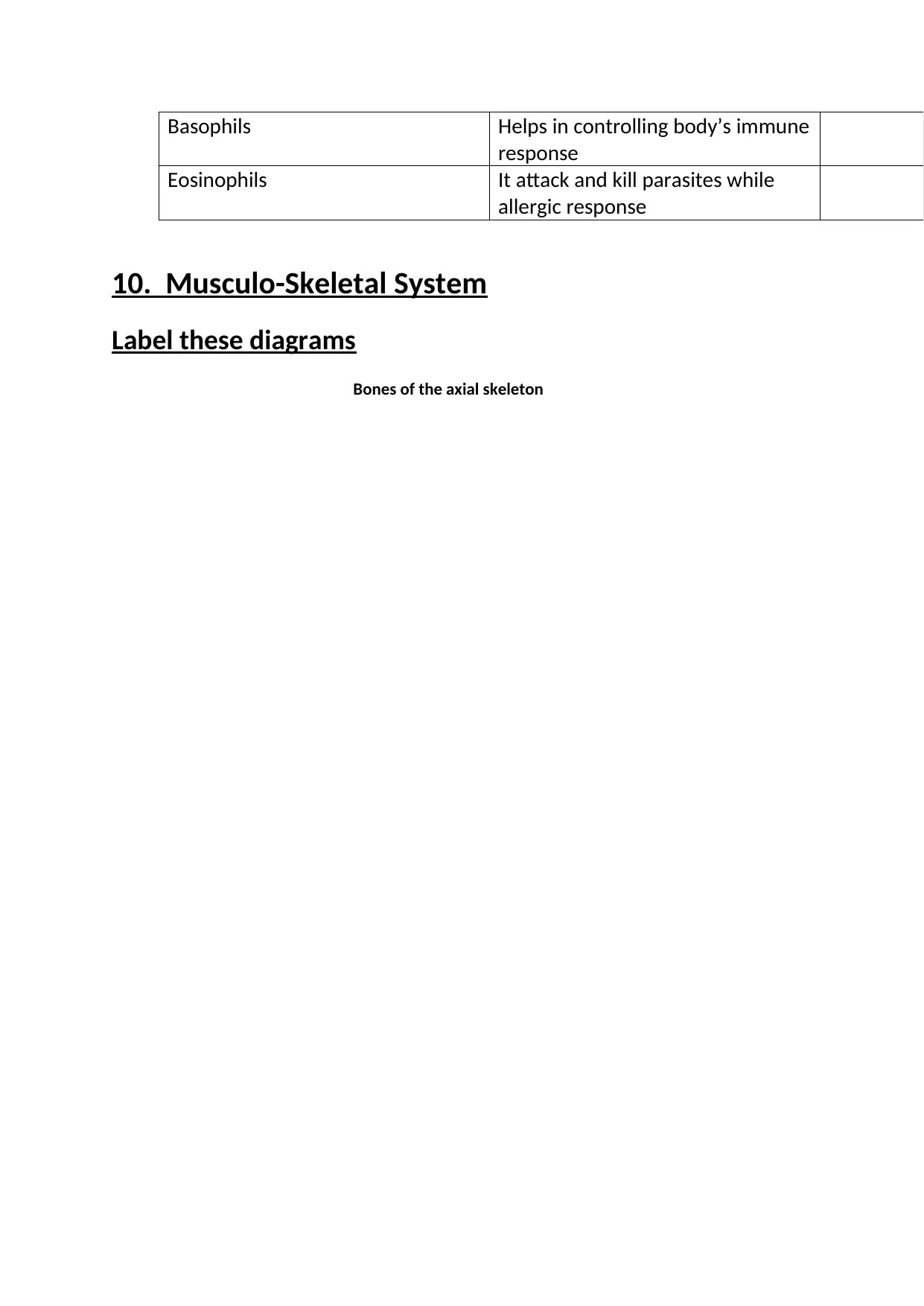
Basophils Helps in controlling body’s immune
response
Eosinophils It attack and kill parasites while
allergic response
10. Musculo-Skeletal System
Label these diagrams
Bones of the axial skeleton
response
Eosinophils It attack and kill parasites while
allergic response
10. Musculo-Skeletal System
Label these diagrams
Bones of the axial skeleton
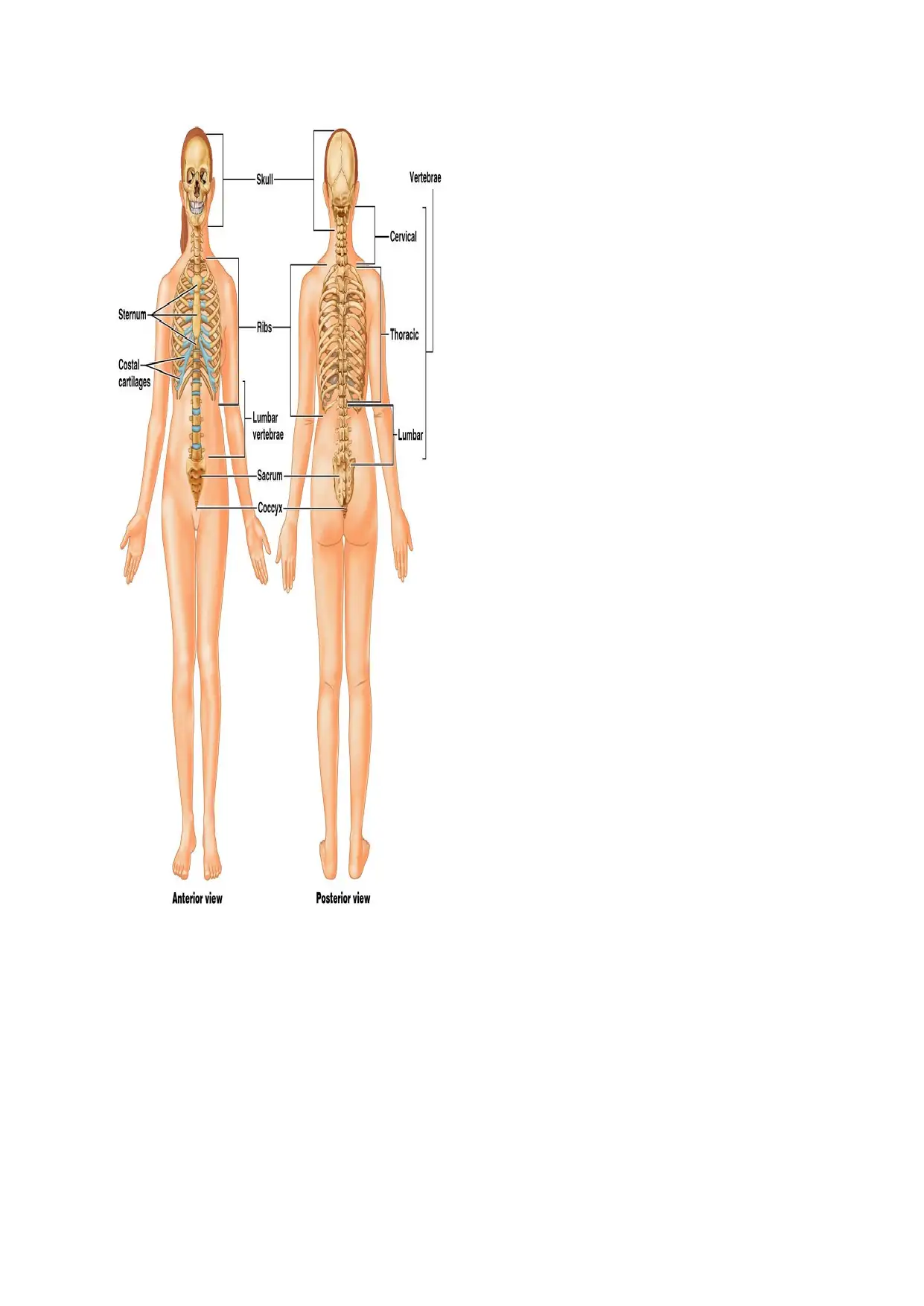
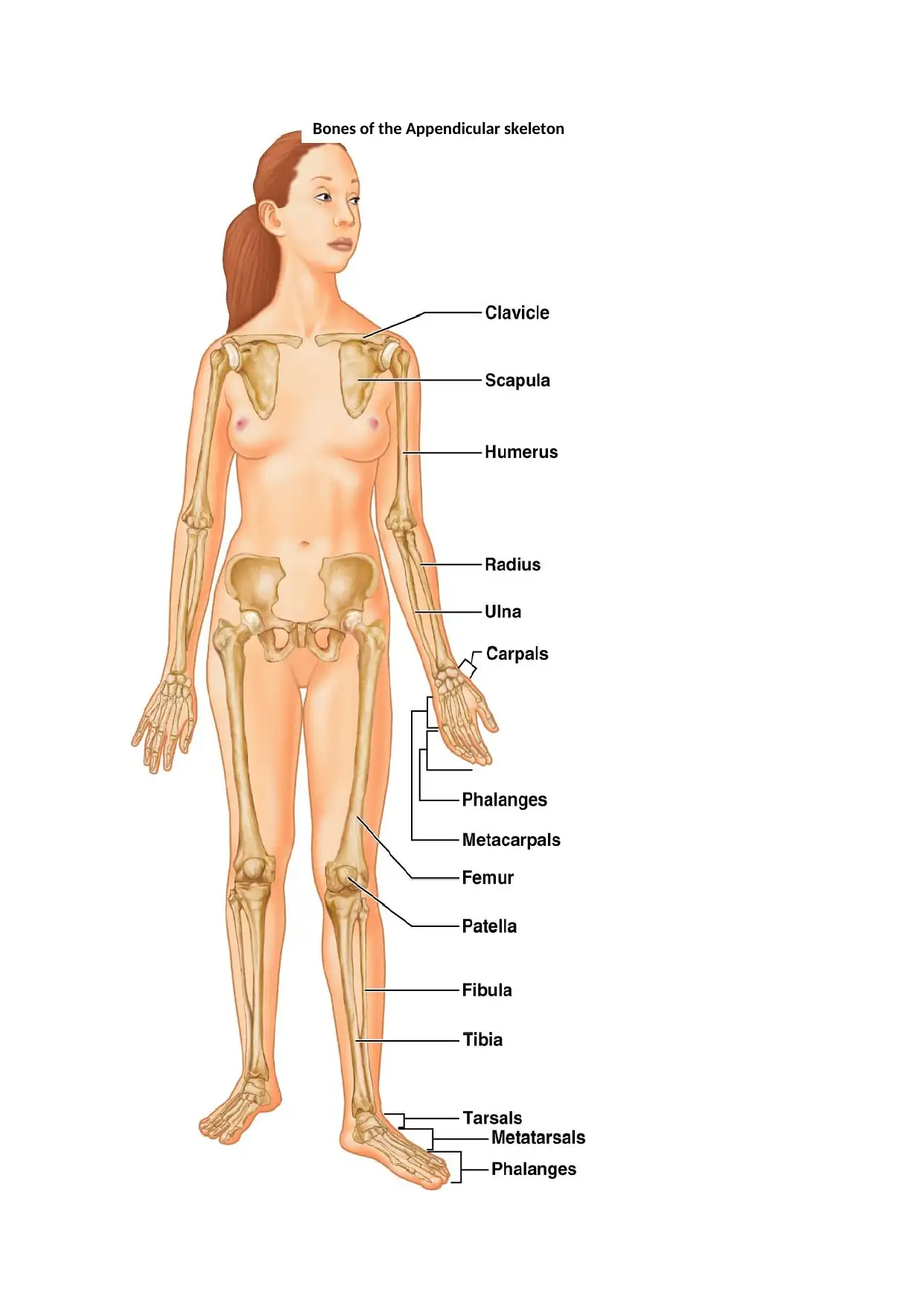
Bones of the Appendicular skeleton
Secure Best Marks with AI Grader
Need help grading? Try our AI Grader for instant feedback on your assignments.
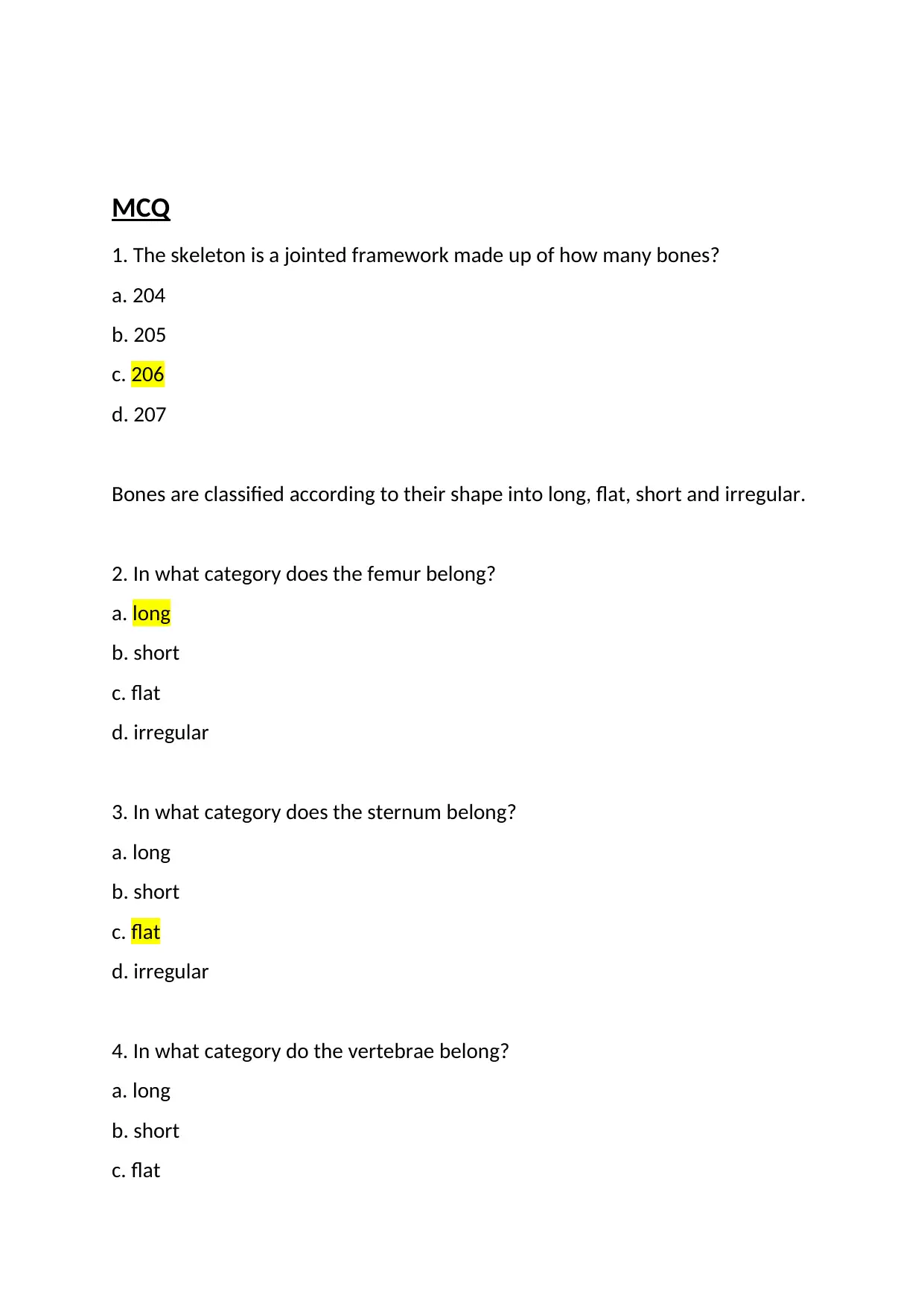
MCQ
1. The skeleton is a jointed framework made up of how many bones?
a. 204
b. 205
c. 206
d. 207
Bones are classified according to their shape into long, flat, short and irregular.
2. In what category does the femur belong?
a. long
b. short
c. flat
d. irregular
3. In what category does the sternum belong?
a. long
b. short
c. flat
d. irregular
4. In what category do the vertebrae belong?
a. long
b. short
c. flat
1. The skeleton is a jointed framework made up of how many bones?
a. 204
b. 205
c. 206
d. 207
Bones are classified according to their shape into long, flat, short and irregular.
2. In what category does the femur belong?
a. long
b. short
c. flat
d. irregular
3. In what category does the sternum belong?
a. long
b. short
c. flat
d. irregular
4. In what category do the vertebrae belong?
a. long
b. short
c. flat

d. irregular
5. The following are functions of bone
a. protection
b. growth
c. support
d. all of the above
6. The following effect bone development and growth
a. nutrition
b. sunlight
c. physical stress and exercise
d. all of the above
7. The following is NOT a type of muscle
a. cardiac
b. endothelial
c. skeletal
d. smooth
8. The following attach muscles to bones
a. tendons
b. cartilage
c. epithelial cells
d. ligaments
9. The following attach bone to bone
5. The following are functions of bone
a. protection
b. growth
c. support
d. all of the above
6. The following effect bone development and growth
a. nutrition
b. sunlight
c. physical stress and exercise
d. all of the above
7. The following is NOT a type of muscle
a. cardiac
b. endothelial
c. skeletal
d. smooth
8. The following attach muscles to bones
a. tendons
b. cartilage
c. epithelial cells
d. ligaments
9. The following attach bone to bone
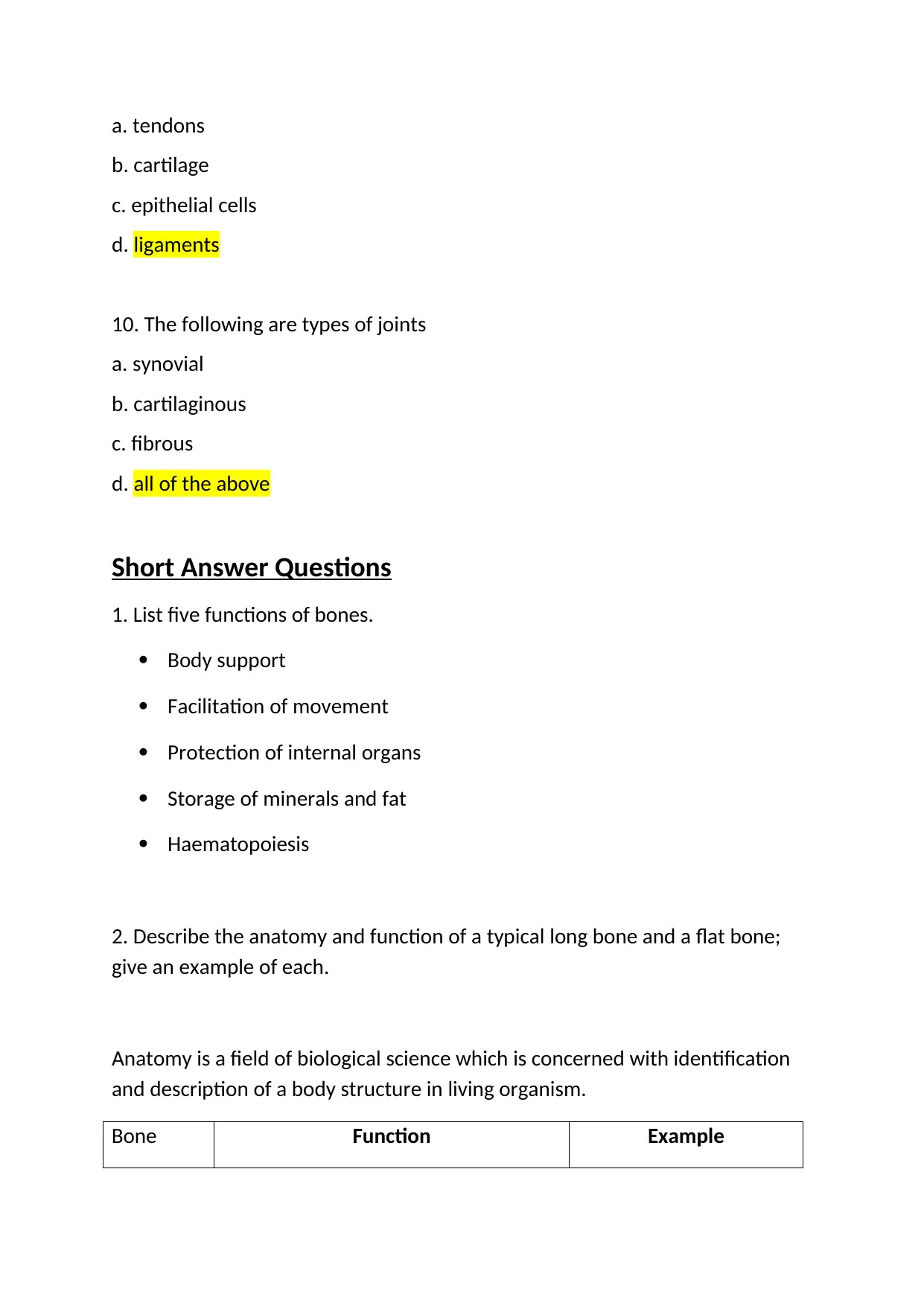
a. tendons
b. cartilage
c. epithelial cells
d. ligaments
10. The following are types of joints
a. synovial
b. cartilaginous
c. fibrous
d. all of the above
Short Answer Questions
1. List five functions of bones.
Body support
Facilitation of movement
Protection of internal organs
Storage of minerals and fat
Haematopoiesis
2. Describe the anatomy and function of a typical long bone and a flat bone;
give an example of each.
Anatomy is a field of biological science which is concerned with identification
and description of a body structure in living organism.
Bone Function Example
b. cartilage
c. epithelial cells
d. ligaments
10. The following are types of joints
a. synovial
b. cartilaginous
c. fibrous
d. all of the above
Short Answer Questions
1. List five functions of bones.
Body support
Facilitation of movement
Protection of internal organs
Storage of minerals and fat
Haematopoiesis
2. Describe the anatomy and function of a typical long bone and a flat bone;
give an example of each.
Anatomy is a field of biological science which is concerned with identification
and description of a body structure in living organism.
Bone Function Example
Paraphrase This Document
Need a fresh take? Get an instant paraphrase of this document with our AI Paraphraser
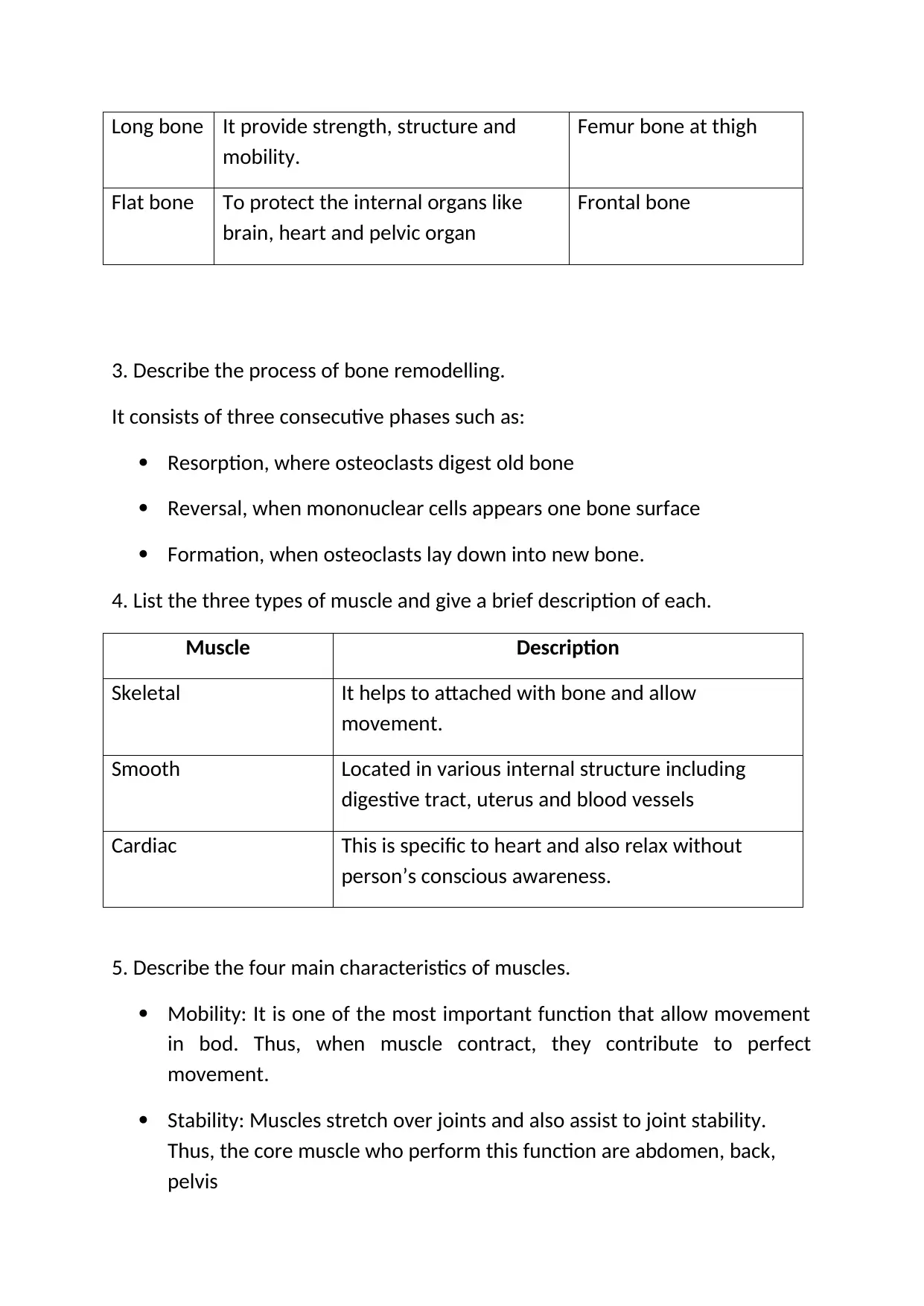
Long bone It provide strength, structure and
mobility.
Femur bone at thigh
Flat bone To protect the internal organs like
brain, heart and pelvic organ
Frontal bone
3. Describe the process of bone remodelling.
It consists of three consecutive phases such as:
Resorption, where osteoclasts digest old bone
Reversal, when mononuclear cells appears one bone surface
Formation, when osteoclasts lay down into new bone.
4. List the three types of muscle and give a brief description of each.
Muscle Description
Skeletal It helps to attached with bone and allow
movement.
Smooth Located in various internal structure including
digestive tract, uterus and blood vessels
Cardiac This is specific to heart and also relax without
person’s conscious awareness.
5. Describe the four main characteristics of muscles.
Mobility: It is one of the most important function that allow movement
in bod. Thus, when muscle contract, they contribute to perfect
movement.
Stability: Muscles stretch over joints and also assist to joint stability.
Thus, the core muscle who perform this function are abdomen, back,
pelvis
mobility.
Femur bone at thigh
Flat bone To protect the internal organs like
brain, heart and pelvic organ
Frontal bone
3. Describe the process of bone remodelling.
It consists of three consecutive phases such as:
Resorption, where osteoclasts digest old bone
Reversal, when mononuclear cells appears one bone surface
Formation, when osteoclasts lay down into new bone.
4. List the three types of muscle and give a brief description of each.
Muscle Description
Skeletal It helps to attached with bone and allow
movement.
Smooth Located in various internal structure including
digestive tract, uterus and blood vessels
Cardiac This is specific to heart and also relax without
person’s conscious awareness.
5. Describe the four main characteristics of muscles.
Mobility: It is one of the most important function that allow movement
in bod. Thus, when muscle contract, they contribute to perfect
movement.
Stability: Muscles stretch over joints and also assist to joint stability.
Thus, the core muscle who perform this function are abdomen, back,
pelvis
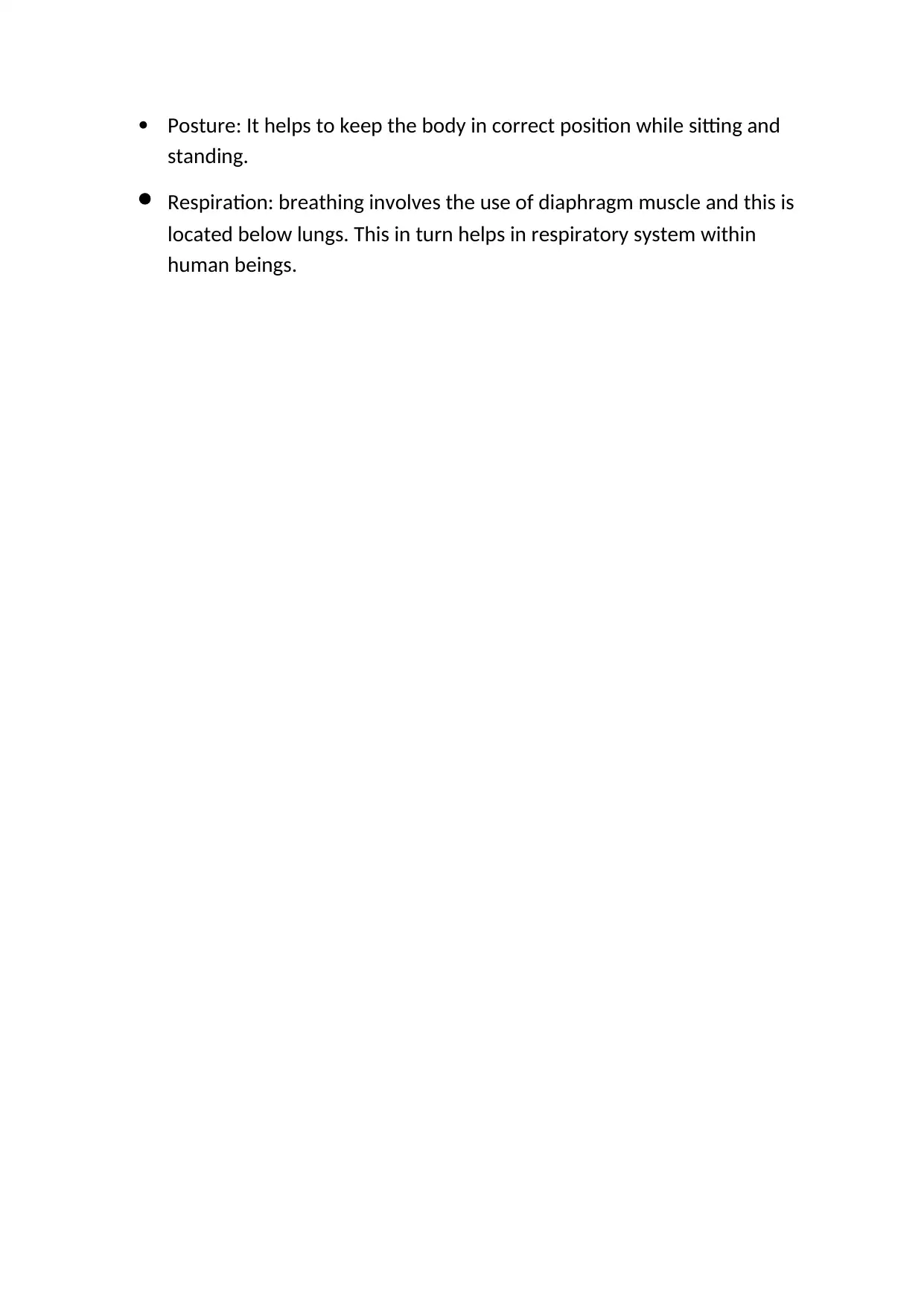
Posture: It helps to keep the body in correct position while sitting and
standing.
Respiration: breathing involves the use of diaphragm muscle and this is
located below lungs. This in turn helps in respiratory system within
human beings.
standing.
Respiration: breathing involves the use of diaphragm muscle and this is
located below lungs. This in turn helps in respiratory system within
human beings.
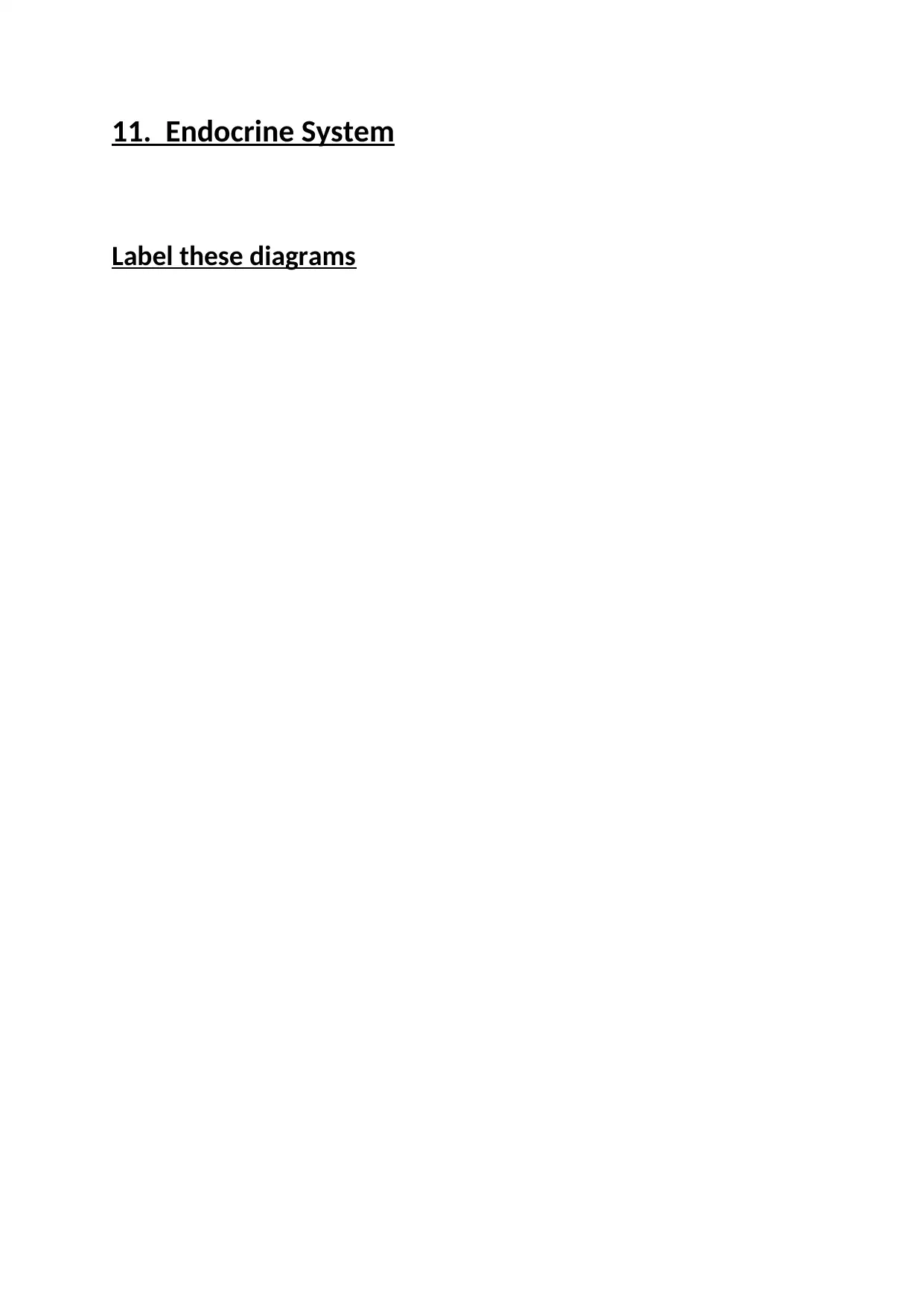
11. Endocrine System
Label these diagrams
Label these diagrams
Secure Best Marks with AI Grader
Need help grading? Try our AI Grader for instant feedback on your assignments.
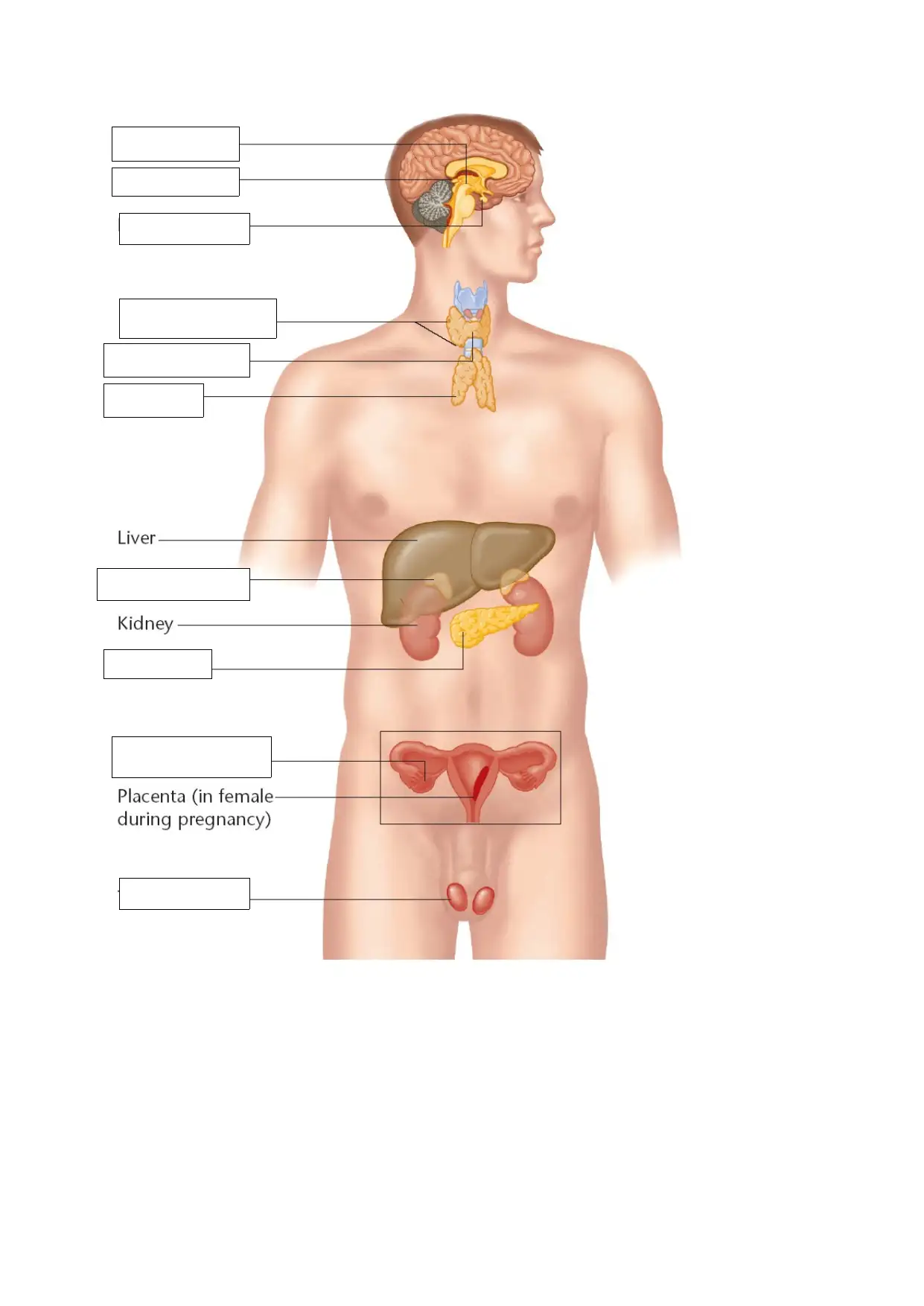

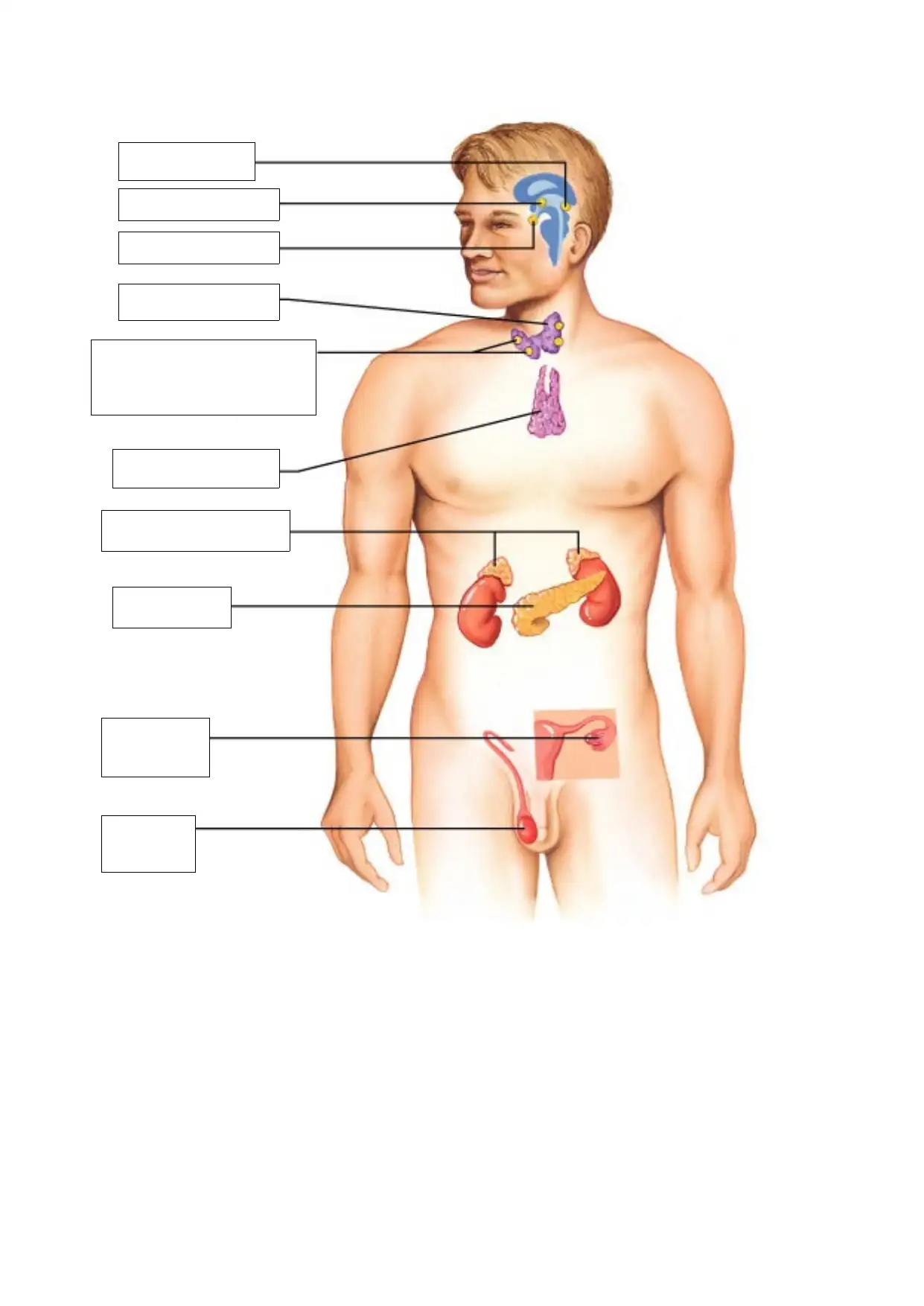
Paraphrase This Document
Need a fresh take? Get an instant paraphrase of this document with our AI Paraphraser

MCQ

1. Hyposecretion of the pancreas causes the following condition
a. addison's disease
b. acromegaly
c. graves' disease
d. diabetes mellitus
e. pituitary dwarfism
2. The gland that controls the fight-or-flight reaction
a. thyroid
b. adrenal medulla
c. hypophysis
d. parathyroid
e. pancreas
3. Which of the following is not a category of endocrine gland stimulation?
a. enzyme
b. hormonal
c. neural
d. humoral
4. Substances that are secreted by cells directly into the blood stream and have
an effect on other cells in the body are
a. enzymes
b. hormones
c. proteins
d. antibodies
5. Oxytocin
a. release is an example of a positive feedback mechanism
b. exerts its most positive effects during menstruation
c. controls milk production
d. release is an example of a negative feedback mechanism
6. ADH
a. increases urine production
a. addison's disease
b. acromegaly
c. graves' disease
d. diabetes mellitus
e. pituitary dwarfism
2. The gland that controls the fight-or-flight reaction
a. thyroid
b. adrenal medulla
c. hypophysis
d. parathyroid
e. pancreas
3. Which of the following is not a category of endocrine gland stimulation?
a. enzyme
b. hormonal
c. neural
d. humoral
4. Substances that are secreted by cells directly into the blood stream and have
an effect on other cells in the body are
a. enzymes
b. hormones
c. proteins
d. antibodies
5. Oxytocin
a. release is an example of a positive feedback mechanism
b. exerts its most positive effects during menstruation
c. controls milk production
d. release is an example of a negative feedback mechanism
6. ADH
a. increases urine production

b. promotes dehydration
c. works on the pancreas
d. decreases urine production
7. The major hormone released in the fight - or - flight syndrome is
a. thyroxine
b. adrenaline
c. antidiuretic hormone
d. melatonin
8. The major target organs of the human growth hormone are
a. blood vessels
c. adrenal glands
c. the liver
d. bones and skeletal muscle
9. Which of the following organs does not have a hormone producing capacity
a. the heart
b. the liver
c. the skin
d. the kidneys
10. Glucocosticorticoids enable the body to appropriately deal with stress.
They do this by
a. increasing blood glucose and enhancing blood pressure
b. decreasing the heart rate and therefore the blood pressure
c. stimulating the pancreas to secrete insulin
d. blocking the neaurotransmitters that allow the body to cope with stress.
Short Answer Questions
c. works on the pancreas
d. decreases urine production
7. The major hormone released in the fight - or - flight syndrome is
a. thyroxine
b. adrenaline
c. antidiuretic hormone
d. melatonin
8. The major target organs of the human growth hormone are
a. blood vessels
c. adrenal glands
c. the liver
d. bones and skeletal muscle
9. Which of the following organs does not have a hormone producing capacity
a. the heart
b. the liver
c. the skin
d. the kidneys
10. Glucocosticorticoids enable the body to appropriately deal with stress.
They do this by
a. increasing blood glucose and enhancing blood pressure
b. decreasing the heart rate and therefore the blood pressure
c. stimulating the pancreas to secrete insulin
d. blocking the neaurotransmitters that allow the body to cope with stress.
Short Answer Questions
Secure Best Marks with AI Grader
Need help grading? Try our AI Grader for instant feedback on your assignments.
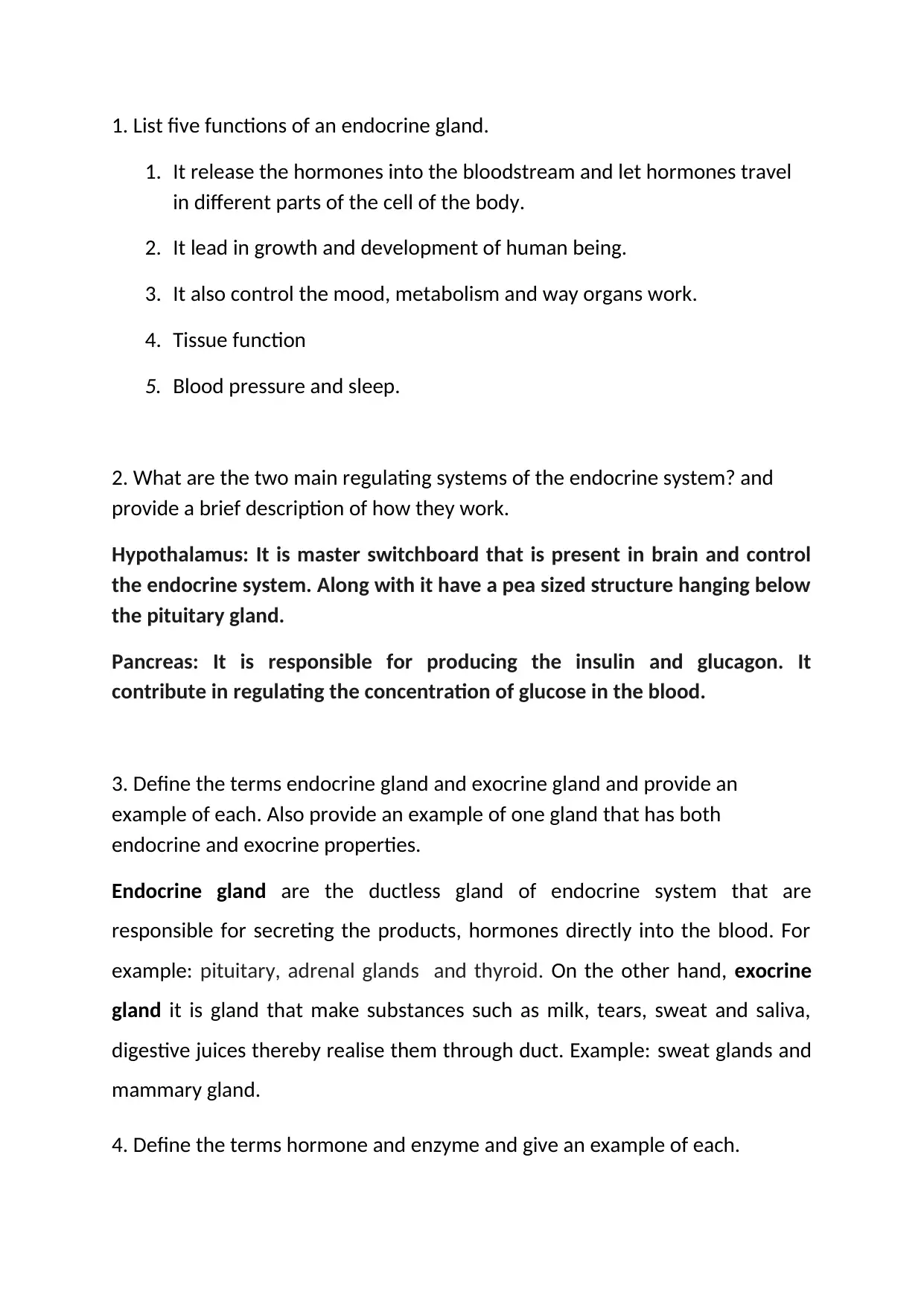
1. List five functions of an endocrine gland.
1. It release the hormones into the bloodstream and let hormones travel
in different parts of the cell of the body.
2. It lead in growth and development of human being.
3. It also control the mood, metabolism and way organs work.
4. Tissue function
5. Blood pressure and sleep.
2. What are the two main regulating systems of the endocrine system? and
provide a brief description of how they work.
Hypothalamus: It is master switchboard that is present in brain and control
the endocrine system. Along with it have a pea sized structure hanging below
the pituitary gland.
Pancreas: It is responsible for producing the insulin and glucagon. It
contribute in regulating the concentration of glucose in the blood.
3. Define the terms endocrine gland and exocrine gland and provide an
example of each. Also provide an example of one gland that has both
endocrine and exocrine properties.
Endocrine gland are the ductless gland of endocrine system that are
responsible for secreting the products, hormones directly into the blood. For
example: pituitary, adrenal glands and thyroid. On the other hand, exocrine
gland it is gland that make substances such as milk, tears, sweat and saliva,
digestive juices thereby realise them through duct. Example: sweat glands and
mammary gland.
4. Define the terms hormone and enzyme and give an example of each.
1. It release the hormones into the bloodstream and let hormones travel
in different parts of the cell of the body.
2. It lead in growth and development of human being.
3. It also control the mood, metabolism and way organs work.
4. Tissue function
5. Blood pressure and sleep.
2. What are the two main regulating systems of the endocrine system? and
provide a brief description of how they work.
Hypothalamus: It is master switchboard that is present in brain and control
the endocrine system. Along with it have a pea sized structure hanging below
the pituitary gland.
Pancreas: It is responsible for producing the insulin and glucagon. It
contribute in regulating the concentration of glucose in the blood.
3. Define the terms endocrine gland and exocrine gland and provide an
example of each. Also provide an example of one gland that has both
endocrine and exocrine properties.
Endocrine gland are the ductless gland of endocrine system that are
responsible for secreting the products, hormones directly into the blood. For
example: pituitary, adrenal glands and thyroid. On the other hand, exocrine
gland it is gland that make substances such as milk, tears, sweat and saliva,
digestive juices thereby realise them through duct. Example: sweat glands and
mammary gland.
4. Define the terms hormone and enzyme and give an example of each.
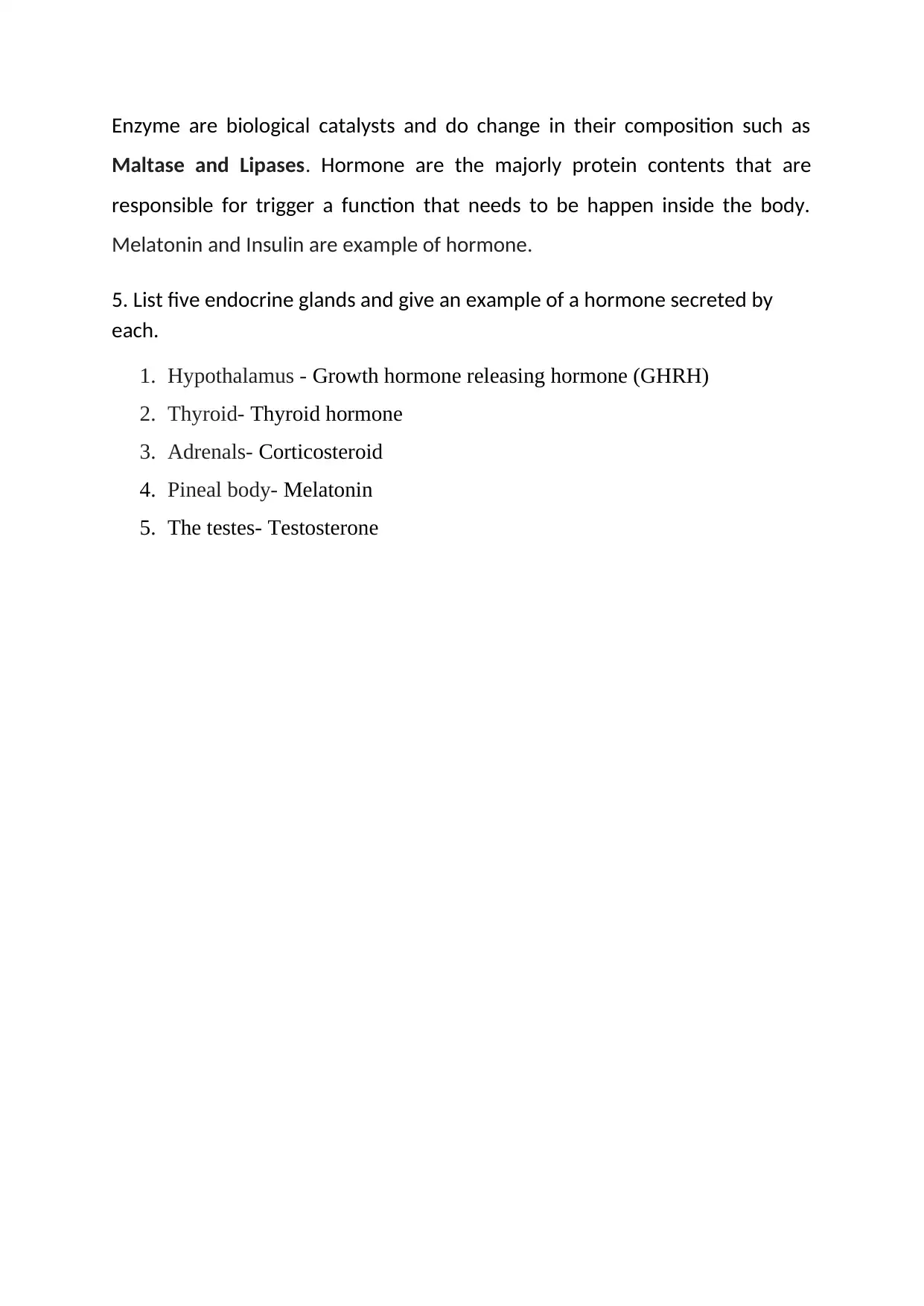
Enzyme are biological catalysts and do change in their composition such as
Maltase and Lipases. Hormone are the majorly protein contents that are
responsible for trigger a function that needs to be happen inside the body.
Melatonin and Insulin are example of hormone.
5. List five endocrine glands and give an example of a hormone secreted by
each.
1. Hypothalamus - Growth hormone releasing hormone (GHRH)
2. Thyroid- Thyroid hormone
3. Adrenals- Corticosteroid
4. Pineal body- Melatonin
5. The testes- Testosterone
Maltase and Lipases. Hormone are the majorly protein contents that are
responsible for trigger a function that needs to be happen inside the body.
Melatonin and Insulin are example of hormone.
5. List five endocrine glands and give an example of a hormone secreted by
each.
1. Hypothalamus - Growth hormone releasing hormone (GHRH)
2. Thyroid- Thyroid hormone
3. Adrenals- Corticosteroid
4. Pineal body- Melatonin
5. The testes- Testosterone

12. Nervous System
Label these diagrams
Node of
ranvier
Axon
terminals
Schwann
cell
Impulse
Direction
Axon
hillock
Nucleolus
Nucleus
Cell body
Neurilemma
Terminal
branches
Dentrites
Label these diagrams
Node of
ranvier
Axon
terminals
Schwann
cell
Impulse
Direction
Axon
hillock
Nucleolus
Nucleus
Cell body
Neurilemma
Terminal
branches
Dentrites
Paraphrase This Document
Need a fresh take? Get an instant paraphrase of this document with our AI Paraphraser
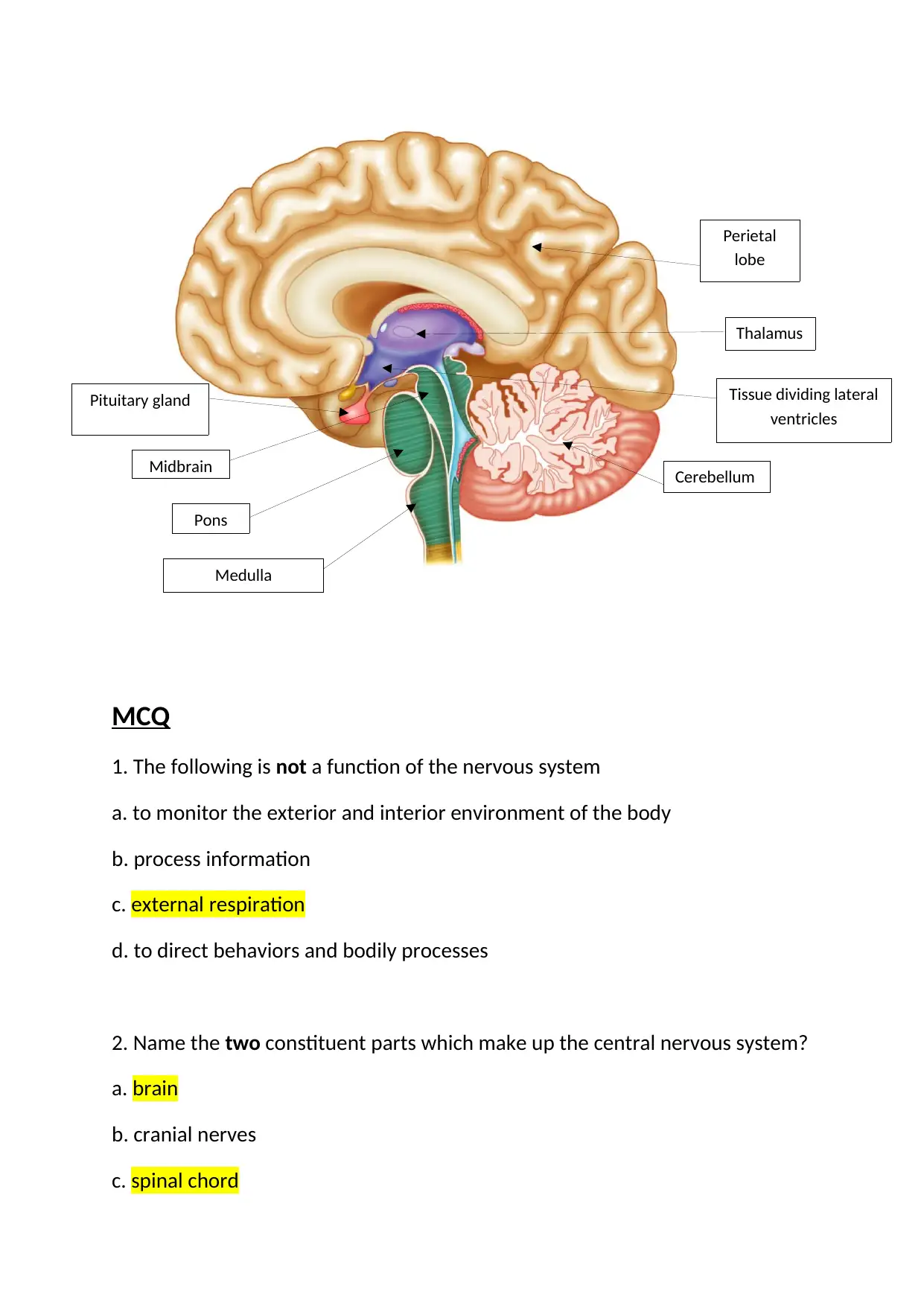
MCQ
1. The following is not a function of the nervous system
a. to monitor the exterior and interior environment of the body
b. process information
c. external respiration
d. to direct behaviors and bodily processes
2. Name the two constituent parts which make up the central nervous system?
a. brain
b. cranial nerves
c. spinal chord
Pituitary gland
Midbrain
Pons
Medulla
Perietal
lobe
Cerebellum
Thalamus
Tissue dividing lateral
ventricles
1. The following is not a function of the nervous system
a. to monitor the exterior and interior environment of the body
b. process information
c. external respiration
d. to direct behaviors and bodily processes
2. Name the two constituent parts which make up the central nervous system?
a. brain
b. cranial nerves
c. spinal chord
Pituitary gland
Midbrain
Pons
Medulla
Perietal
lobe
Cerebellum
Thalamus
Tissue dividing lateral
ventricles

d. spinal nerves
3. The peripheral nervous system is made up of which two constituent parts?
a. somatic Nervous System
b. sympathetic Nervous System
c. autonomic Nervous System
d. parasympathetic Nervous System
4. The sympathetic Nervous System is responsible for the following
a. rest & digest mechanism
b. run and eat mechanism
c. fight Vs flight mechanism
d. stay and sleep mechanism
5. A neurone is a
a. nueroglia
b. nerve glue
c. nerve cell
d. nuerotransmitter
6. The following disease is believed to occur as a result of the demyelination of
axons.
a. multiple sclerosis
b. alzheimers
3. The peripheral nervous system is made up of which two constituent parts?
a. somatic Nervous System
b. sympathetic Nervous System
c. autonomic Nervous System
d. parasympathetic Nervous System
4. The sympathetic Nervous System is responsible for the following
a. rest & digest mechanism
b. run and eat mechanism
c. fight Vs flight mechanism
d. stay and sleep mechanism
5. A neurone is a
a. nueroglia
b. nerve glue
c. nerve cell
d. nuerotransmitter
6. The following disease is believed to occur as a result of the demyelination of
axons.
a. multiple sclerosis
b. alzheimers
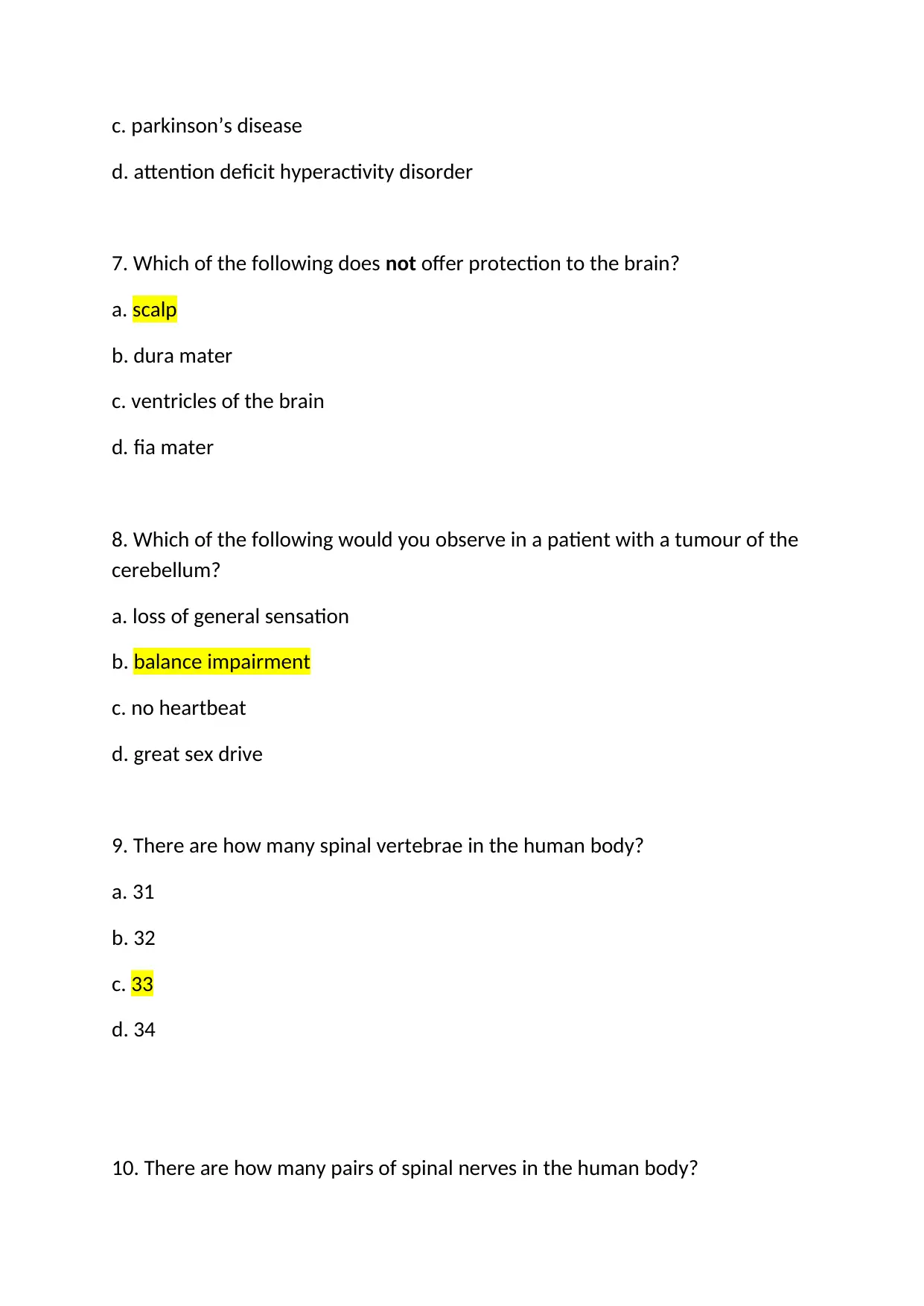
c. parkinson’s disease
d. attention deficit hyperactivity disorder
7. Which of the following does not offer protection to the brain?
a. scalp
b. dura mater
c. ventricles of the brain
d. fia mater
8. Which of the following would you observe in a patient with a tumour of the
cerebellum?
a. loss of general sensation
b. balance impairment
c. no heartbeat
d. great sex drive
9. There are how many spinal vertebrae in the human body?
a. 31
b. 32
c. 33
d. 34
10. There are how many pairs of spinal nerves in the human body?
d. attention deficit hyperactivity disorder
7. Which of the following does not offer protection to the brain?
a. scalp
b. dura mater
c. ventricles of the brain
d. fia mater
8. Which of the following would you observe in a patient with a tumour of the
cerebellum?
a. loss of general sensation
b. balance impairment
c. no heartbeat
d. great sex drive
9. There are how many spinal vertebrae in the human body?
a. 31
b. 32
c. 33
d. 34
10. There are how many pairs of spinal nerves in the human body?
Secure Best Marks with AI Grader
Need help grading? Try our AI Grader for instant feedback on your assignments.
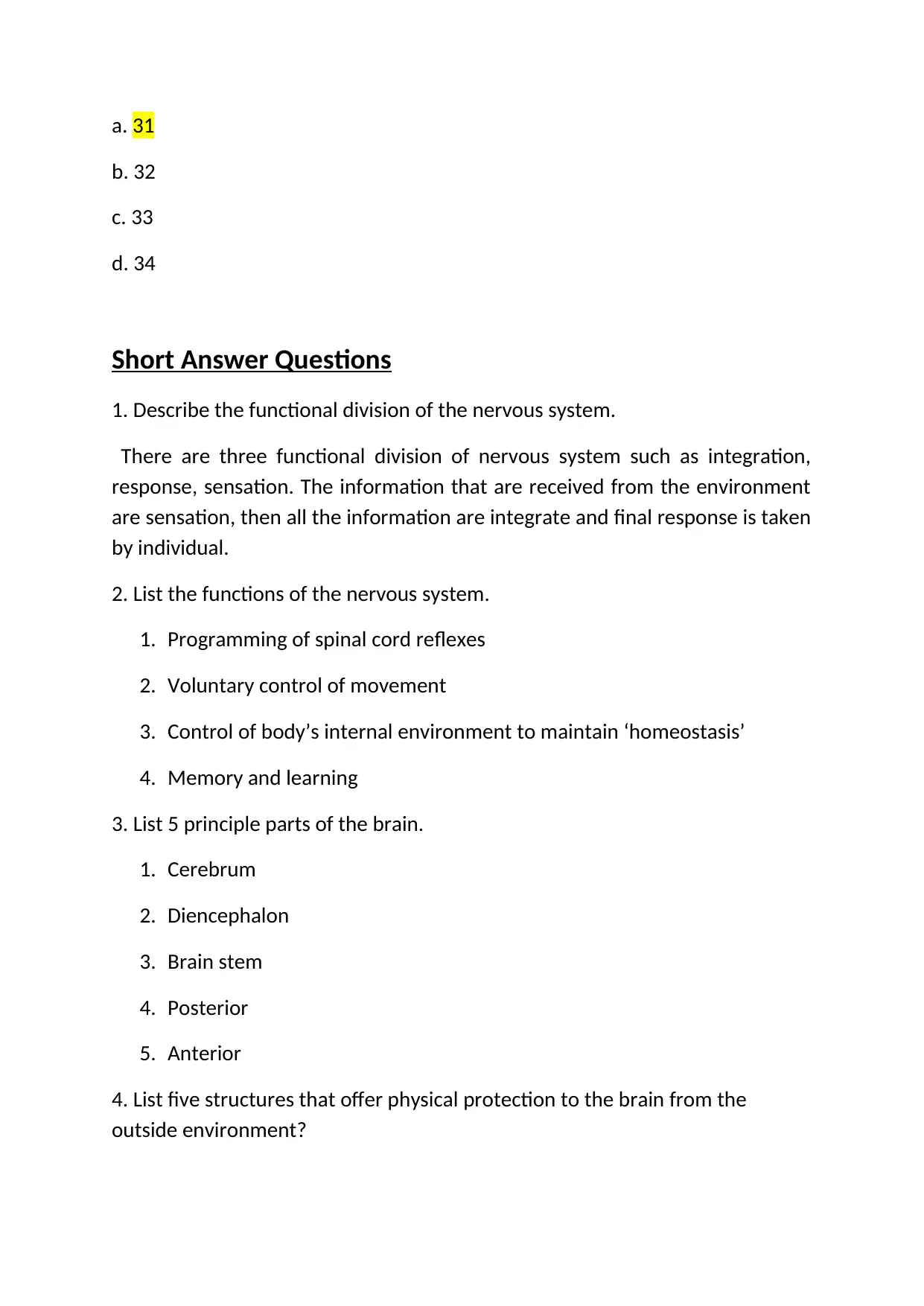
a. 31
b. 32
c. 33
d. 34
Short Answer Questions
1. Describe the functional division of the nervous system.
There are three functional division of nervous system such as integration,
response, sensation. The information that are received from the environment
are sensation, then all the information are integrate and final response is taken
by individual.
2. List the functions of the nervous system.
1. Programming of spinal cord reflexes
2. Voluntary control of movement
3. Control of body’s internal environment to maintain ‘homeostasis’
4. Memory and learning
3. List 5 principle parts of the brain.
1. Cerebrum
2. Diencephalon
3. Brain stem
4. Posterior
5. Anterior
4. List five structures that offer physical protection to the brain from the
outside environment?
b. 32
c. 33
d. 34
Short Answer Questions
1. Describe the functional division of the nervous system.
There are three functional division of nervous system such as integration,
response, sensation. The information that are received from the environment
are sensation, then all the information are integrate and final response is taken
by individual.
2. List the functions of the nervous system.
1. Programming of spinal cord reflexes
2. Voluntary control of movement
3. Control of body’s internal environment to maintain ‘homeostasis’
4. Memory and learning
3. List 5 principle parts of the brain.
1. Cerebrum
2. Diencephalon
3. Brain stem
4. Posterior
5. Anterior
4. List five structures that offer physical protection to the brain from the
outside environment?

Five structures that offer physical protection to the brain from the
outside environment are 3 protective membranes (Meninges), the skull
(cranium) and cerebrospinal fluid, the pia mate and the arachnoid mater.
5. Define the functions of the parasympathetic and sympathetic nervous
system.
There are range of functions of the parasympathetic and sympathetic nervous
system such as respiration and cardiac contractility, rest-and-digest or feed-
and-breed responses. Moreover, it perform function related to body's rest and
digestion response that helps in dealing with stressful situation.
13. Immune System
Label the key elements of
outside environment are 3 protective membranes (Meninges), the skull
(cranium) and cerebrospinal fluid, the pia mate and the arachnoid mater.
5. Define the functions of the parasympathetic and sympathetic nervous
system.
There are range of functions of the parasympathetic and sympathetic nervous
system such as respiration and cardiac contractility, rest-and-digest or feed-
and-breed responses. Moreover, it perform function related to body's rest and
digestion response that helps in dealing with stressful situation.
13. Immune System
Label the key elements of

Paraphrase This Document
Need a fresh take? Get an instant paraphrase of this document with our AI Paraphraser

MCQ
1-4. Link the following terms to their relevant definitions.
Antigen Disease causing antigen
Antibodies Harmful chemical produced by microorganisms
Toxin Used by the immune system to identify and destroy foreign
objects
Pathogen Foreign molecules that generate antibody production in the
body
5. The physical and chemical barriers of the body present which type of
immunity?
a. non – specific
b. innate
c. specific
d. adaptive
6. The following is not an organ/structure involved in innate immunity
a. cilia of the nasal cavity
b. hair on the scalp
c. antibodies
d. skin
1-4. Link the following terms to their relevant definitions.
Antigen Disease causing antigen
Antibodies Harmful chemical produced by microorganisms
Toxin Used by the immune system to identify and destroy foreign
objects
Pathogen Foreign molecules that generate antibody production in the
body
5. The physical and chemical barriers of the body present which type of
immunity?
a. non – specific
b. innate
c. specific
d. adaptive
6. The following is not an organ/structure involved in innate immunity
a. cilia of the nasal cavity
b. hair on the scalp
c. antibodies
d. skin
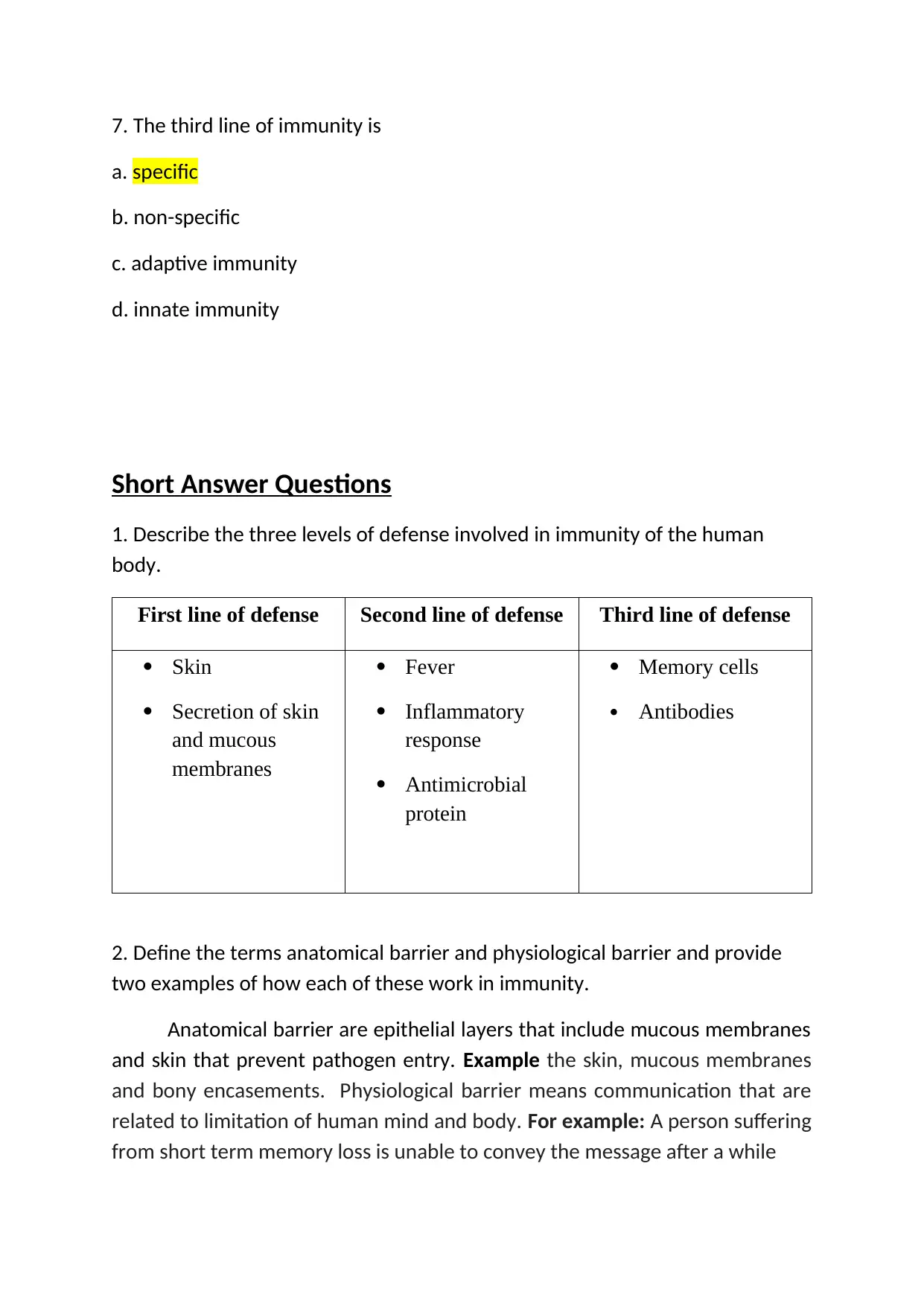
7. The third line of immunity is
a. specific
b. non-specific
c. adaptive immunity
d. innate immunity
Short Answer Questions
1. Describe the three levels of defense involved in immunity of the human
body.
First line of defense Second line of defense Third line of defense
Skin
Secretion of skin
and mucous
membranes
Fever
Inflammatory
response
Antimicrobial
protein
Memory cells
Antibodies
2. Define the terms anatomical barrier and physiological barrier and provide
two examples of how each of these work in immunity.
Anatomical barrier are epithelial layers that include mucous membranes
and skin that prevent pathogen entry. Example the skin, mucous membranes
and bony encasements. Physiological barrier means communication that are
related to limitation of human mind and body. For example: A person suffering
from short term memory loss is unable to convey the message after a while
a. specific
b. non-specific
c. adaptive immunity
d. innate immunity
Short Answer Questions
1. Describe the three levels of defense involved in immunity of the human
body.
First line of defense Second line of defense Third line of defense
Skin
Secretion of skin
and mucous
membranes
Fever
Inflammatory
response
Antimicrobial
protein
Memory cells
Antibodies
2. Define the terms anatomical barrier and physiological barrier and provide
two examples of how each of these work in immunity.
Anatomical barrier are epithelial layers that include mucous membranes
and skin that prevent pathogen entry. Example the skin, mucous membranes
and bony encasements. Physiological barrier means communication that are
related to limitation of human mind and body. For example: A person suffering
from short term memory loss is unable to convey the message after a while

3. Describe the process of inflammatory response
1. Removing injurious stimuli and initiating the healing process
2. Inflammation is therefore a defense mechanism that is vital to health.
4. List 4 Signs and symptoms of inflammation?
Sign
1. Redness (latin rubor)
2. Heat (calor)
3. Swelling (tumor)
4. Pain (dolor).
5. Provide three ways the body can gain immunity through an adaptive
process and give a brief explanation of how they work.
Maintain a healthy diet.
Exercise regularly.
Get plenty of sleep.
1. Removing injurious stimuli and initiating the healing process
2. Inflammation is therefore a defense mechanism that is vital to health.
4. List 4 Signs and symptoms of inflammation?
Sign
1. Redness (latin rubor)
2. Heat (calor)
3. Swelling (tumor)
4. Pain (dolor).
5. Provide three ways the body can gain immunity through an adaptive
process and give a brief explanation of how they work.
Maintain a healthy diet.
Exercise regularly.
Get plenty of sleep.
Secure Best Marks with AI Grader
Need help grading? Try our AI Grader for instant feedback on your assignments.
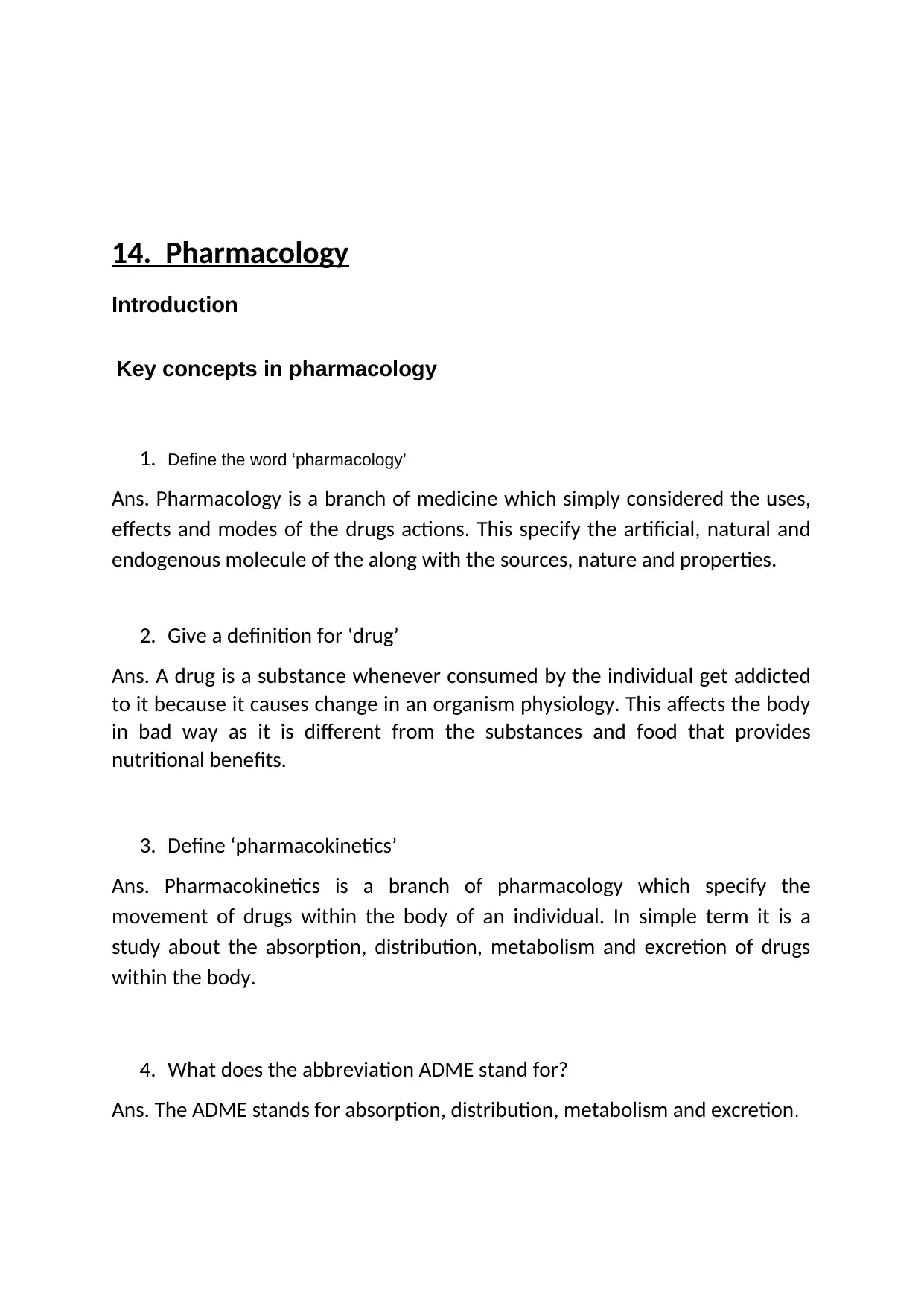
14. Pharmacology
Introduction
Key concepts in pharmacology
1. Define the word ‘pharmacology’
Ans. Pharmacology is a branch of medicine which simply considered the uses,
effects and modes of the drugs actions. This specify the artificial, natural and
endogenous molecule of the along with the sources, nature and properties.
2. Give a definition for ‘drug’
Ans. A drug is a substance whenever consumed by the individual get addicted
to it because it causes change in an organism physiology. This affects the body
in bad way as it is different from the substances and food that provides
nutritional benefits.
3. Define ‘pharmacokinetics’
Ans. Pharmacokinetics is a branch of pharmacology which specify the
movement of drugs within the body of an individual. In simple term it is a
study about the absorption, distribution, metabolism and excretion of drugs
within the body.
4. What does the abbreviation ADME stand for?
Ans. The ADME stands for absorption, distribution, metabolism and excretion.
Introduction
Key concepts in pharmacology
1. Define the word ‘pharmacology’
Ans. Pharmacology is a branch of medicine which simply considered the uses,
effects and modes of the drugs actions. This specify the artificial, natural and
endogenous molecule of the along with the sources, nature and properties.
2. Give a definition for ‘drug’
Ans. A drug is a substance whenever consumed by the individual get addicted
to it because it causes change in an organism physiology. This affects the body
in bad way as it is different from the substances and food that provides
nutritional benefits.
3. Define ‘pharmacokinetics’
Ans. Pharmacokinetics is a branch of pharmacology which specify the
movement of drugs within the body of an individual. In simple term it is a
study about the absorption, distribution, metabolism and excretion of drugs
within the body.
4. What does the abbreviation ADME stand for?
Ans. The ADME stands for absorption, distribution, metabolism and excretion.
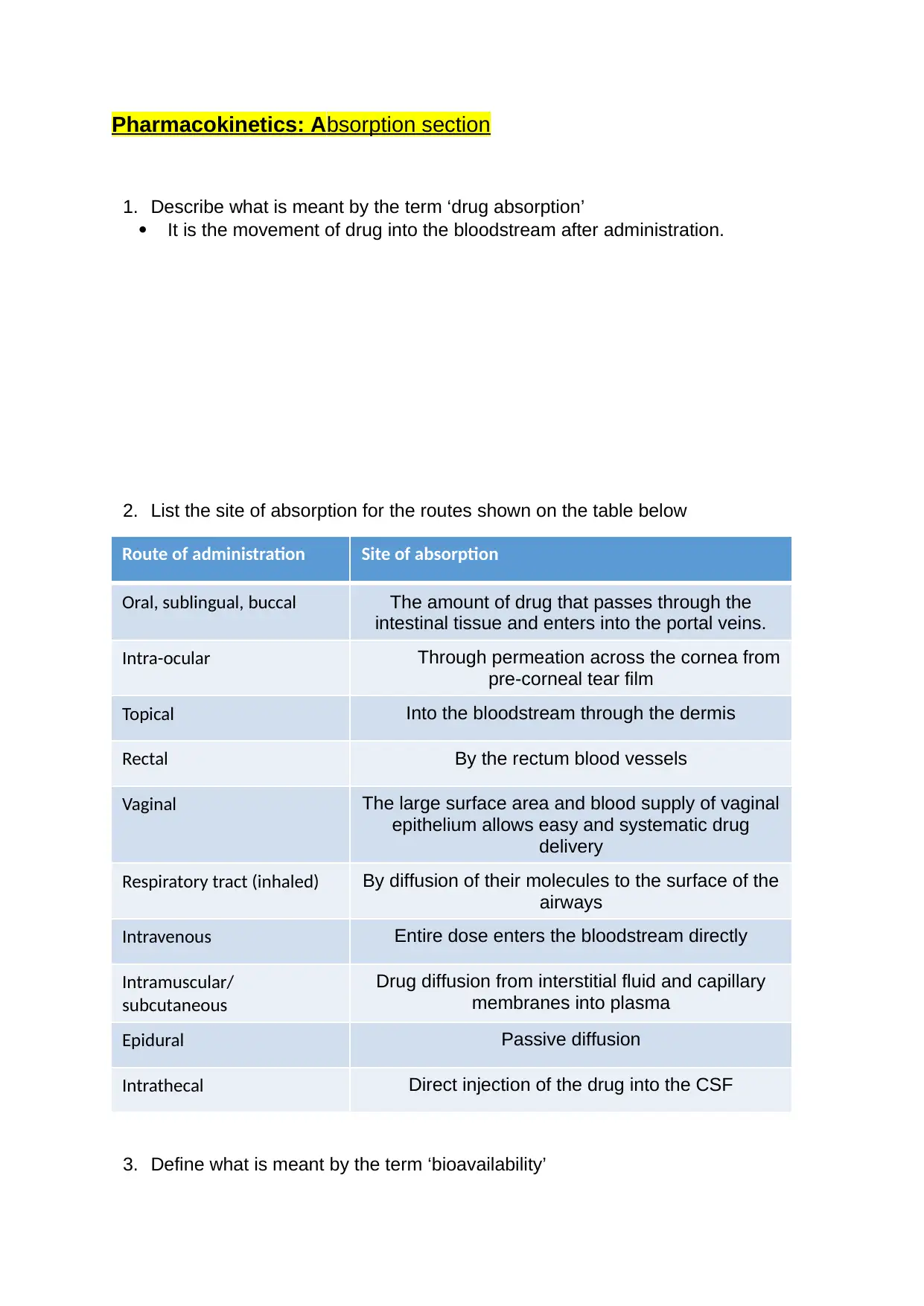
Pharmacokinetics: Absorption section
1. Describe what is meant by the term ‘drug absorption’
It is the movement of drug into the bloodstream after administration.
2. List the site of absorption for the routes shown on the table below
Route of administration Site of absorption
Oral, sublingual, buccal The amount of drug that passes through the
intestinal tissue and enters into the portal veins.
Intra-ocular Through permeation across the cornea from
pre-corneal tear film
Topical Into the bloodstream through the dermis
Rectal By the rectum blood vessels
Vaginal The large surface area and blood supply of vaginal
epithelium allows easy and systematic drug
delivery
Respiratory tract (inhaled) By diffusion of their molecules to the surface of the
airways
Intravenous Entire dose enters the bloodstream directly
Intramuscular/
subcutaneous
Drug diffusion from interstitial fluid and capillary
membranes into plasma
Epidural Passive diffusion
Intrathecal Direct injection of the drug into the CSF
3. Define what is meant by the term ‘bioavailability’
1. Describe what is meant by the term ‘drug absorption’
It is the movement of drug into the bloodstream after administration.
2. List the site of absorption for the routes shown on the table below
Route of administration Site of absorption
Oral, sublingual, buccal The amount of drug that passes through the
intestinal tissue and enters into the portal veins.
Intra-ocular Through permeation across the cornea from
pre-corneal tear film
Topical Into the bloodstream through the dermis
Rectal By the rectum blood vessels
Vaginal The large surface area and blood supply of vaginal
epithelium allows easy and systematic drug
delivery
Respiratory tract (inhaled) By diffusion of their molecules to the surface of the
airways
Intravenous Entire dose enters the bloodstream directly
Intramuscular/
subcutaneous
Drug diffusion from interstitial fluid and capillary
membranes into plasma
Epidural Passive diffusion
Intrathecal Direct injection of the drug into the CSF
3. Define what is meant by the term ‘bioavailability’
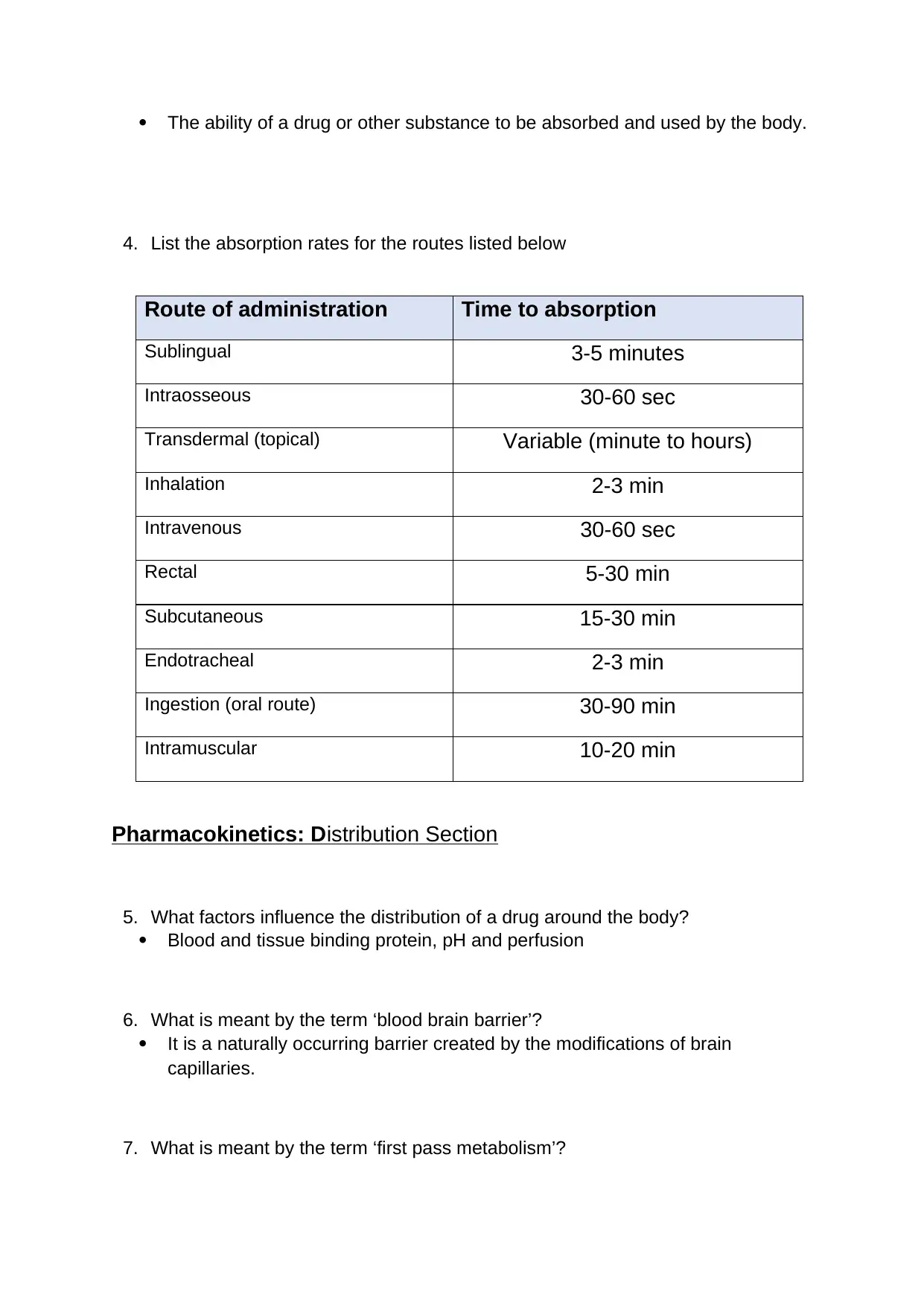
The ability of a drug or other substance to be absorbed and used by the body.
4. List the absorption rates for the routes listed below
Route of administration Time to absorption
Sublingual 3-5 minutes
Intraosseous 30-60 sec
Transdermal (topical) Variable (minute to hours)
Inhalation 2-3 min
Intravenous 30-60 sec
Rectal 5-30 min
Subcutaneous 15-30 min
Endotracheal 2-3 min
Ingestion (oral route) 30-90 min
Intramuscular 10-20 min
Pharmacokinetics: Distribution Section
5. What factors influence the distribution of a drug around the body?
Blood and tissue binding protein, pH and perfusion
6. What is meant by the term ‘blood brain barrier’?
It is a naturally occurring barrier created by the modifications of brain
capillaries.
7. What is meant by the term ‘first pass metabolism’?
4. List the absorption rates for the routes listed below
Route of administration Time to absorption
Sublingual 3-5 minutes
Intraosseous 30-60 sec
Transdermal (topical) Variable (minute to hours)
Inhalation 2-3 min
Intravenous 30-60 sec
Rectal 5-30 min
Subcutaneous 15-30 min
Endotracheal 2-3 min
Ingestion (oral route) 30-90 min
Intramuscular 10-20 min
Pharmacokinetics: Distribution Section
5. What factors influence the distribution of a drug around the body?
Blood and tissue binding protein, pH and perfusion
6. What is meant by the term ‘blood brain barrier’?
It is a naturally occurring barrier created by the modifications of brain
capillaries.
7. What is meant by the term ‘first pass metabolism’?
Paraphrase This Document
Need a fresh take? Get an instant paraphrase of this document with our AI Paraphraser
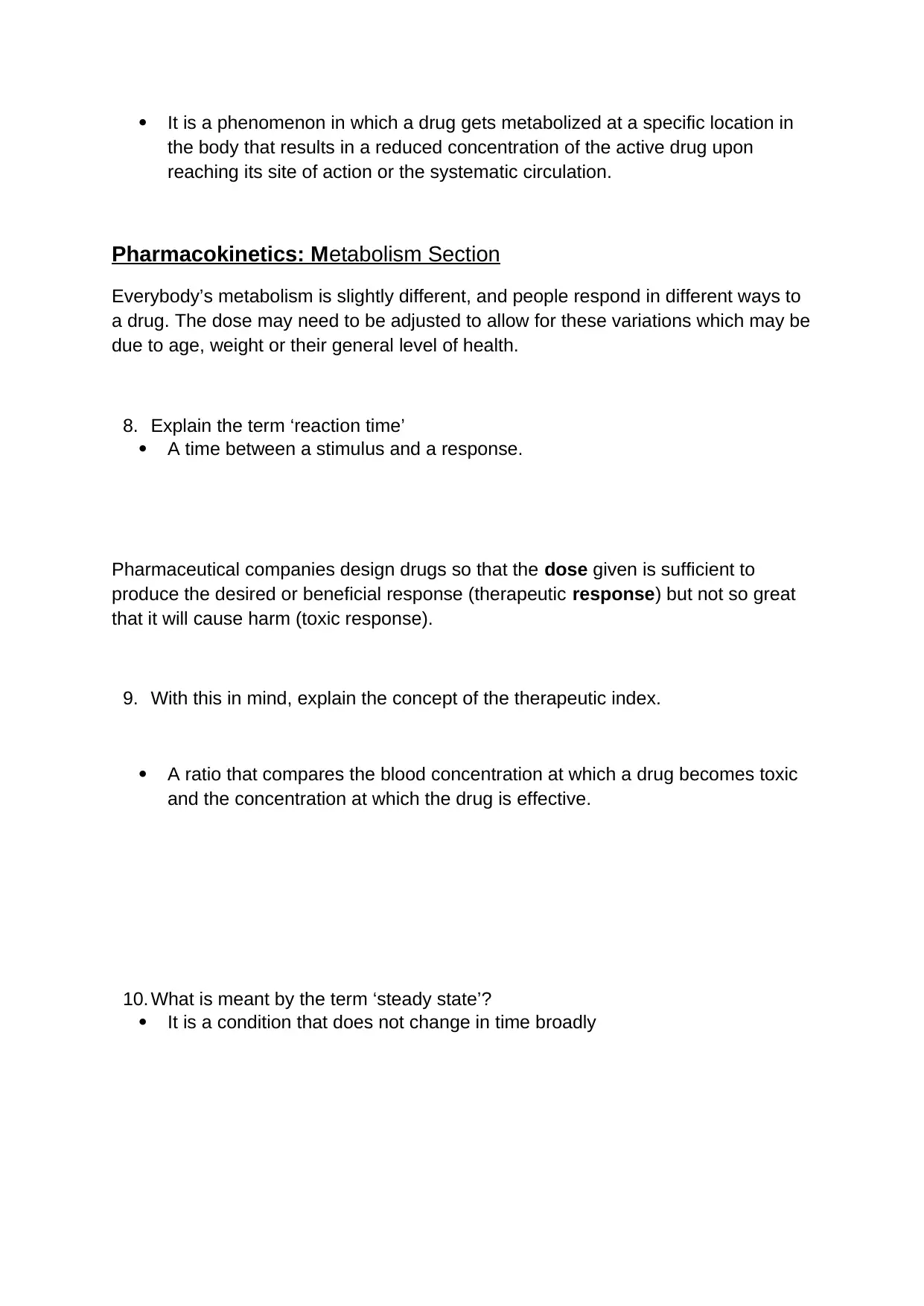
It is a phenomenon in which a drug gets metabolized at a specific location in
the body that results in a reduced concentration of the active drug upon
reaching its site of action or the systematic circulation.
Pharmacokinetics: Metabolism Section
Everybody’s metabolism is slightly different, and people respond in different ways to
a drug. The dose may need to be adjusted to allow for these variations which may be
due to age, weight or their general level of health.
8. Explain the term ‘reaction time’
A time between a stimulus and a response.
Pharmaceutical companies design drugs so that the dose given is sufficient to
produce the desired or beneficial response (therapeutic response) but not so great
that it will cause harm (toxic response).
9. With this in mind, explain the concept of the therapeutic index.
A ratio that compares the blood concentration at which a drug becomes toxic
and the concentration at which the drug is effective.
10. What is meant by the term ‘steady state’?
It is a condition that does not change in time broadly
the body that results in a reduced concentration of the active drug upon
reaching its site of action or the systematic circulation.
Pharmacokinetics: Metabolism Section
Everybody’s metabolism is slightly different, and people respond in different ways to
a drug. The dose may need to be adjusted to allow for these variations which may be
due to age, weight or their general level of health.
8. Explain the term ‘reaction time’
A time between a stimulus and a response.
Pharmaceutical companies design drugs so that the dose given is sufficient to
produce the desired or beneficial response (therapeutic response) but not so great
that it will cause harm (toxic response).
9. With this in mind, explain the concept of the therapeutic index.
A ratio that compares the blood concentration at which a drug becomes toxic
and the concentration at which the drug is effective.
10. What is meant by the term ‘steady state’?
It is a condition that does not change in time broadly
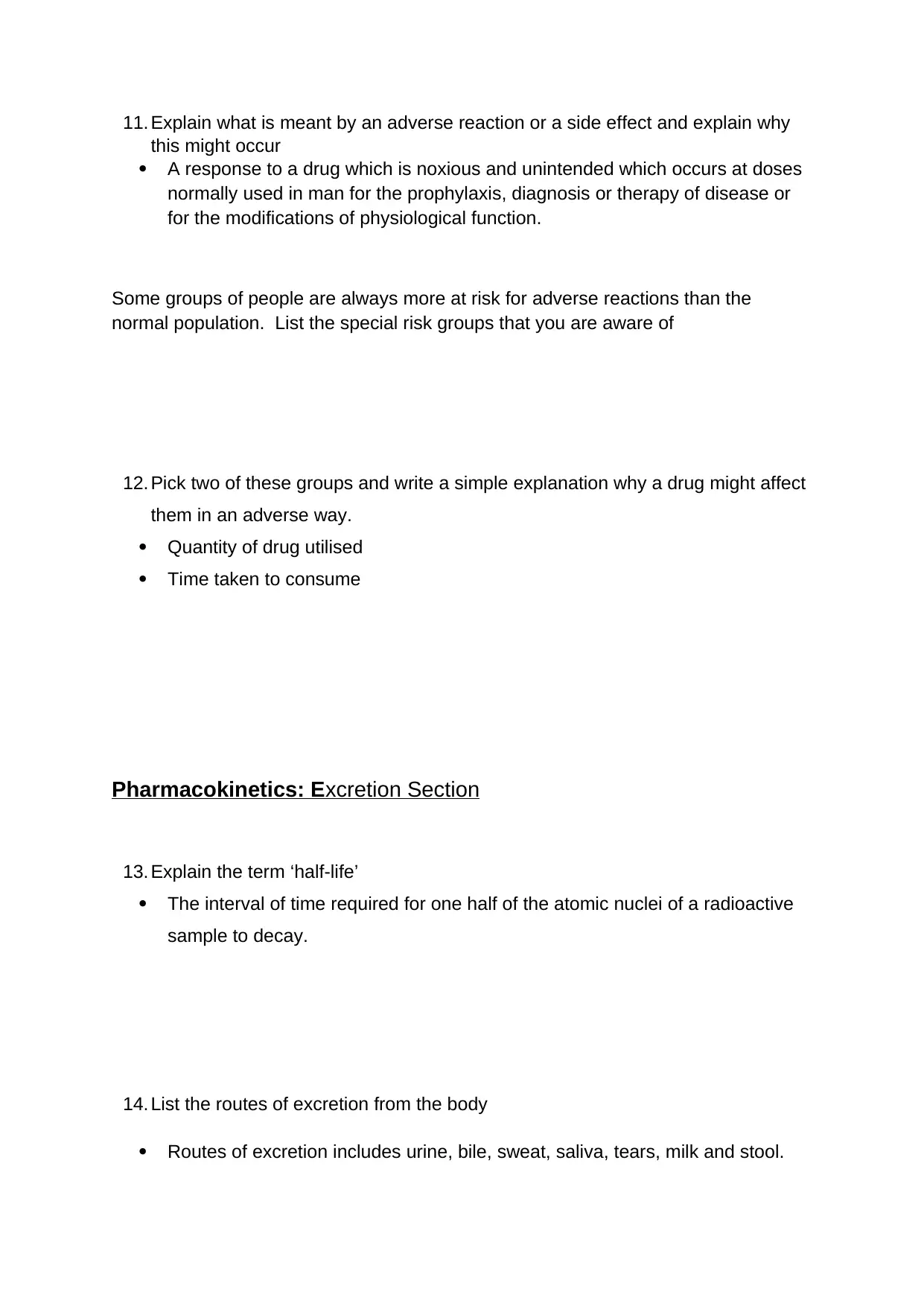
11. Explain what is meant by an adverse reaction or a side effect and explain why
this might occur
A response to a drug which is noxious and unintended which occurs at doses
normally used in man for the prophylaxis, diagnosis or therapy of disease or
for the modifications of physiological function.
Some groups of people are always more at risk for adverse reactions than the
normal population. List the special risk groups that you are aware of
12. Pick two of these groups and write a simple explanation why a drug might affect
them in an adverse way.
Quantity of drug utilised
Time taken to consume
Pharmacokinetics: Excretion Section
13. Explain the term ‘half-life’
The interval of time required for one half of the atomic nuclei of a radioactive
sample to decay.
14. List the routes of excretion from the body
Routes of excretion includes urine, bile, sweat, saliva, tears, milk and stool.
this might occur
A response to a drug which is noxious and unintended which occurs at doses
normally used in man for the prophylaxis, diagnosis or therapy of disease or
for the modifications of physiological function.
Some groups of people are always more at risk for adverse reactions than the
normal population. List the special risk groups that you are aware of
12. Pick two of these groups and write a simple explanation why a drug might affect
them in an adverse way.
Quantity of drug utilised
Time taken to consume
Pharmacokinetics: Excretion Section
13. Explain the term ‘half-life’
The interval of time required for one half of the atomic nuclei of a radioactive
sample to decay.
14. List the routes of excretion from the body
Routes of excretion includes urine, bile, sweat, saliva, tears, milk and stool.

Pharmacodynamics
In normal health, cells function in the body under the control of ‘feedback systems’ to
maintain healthy balance of activity. This is known as homeostasis. The overall
control of these mechanism is managed by the nervous system and chemicals which
can move around the body in the blood and interstitial fluid. In ill health, these
homeostatic mechanisms can be altered, and the balance disturbed leading to
illness. Drugs are designed to take advantage of these metabolic activities and they
fall into three main groups.
Source: https://www.healthmad.com/agonist-vs-antagonist-drugs/
Some drugs interfere with the normal function of a cell either by increasing
or decreasing the normal level of activity. This is usually mediated by a drug
which mimics a chemical which normally regulates the cell. This mimicking
chemical can bind to a receptor on the cell surface and either block the
normal chemical from binding to stimulate the cell, thereby reducing activity in
the cell. These are called antagonists or inhibitors. Others can enhance the
activity of the cell and are called agonists.
Some drugs do not affect the body cells but rather act against an invading
organism or rogue cells in the body.
In normal health, cells function in the body under the control of ‘feedback systems’ to
maintain healthy balance of activity. This is known as homeostasis. The overall
control of these mechanism is managed by the nervous system and chemicals which
can move around the body in the blood and interstitial fluid. In ill health, these
homeostatic mechanisms can be altered, and the balance disturbed leading to
illness. Drugs are designed to take advantage of these metabolic activities and they
fall into three main groups.
Source: https://www.healthmad.com/agonist-vs-antagonist-drugs/
Some drugs interfere with the normal function of a cell either by increasing
or decreasing the normal level of activity. This is usually mediated by a drug
which mimics a chemical which normally regulates the cell. This mimicking
chemical can bind to a receptor on the cell surface and either block the
normal chemical from binding to stimulate the cell, thereby reducing activity in
the cell. These are called antagonists or inhibitors. Others can enhance the
activity of the cell and are called agonists.
Some drugs do not affect the body cells but rather act against an invading
organism or rogue cells in the body.
Secure Best Marks with AI Grader
Need help grading? Try our AI Grader for instant feedback on your assignments.

And finally, some drugs replace something deficient in the body such as a
hormone or an enzyme.
15. Define the word ‘agonist’ and give an example of this type of drug from your
practice areas.
It is a drug that activates certain receptors in the brain. Examples are heroin,
oxycodone, methadone, opium and others.
16. Define the word ‘antagonist’ and give an example of this type of drug from your
practice.
It is a drug that blocks opioids by attaching to the opioid receptors without
activating them. Examples are naltrexone and naloxone.
17. Explain the term ‘desired/beneficial/therapeutic effect’ in pharmacology
The improvement of the bioavailability of a drug
18. Explain the term ‘side/adverse/toxic effect’ in pharmacology
Harmful and unpleasant reaction resulting from an intervention related to the
use of a medicinal product.
Drug tolerance and dependence
Tolerance
Tolerance occurs as the body adapts to a drug’s actions. Developing tolerance
means that more and more of a dose is needed in order to experience the original
effect or the desired effect.
hormone or an enzyme.
15. Define the word ‘agonist’ and give an example of this type of drug from your
practice areas.
It is a drug that activates certain receptors in the brain. Examples are heroin,
oxycodone, methadone, opium and others.
16. Define the word ‘antagonist’ and give an example of this type of drug from your
practice.
It is a drug that blocks opioids by attaching to the opioid receptors without
activating them. Examples are naltrexone and naloxone.
17. Explain the term ‘desired/beneficial/therapeutic effect’ in pharmacology
The improvement of the bioavailability of a drug
18. Explain the term ‘side/adverse/toxic effect’ in pharmacology
Harmful and unpleasant reaction resulting from an intervention related to the
use of a medicinal product.
Drug tolerance and dependence
Tolerance
Tolerance occurs as the body adapts to a drug’s actions. Developing tolerance
means that more and more of a dose is needed in order to experience the original
effect or the desired effect.

Dependence vs. addiction. Addiction is defined as not having control over doing,
taking or using something to the point where it could be harmful to you (NHS, 2015).
People may become ‘addicted’ to anything. Dependence is the preferred term for
use in the UK in relation to drugs (DHSC, 2017). The term ‘addiction’ has generally
been avoided except in relation to addiction psychiatry.
Drug dependence is considered as having two types: psychological and physical
dependence (BMA, 2001). Psychological is an emotional state of craving for a drug
which has a desired effect on the mind and whose absence has an undesired effect.
Physical dependence involves a physiological adaption to a drug and is
characterised by severe physical disturbances during abstinence i.e. withdrawal
symptoms.
Only certain drugs can produce dependence, and these are mostly mood-altering
drugs. These include opioids and nervous system stimulants including coffee and
nicotine.
taking or using something to the point where it could be harmful to you (NHS, 2015).
People may become ‘addicted’ to anything. Dependence is the preferred term for
use in the UK in relation to drugs (DHSC, 2017). The term ‘addiction’ has generally
been avoided except in relation to addiction psychiatry.
Drug dependence is considered as having two types: psychological and physical
dependence (BMA, 2001). Psychological is an emotional state of craving for a drug
which has a desired effect on the mind and whose absence has an undesired effect.
Physical dependence involves a physiological adaption to a drug and is
characterised by severe physical disturbances during abstinence i.e. withdrawal
symptoms.
Only certain drugs can produce dependence, and these are mostly mood-altering
drugs. These include opioids and nervous system stimulants including coffee and
nicotine.
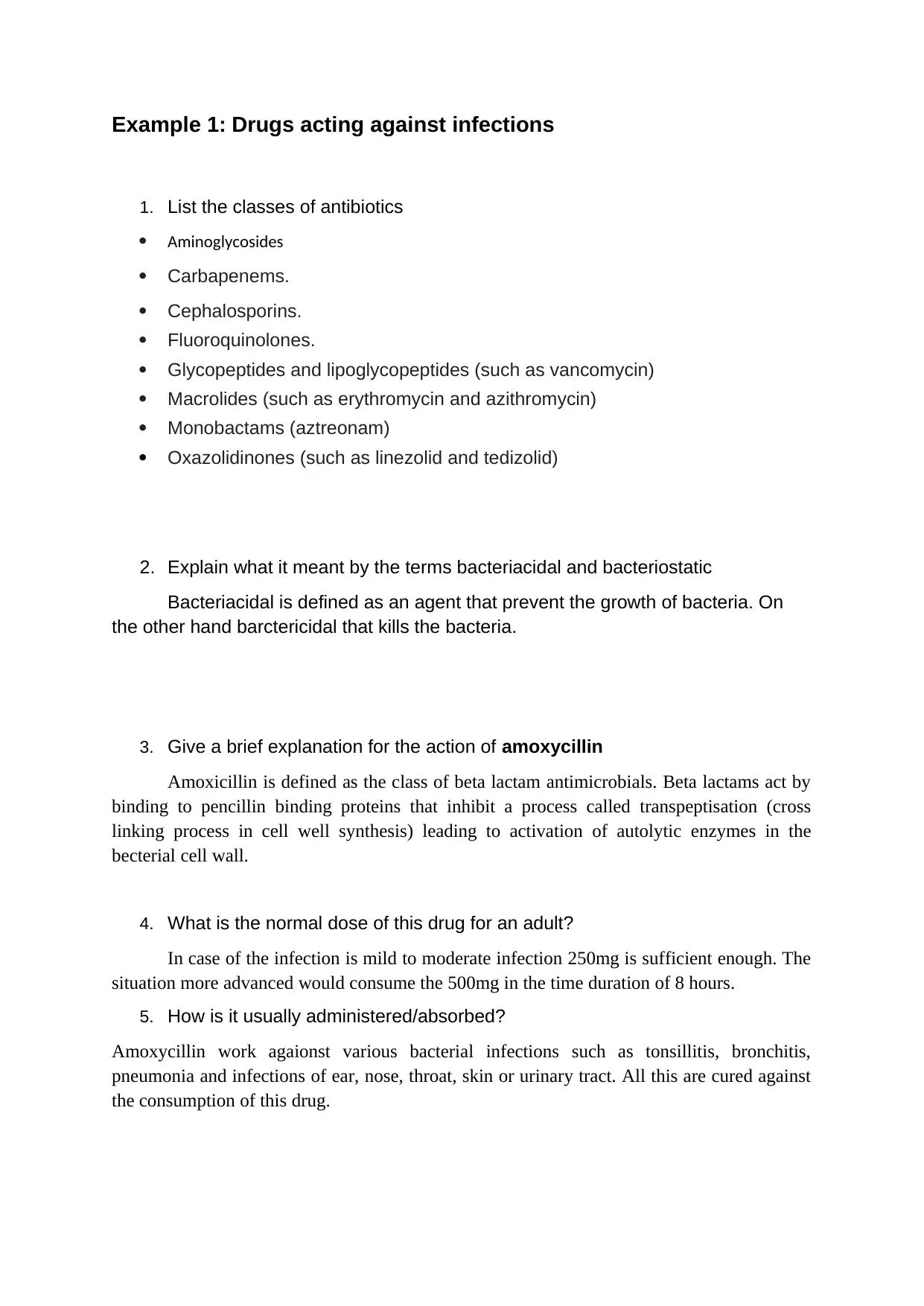
Example 1: Drugs acting against infections
1. List the classes of antibiotics
Aminoglycosides
Carbapenems.
Cephalosporins.
Fluoroquinolones.
Glycopeptides and lipoglycopeptides (such as vancomycin)
Macrolides (such as erythromycin and azithromycin)
Monobactams (aztreonam)
Oxazolidinones (such as linezolid and tedizolid)
2. Explain what it meant by the terms bacteriacidal and bacteriostatic
Bacteriacidal is defined as an agent that prevent the growth of bacteria. On
the other hand barctericidal that kills the bacteria.
3. Give a brief explanation for the action of amoxycillin
Amoxicillin is defined as the class of beta lactam antimicrobials. Beta lactams act by
binding to pencillin binding proteins that inhibit a process called transpeptisation (cross
linking process in cell well synthesis) leading to activation of autolytic enzymes in the
becterial cell wall.
4. What is the normal dose of this drug for an adult?
In case of the infection is mild to moderate infection 250mg is sufficient enough. The
situation more advanced would consume the 500mg in the time duration of 8 hours.
5. How is it usually administered/absorbed?
Amoxycillin work agaionst various bacterial infections such as tonsillitis, bronchitis,
pneumonia and infections of ear, nose, throat, skin or urinary tract. All this are cured against
the consumption of this drug.
1. List the classes of antibiotics
Aminoglycosides
Carbapenems.
Cephalosporins.
Fluoroquinolones.
Glycopeptides and lipoglycopeptides (such as vancomycin)
Macrolides (such as erythromycin and azithromycin)
Monobactams (aztreonam)
Oxazolidinones (such as linezolid and tedizolid)
2. Explain what it meant by the terms bacteriacidal and bacteriostatic
Bacteriacidal is defined as an agent that prevent the growth of bacteria. On
the other hand barctericidal that kills the bacteria.
3. Give a brief explanation for the action of amoxycillin
Amoxicillin is defined as the class of beta lactam antimicrobials. Beta lactams act by
binding to pencillin binding proteins that inhibit a process called transpeptisation (cross
linking process in cell well synthesis) leading to activation of autolytic enzymes in the
becterial cell wall.
4. What is the normal dose of this drug for an adult?
In case of the infection is mild to moderate infection 250mg is sufficient enough. The
situation more advanced would consume the 500mg in the time duration of 8 hours.
5. How is it usually administered/absorbed?
Amoxycillin work agaionst various bacterial infections such as tonsillitis, bronchitis,
pneumonia and infections of ear, nose, throat, skin or urinary tract. All this are cured against
the consumption of this drug.
Paraphrase This Document
Need a fresh take? Get an instant paraphrase of this document with our AI Paraphraser
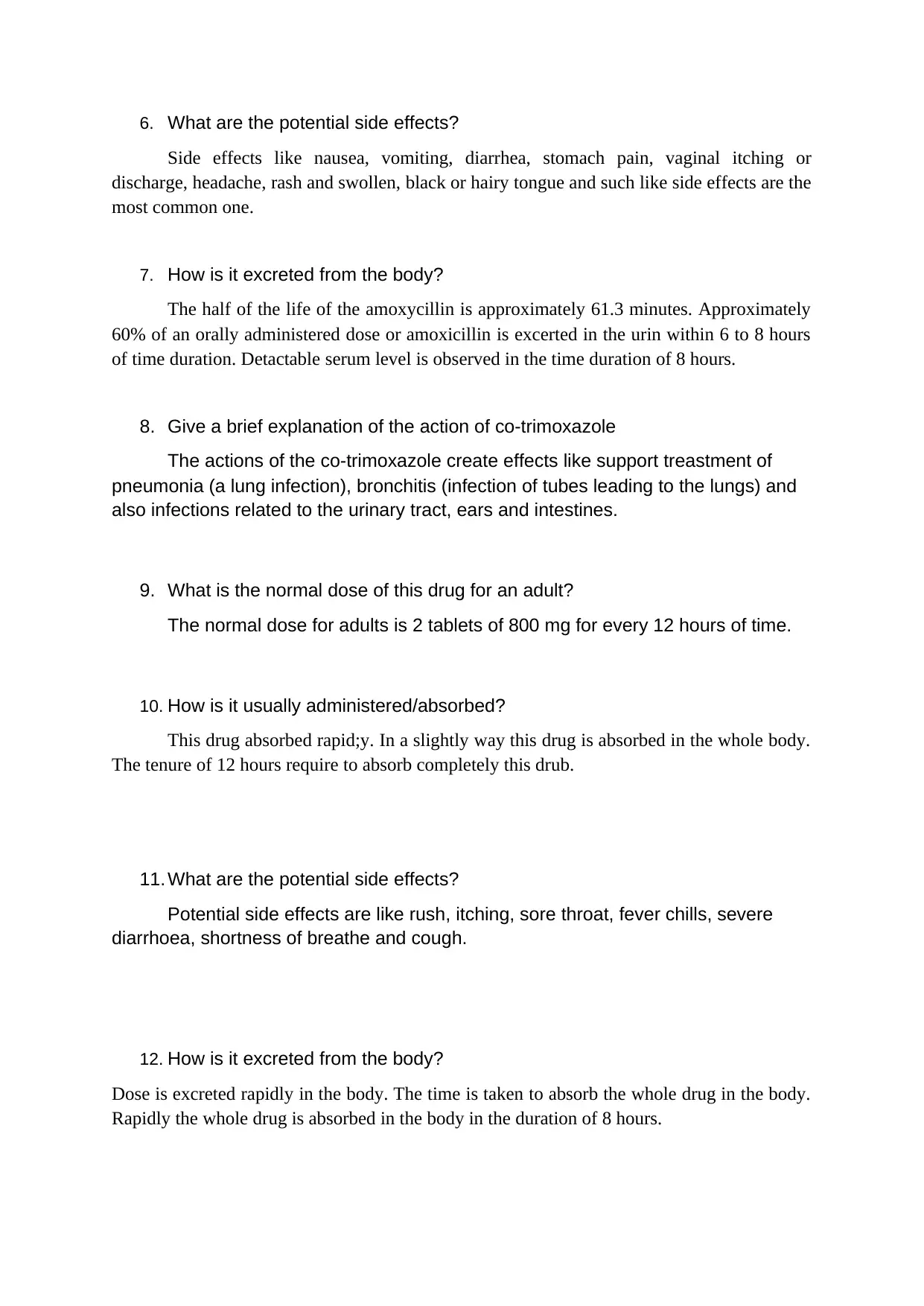
6. What are the potential side effects?
Side effects like nausea, vomiting, diarrhea, stomach pain, vaginal itching or
discharge, headache, rash and swollen, black or hairy tongue and such like side effects are the
most common one.
7. How is it excreted from the body?
The half of the life of the amoxycillin is approximately 61.3 minutes. Approximately
60% of an orally administered dose or amoxicillin is excerted in the urin within 6 to 8 hours
of time duration. Detactable serum level is observed in the time duration of 8 hours.
8. Give a brief explanation of the action of co-trimoxazole
The actions of the co-trimoxazole create effects like support treastment of
pneumonia (a lung infection), bronchitis (infection of tubes leading to the lungs) and
also infections related to the urinary tract, ears and intestines.
9. What is the normal dose of this drug for an adult?
The normal dose for adults is 2 tablets of 800 mg for every 12 hours of time.
10. How is it usually administered/absorbed?
This drug absorbed rapid;y. In a slightly way this drug is absorbed in the whole body.
The tenure of 12 hours require to absorb completely this drub.
11. What are the potential side effects?
Potential side effects are like rush, itching, sore throat, fever chills, severe
diarrhoea, shortness of breathe and cough.
12. How is it excreted from the body?
Dose is excreted rapidly in the body. The time is taken to absorb the whole drug in the body.
Rapidly the whole drug is absorbed in the body in the duration of 8 hours.
Side effects like nausea, vomiting, diarrhea, stomach pain, vaginal itching or
discharge, headache, rash and swollen, black or hairy tongue and such like side effects are the
most common one.
7. How is it excreted from the body?
The half of the life of the amoxycillin is approximately 61.3 minutes. Approximately
60% of an orally administered dose or amoxicillin is excerted in the urin within 6 to 8 hours
of time duration. Detactable serum level is observed in the time duration of 8 hours.
8. Give a brief explanation of the action of co-trimoxazole
The actions of the co-trimoxazole create effects like support treastment of
pneumonia (a lung infection), bronchitis (infection of tubes leading to the lungs) and
also infections related to the urinary tract, ears and intestines.
9. What is the normal dose of this drug for an adult?
The normal dose for adults is 2 tablets of 800 mg for every 12 hours of time.
10. How is it usually administered/absorbed?
This drug absorbed rapid;y. In a slightly way this drug is absorbed in the whole body.
The tenure of 12 hours require to absorb completely this drub.
11. What are the potential side effects?
Potential side effects are like rush, itching, sore throat, fever chills, severe
diarrhoea, shortness of breathe and cough.
12. How is it excreted from the body?
Dose is excreted rapidly in the body. The time is taken to absorb the whole drug in the body.
Rapidly the whole drug is absorbed in the body in the duration of 8 hours.

Example 2: Non-Steroidal Anti-Inflammatory Drugs (NSAIDS)
1. Ibuprofen is an example of a NSAID. Describe how NSAID’s work
NSAID work by preventing an enzyme through doing its job. Further, the enzyme is called
cyclo-oxygenase has two forms which protect the stomach lining from harsh acids and
digestive chemicals. s
1. What are the common potential side effects of NSAIDs?
Indigestion
Stomach ulcers
Headaches
Drowsiness
Dizziness
allergic reaction
2. State the normal dose for an adult for Ibuprofen
200 mg orally every 4 to 6 hours
may increase to 400 mg orally every 4 to 6 hours as needed
3. Can ibuprofen be used in children? From what age?
Yes, ibuprofen can be used for children at the age of 3 months in the form of syrup while
from age of 7 years, they can take chewable tablets
4. What is a common side effect of ibuprofen?
Feeling and being sick
Stomach pain
Feeling tired and sleepy
Blood in vomit
Ringing in ears
Difficulty in breathing
5. . How is long does it take for the onset of effect? How long is it effective for?
1. Ibuprofen is an example of a NSAID. Describe how NSAID’s work
NSAID work by preventing an enzyme through doing its job. Further, the enzyme is called
cyclo-oxygenase has two forms which protect the stomach lining from harsh acids and
digestive chemicals. s
1. What are the common potential side effects of NSAIDs?
Indigestion
Stomach ulcers
Headaches
Drowsiness
Dizziness
allergic reaction
2. State the normal dose for an adult for Ibuprofen
200 mg orally every 4 to 6 hours
may increase to 400 mg orally every 4 to 6 hours as needed
3. Can ibuprofen be used in children? From what age?
Yes, ibuprofen can be used for children at the age of 3 months in the form of syrup while
from age of 7 years, they can take chewable tablets
4. What is a common side effect of ibuprofen?
Feeling and being sick
Stomach pain
Feeling tired and sleepy
Blood in vomit
Ringing in ears
Difficulty in breathing
5. . How is long does it take for the onset of effect? How long is it effective for?
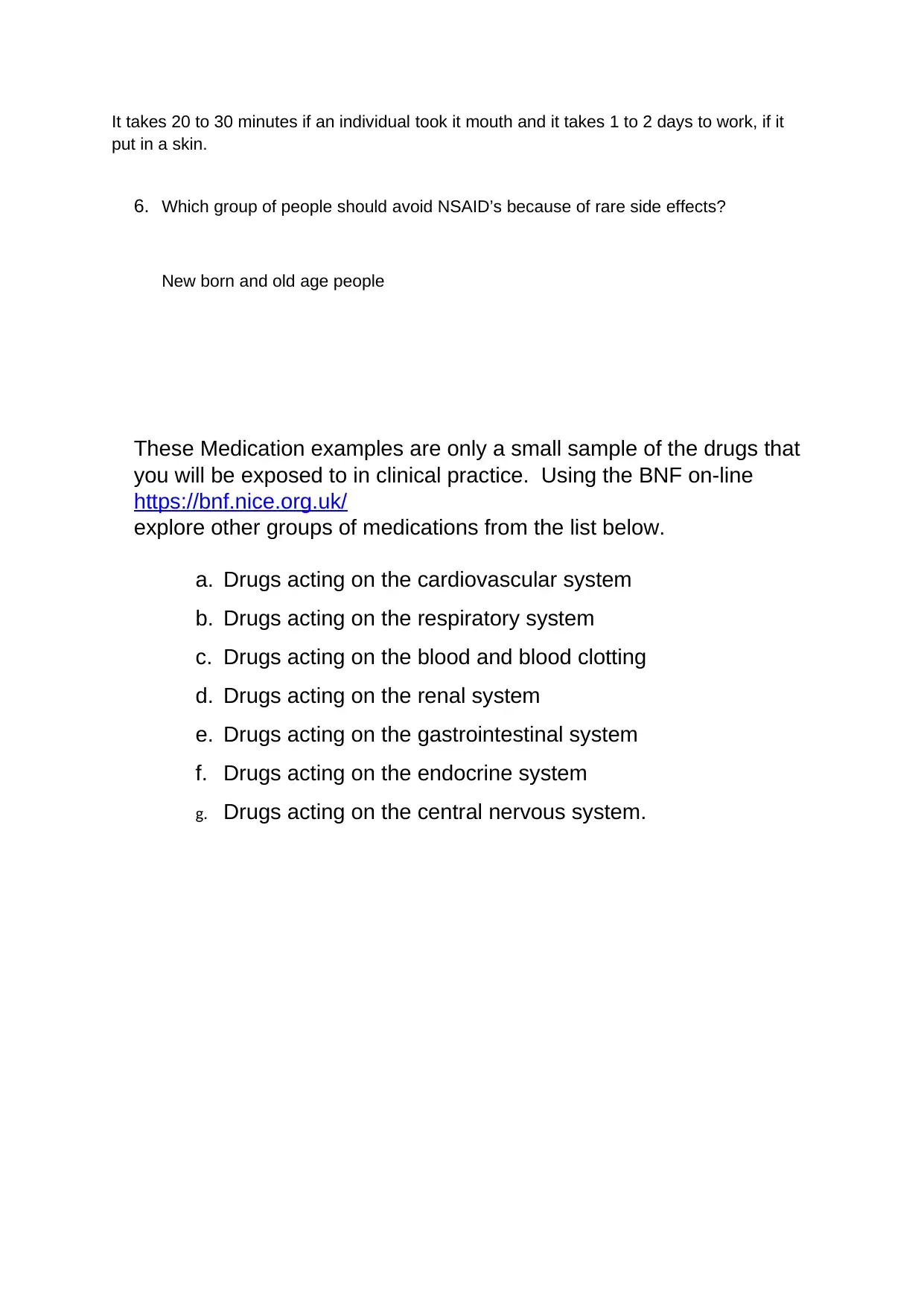
It takes 20 to 30 minutes if an individual took it mouth and it takes 1 to 2 days to work, if it
put in a skin.
6. Which group of people should avoid NSAID’s because of rare side effects?
New born and old age people
These Medication examples are only a small sample of the drugs that
you will be exposed to in clinical practice. Using the BNF on-line
https://bnf.nice.org.uk/
explore other groups of medications from the list below.
a. Drugs acting on the cardiovascular system
b. Drugs acting on the respiratory system
c. Drugs acting on the blood and blood clotting
d. Drugs acting on the renal system
e. Drugs acting on the gastrointestinal system
f. Drugs acting on the endocrine system
g. Drugs acting on the central nervous system.
put in a skin.
6. Which group of people should avoid NSAID’s because of rare side effects?
New born and old age people
These Medication examples are only a small sample of the drugs that
you will be exposed to in clinical practice. Using the BNF on-line
https://bnf.nice.org.uk/
explore other groups of medications from the list below.
a. Drugs acting on the cardiovascular system
b. Drugs acting on the respiratory system
c. Drugs acting on the blood and blood clotting
d. Drugs acting on the renal system
e. Drugs acting on the gastrointestinal system
f. Drugs acting on the endocrine system
g. Drugs acting on the central nervous system.
Secure Best Marks with AI Grader
Need help grading? Try our AI Grader for instant feedback on your assignments.

1 out of 89
Related Documents
Your All-in-One AI-Powered Toolkit for Academic Success.
+13062052269
info@desklib.com
Available 24*7 on WhatsApp / Email
![[object Object]](/_next/static/media/star-bottom.7253800d.svg)
Unlock your academic potential
© 2024 | Zucol Services PVT LTD | All rights reserved.



